I can’t stop talking about Iguazu Falls.
I’ve been blessed to have experienced hundreds of spectacular landscapes over my past 12 years of travel. The downside of this, of course, is that it now takes a hell of a lot to impress me. Subsequently, I wasn’t expecting to be blown away by Iguazu Falls. I must have seen over a hundred different waterfalls at this stage in my life. What could be so special about this one?
I must have been tempting the universe with my dismissiveness, because I came away from Iguazu Falls naming it one of the most amazing things I had ever seen. That was unexpected. My jaw was permanently agape as I walked from viewpoint to viewpoint, marvelling at the sheer size of the falls and the power of nature. It was like nothing I’d ever seen before.
There’s a famous quote about Iguazu Falls, uttered by Eleanor Roosevelt, when she first set sight on their majesty.
“My poor Niagara,” she exclaimed; dismayed by the discovery that Niagara Falls had nothing on Iguazu.
It’s no surprise that she came to this conclusion. Iguazu Falls is twice as tall as Niagara Falls and three times as wide. It’s wider, too, than Africa’s Victoria Falls. Comprising a whopping 275 individual waterfalls and stretching for almost two miles in length, Iguazu is easily one of the most impressive water-based landscapes that you could ever see.
And I’m here today to show you how to make the most of your time at Iguazu Falls.
I learned so much from my time at the waterfalls. I made several mistakes, sure, but I also managed to have one of the most incredible experiences of my life. By taking some very specific steps during my visit, I found myself one of the most impressive viewpoints of the waterfalls with nobody else around. I had them all to myself!
It was amazing — and I want to make sure you can have that experience, too.
This is going to be a long old article — I’ve got facts, I’ve got figures, I’ve got a dramatic story about a violent speedboat ride — as I want to cover absolutely everything you could possibly need to know about visiting the falls. Let’s get started.
Note: Because Argentina’s currency experiences wild fluctuations on a daily basis, I’ve chosen not to give prices in pesos, but to instead share the equivalent amount I paid in USD. That way, the prices within the article will remain accurate.
Where is Iguazu Falls?
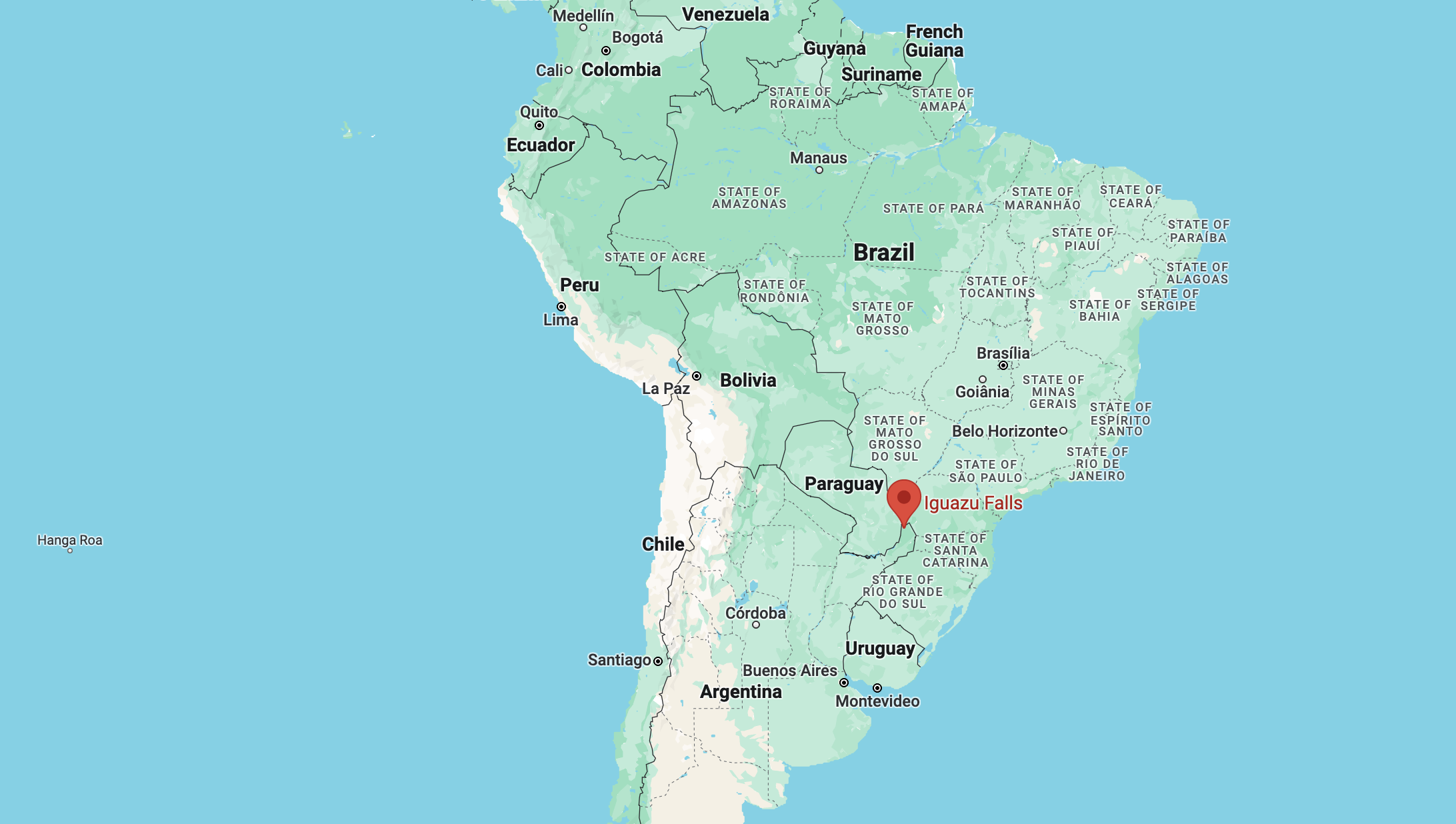
Iguazu Falls is located in the northeast of Argentina and the south of Brazil; 80% of the waterfalls are found on the Argentinian side, while Brazil is home to just 20% of them. Most people visit the waterfalls in both countries, as they each offer different perspectives, viewpoints, and experiences.
While the waterfalls don’t quite extend into Paraguay, they’re only a few miles from the tripoint border: the spot where Argentina, Brazil, and Paraguay meet.
How Do You Get to Iguazu Falls?
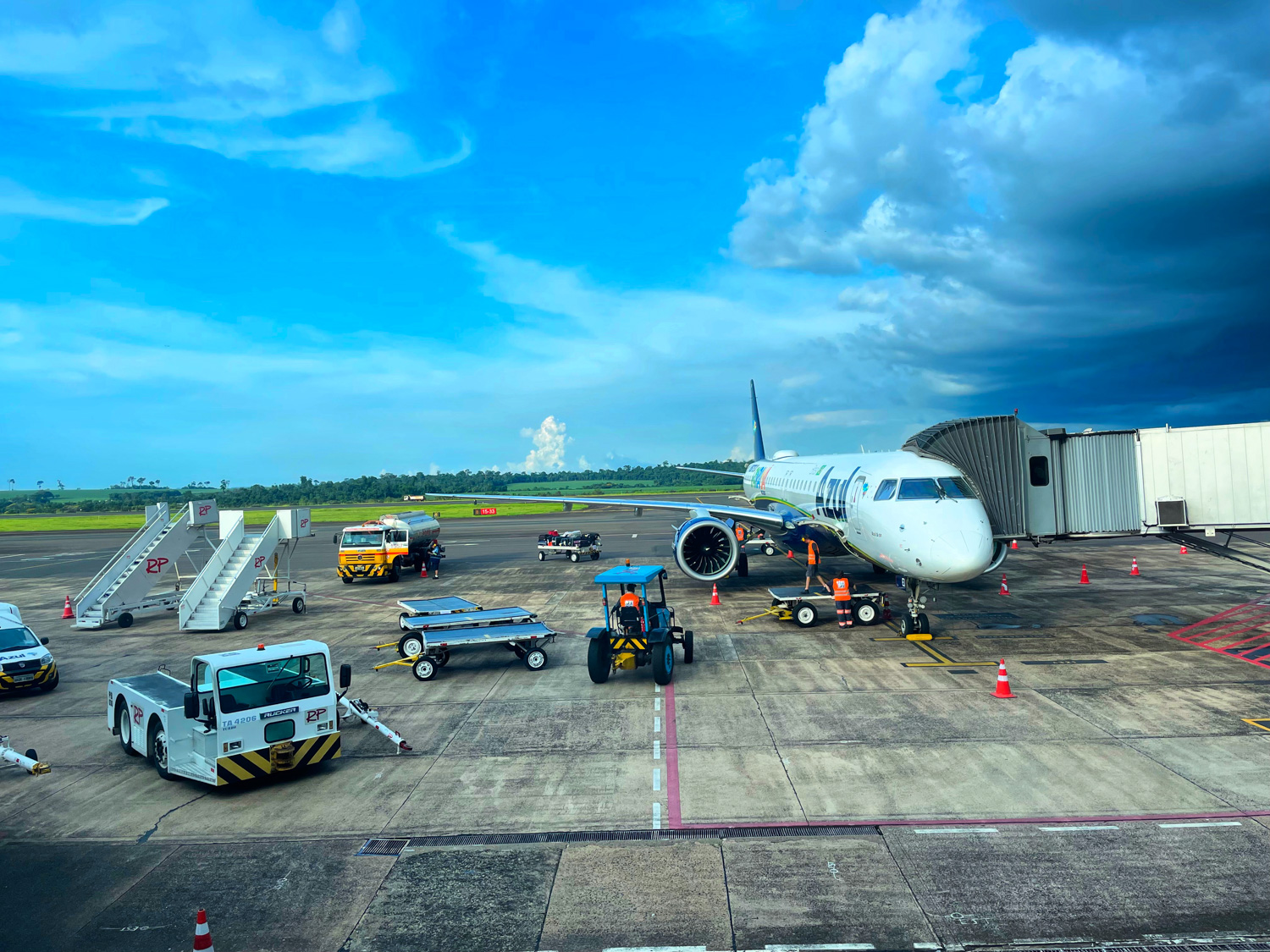
Luckily, there’s airports on both sides of the border, which makes getting to Iguazu a breeze.
- The Argentinian airport is located in Puerto Iguazu and is called Cataratas del Iguazú International Airport (IGR). The airport is 10 km (6 miles) from the Argentinian entrance to Iguazu Falls.
- The Brazilian airport is located in Foz do Iguaçu and is called Foz do Iguaçu/Cataratas International Airport (IGU). The airport is just 3 km (2 miles) from the Brazilian entrance to Iguazu Falls.
It’s important to note that you can only fly to either airport from the country it’s located in. As in, you couldn’t fly from Buenos Aires to the Brazilian airport; you could only fly to the Argentinian side.
Flights depart regularly throughout the day. In Argentina, there’s around a dozen direct flights from Buenos Aires to Iguazu Falls each day, with the flight taking just under two hours. It’s usually priced at around $70.
In Brazil, it’s much the same. There’s a handful of direct flights each day from Rio de Janeiro and Sao Paulo. Flight time is two hours from Rio and 90 minutes from Sao Paolo. Again, flights are usually around $70.
Of course, you could also opt to go overland to Iguazu Falls if you’re won’t be travelling from Buenos Aires or Rio — buses travel from all over Argentina, Brazil, and Paraguay to the waterfalls.
Just keep in mind those vast South American distances. A bus from Buenos Aires to Iguazu Falls takes 19 hours and can cost as much as $100 — more than taking a flight! Overland travel isn’t necessarily going to be the cheapest option here.
I was already in Buenos Aires, so that made my decision easy. I flew out on a late night flight to Puerto Iguazu and landed at midnight. The following morning, I was up early to head to the park.
How Much Does it Cost to Visit Iguazu?

The two sides of the park are run separately, so if you want to visit both sides of Iguazu Falls, you’ll need to pay two sets of entrance fees.
It costs $24 to enter the Argentinian side, with children under the age of 16 paying $12. Under 6s go free.
It costs $20 to enter the Brazilian side, with children under the age of 6 going free.
You can pay with both cash and card on both sides of the waterfalls.
Amazingly, people with disabilities (and the person accompanying them) get to enter Iguazu Falls free of charge! Almost all of the paths on both sides of the falls are well-paved and accessible by wheelchair, so that’s a double bonus.
Trust me: the experience is 100% worth the entrance fees, so if you’re unsure if the price is too high, it’s not. This is one of the coolest travel experiences I’ve ever had and I can assure you that you won’t regret spending money on it.
Which Side of the Falls Should You Visit First?
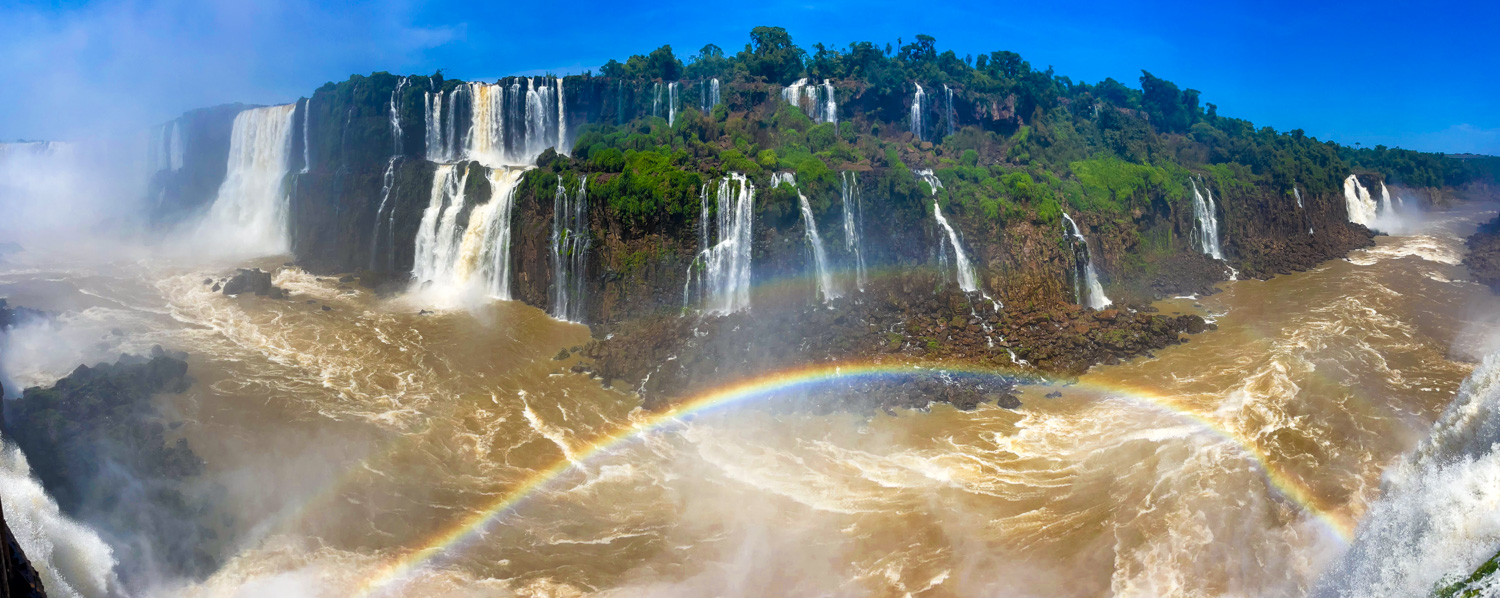
I visited the Argentinian side first, simply because I was in Buenos Aires beforehand. If you’re already travelling in South America, or have your itinerary planned out, that will make your decision for you. You’ll choose based on whether you’ll be coming from Argentina or Brazil.
But if you haven’t finalised your plans yet? I don’t think it makes an enormous difference either way, especially as the Devil’s Throat in Argentina is closed for 2024 (more on that below!)
I personally enjoyed visiting the Argentinian side first.
In Argentina, you’ll get to observe the waterfalls from multiple vantage points and gain a better understanding of just how vast the Iguazu complex is. You’ll walk on top of the waterfalls on one trail and then approach them from afar on another; it’s all about the aerial views here. In Brazil, there’s just one short walkway, but it does lead to the best viewpoint in the park.
In Argentina, with the Devil’s Throat closed, the walkways don’t bring you particularly close to the waterfalls and you’re above them for most of the time. In contrast, in Brazil, you get to come within metres of the cascades, standing at their base and getting sprayed by mist from all angles. I felt like I experienced the power of Iguazu in Brazil, whereas I was wowed by dramatic views in Argentina.
I also spent seven hours exploring the Argentinian side and just 90 minutes[!] in Brazil.
That’s why, if I had to choose, I’d say visit Argentina first. The Brazilian experience, of getting up close to the waterfalls and being drenched by them, makes for the perfect dramatic finale. You could be disappointed to experience that first and then head into Argentina and stay perfectly dry.
How Many Days Should You Spend at Iguazu Falls?
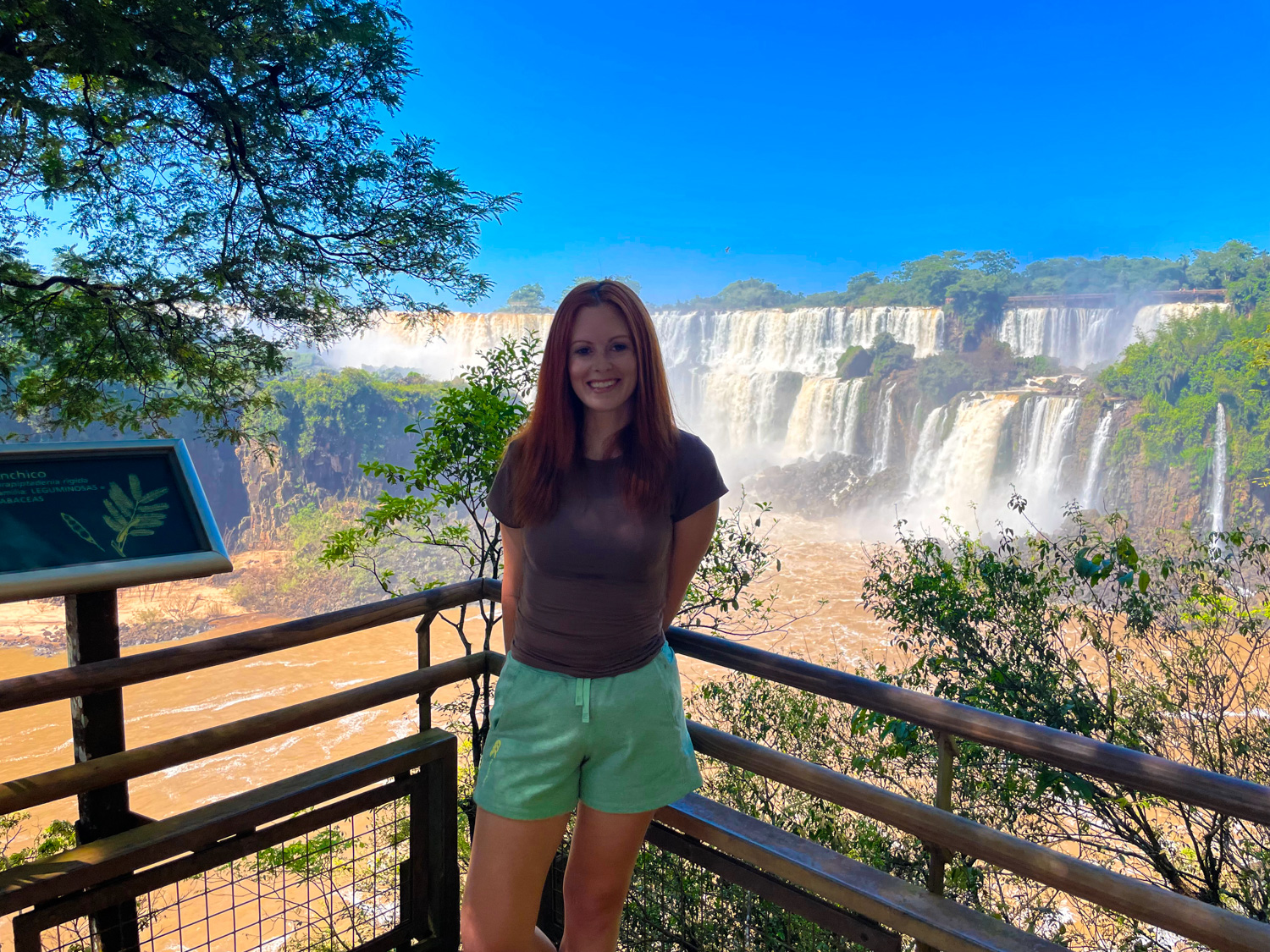
Two days is the perfect amount of time to spend at Iguazu Falls.
I saw absolutely everything I wanted to during my two days, so with a third day in town, I’m not quite sure what I would have done. That is, beyond reentering the park and looking at the same waterfalls for a second time.
You’ll want to spend a full day on the Argentinian side. With that amount of time, you can walk the upper trail and lower trail, stroll along the sedate Green Trail, ride the train a couple of times, and take a speedboat up to the falls. At sunset, you could venture out to the tripoint to see where Argentina, Brazil, and Paraguay meet. And if you time your visit with a full moon, you’ll be able to return to the park at night to see the waterfalls lit by its glow.
On your second day, you can cross the border into Brazil and still make it to the park’s entrance by opening time. The Brazilian side is much smaller, so you don’t need more than half a day to see it all, even if you’re opting for the speedboat. If you wanted to take a helicopter over the falls, you could comfortably fit that into the afternoon, while the adjacent Bird Park only requires an additional hour to explore.
And, well, that’s it. During those two days, you’ll have seen all the viewpoints and had all the experiences.
My Detailed Two-Day Iguazu Falls Itinerary
A small amount of research has the power to completely transform your experience at Iguazu Falls.
As I mentioned at the start of this article, I was lucky enough to find myself at a popular viewpoint without a single other person around.
Several hours later, there were dozens upon dozens of people standing in that same spot, struggling to take a crowd-free photo. Had that been my experience, I don’t think I would have found it quite so special.
To ensure you get the same experience as me, I’m going to be sharing every single detail of how you can rock your trip to Iguazu Falls.
Let’s start with how to get from Puerto Iguazu to the Argentinian entrance of Iguazu Falls.
How to Get to Iguazu Falls From Puerto Iguazu
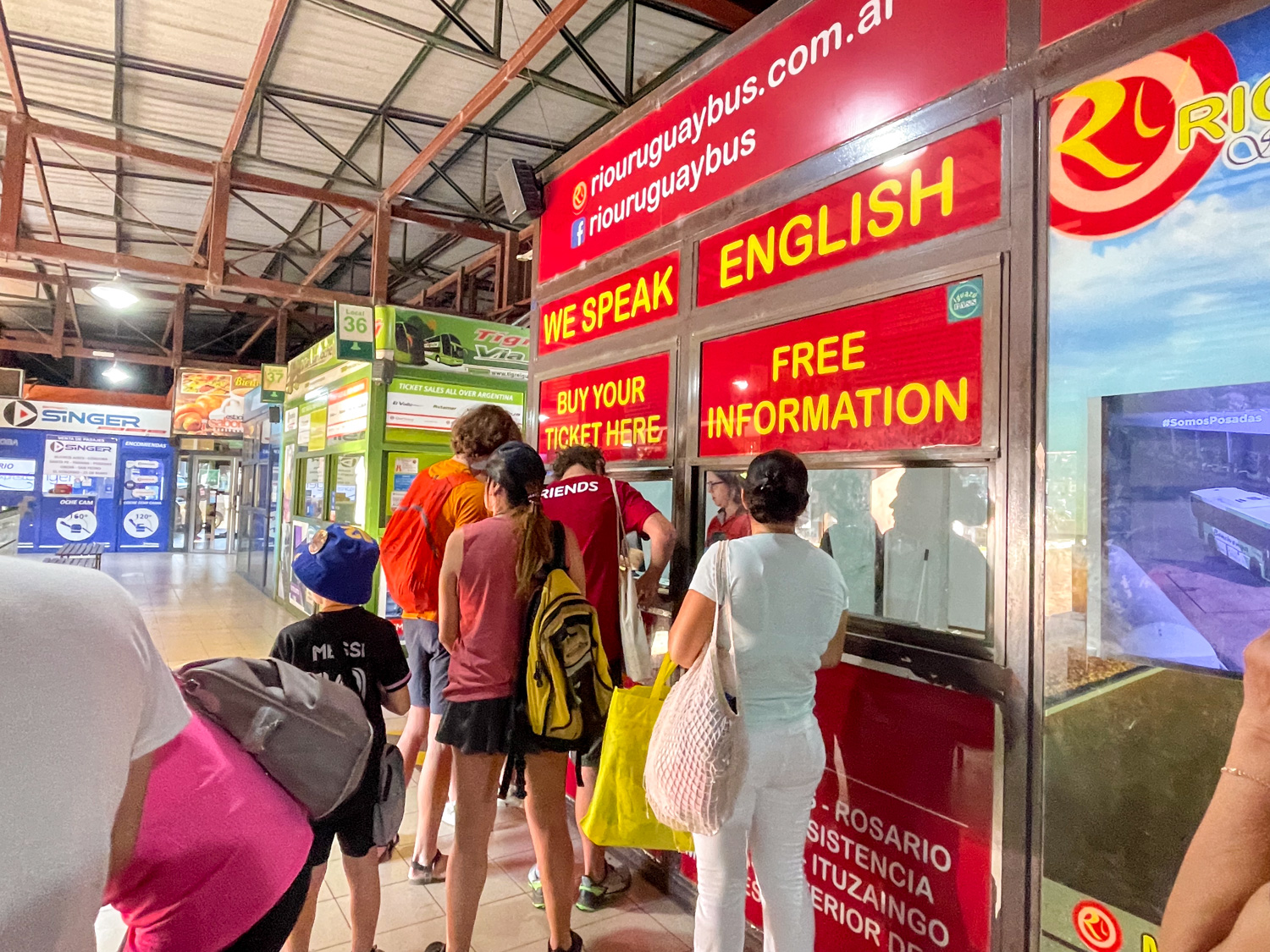
The Argentinian entrance to Iguazu Falls opens at 8 a.m. and ideally, you want to be at the entrance to the park before this time.
Buses run from Puerto Iguazu station to the falls every half an hour, so that means you want to be aiming for the 7:30 a.m. bus at the latest. To give yourself plenty of wiggle-room, aim to be buying your ticket from the Rio Uruguay ticket window by 7:10. The bus station is located in the heart of town, so I’d be surprised if it was more than a 10-minute walk from your accommodation.
Buying a ticket was super-simple — just ask for a return ticket to the waterfalls — as all of the staff speak English and know what you’re there for. I paid roughly $1.80 for the return ticket.
From the ticket office, cross over the bridge to the station platforms and find a bench to sit on while you wait for the bus to arrive.
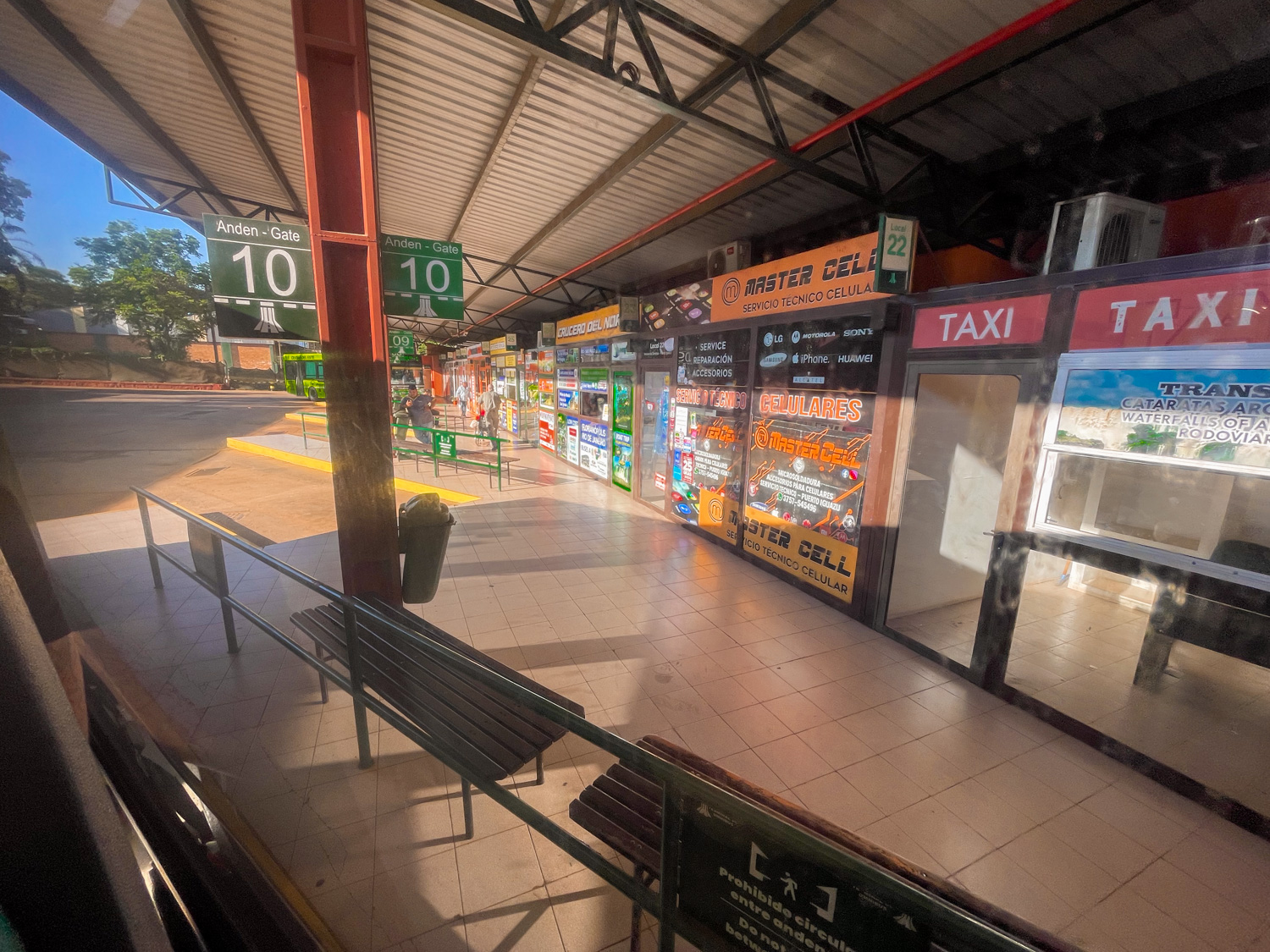
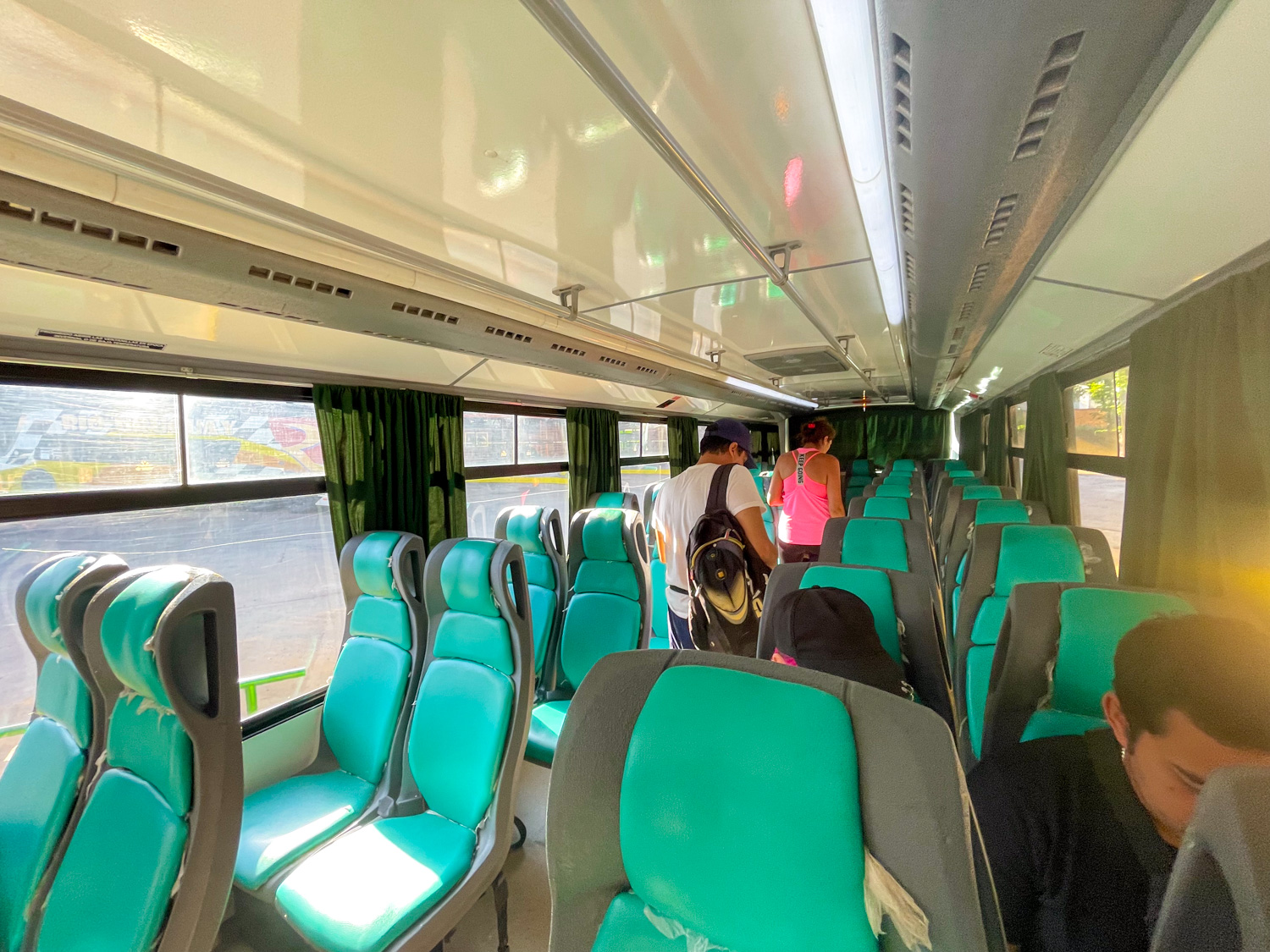
Given that it’s so easy and inexpensive to take the bus, I don’t see the point in taking a taxi instead.
Especially there are no ride-sharing apps operating in Puerto Iguazu, so you can’t take an Uber or Cabify to the falls.
There are plenty of taxi services at the bus station — you can see some in my photo above — and drivers hanging around on the main street in town, so you still won’t struggle to find somebody. You can expect to pay the equivalent of around $20 for the 30-minute journey.
Should You Buy Your Iguazu Falls Ticket Online?
You can buy tickets to Iguazu Falls at the park entrance on the Argentinian side, so there’s no real need to buy them online — it’s the same price whether you book in advance or turn up on the day. Ticket numbers aren’t limited, so they won’t sell out, either.
If, however, you would prefer peace of mind, or don’t want to waste time queueing at the entrance, buy your tickets from the official website. You’ll have to choose a time slot when you pay, so make sure you select the earliest one.
And just a quick note here, so that you can learn from my mistake.
If you’ve bought your Iguazu Falls ticket online — as I did — make sure to download the ticket on to your phone and take a screenshot so you’ll easily have offline access to it.
Because.
I arrived at the entrance to the park and discovered, to my horror, that I didn’t have service on my phone! There also wasn’t free Wi-Fi at the entrance. And so, I couldn’t click the attachment in my email to download my ticket. Weirdly, I had downloaded it the night before, but it hadn’t saved anywhere on my phone.
There really wasn’t anything I could do.
And so, I had to buy a second ticket! Sigh. So make sure you have offline access to your ticket if you do buy yours in advance.
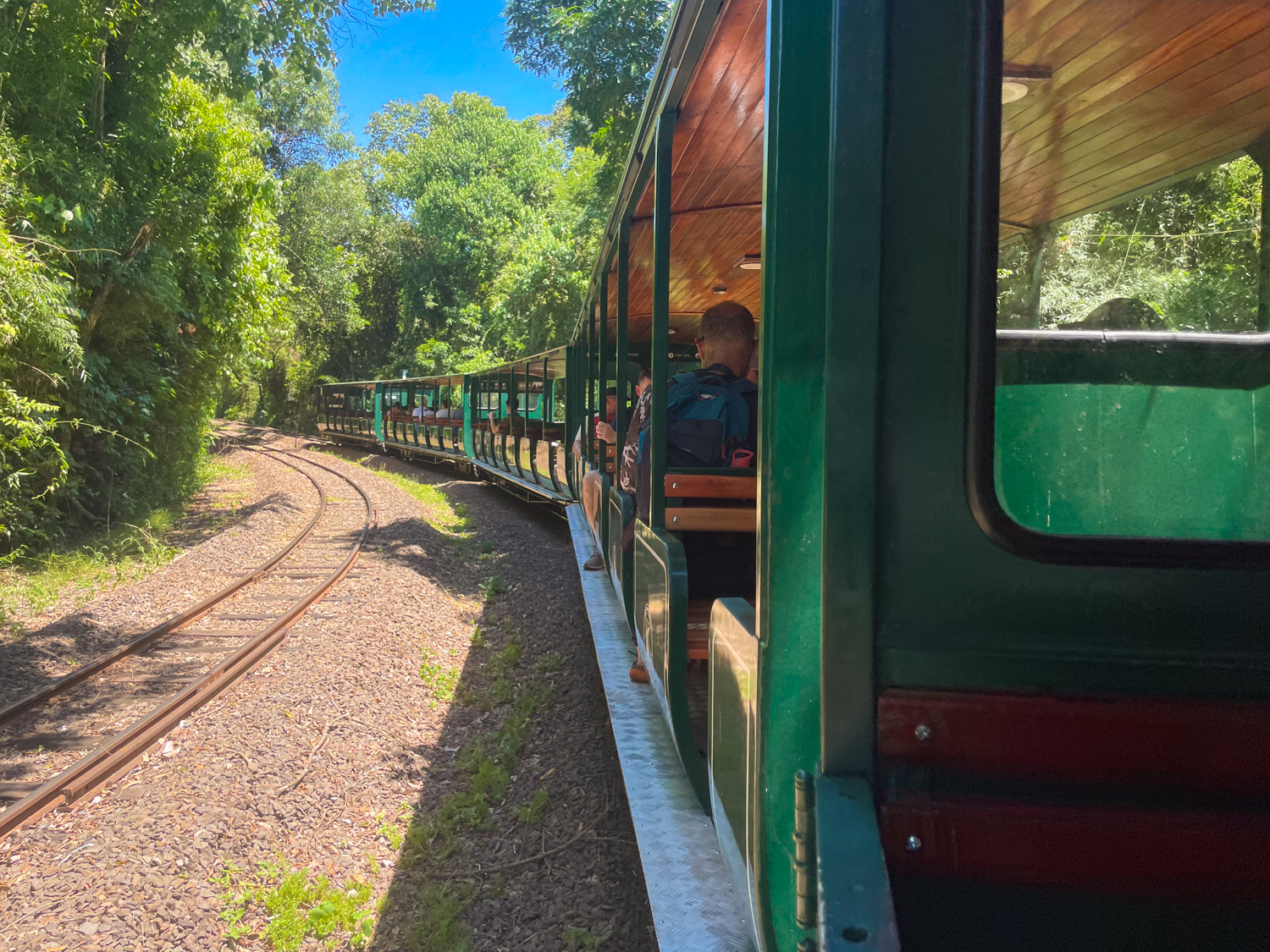
How to See Iguazu Falls (Argentina) Without the Crowds
Now, the Argentinian side of Iguazu Falls has three main components: the upper path, the lower path, and the Devil’s Throat.
The most popular part of the park is the Devil’s Throat, so you’d typically want to head there first.
However, back in late-2023, there was an unseasonable amount of heavy rain, and it resulted in extensive damage to the boardwalk and viewing platform — it’s now completely inaccessible. It’s kind of devastating, because so many visitors name the Devil’s Throat as the highlight of their entire Iguazu experience. Alas! You cannot control nature, and in fact, witnessing nature’s power is exactly why you travelled all the way here — you can’t then complain about it being too powerful!
When will the Devil’s Throat reopen? Current estimates are late-2024 at the earliest. I know — it sucks.
Because of this, I’m not going to write about the Devil’s Throat in this guide. Once it’s reopened, I’ll come back and update the article. Until then, let me share how you can make the most of the unexpected closure. Trust me, you’ll still come away with your mind blown from the waterfalls.
(So yes, it absolutely is still worth visiting Iguazu Falls if the Devil’s Throat is closed!)
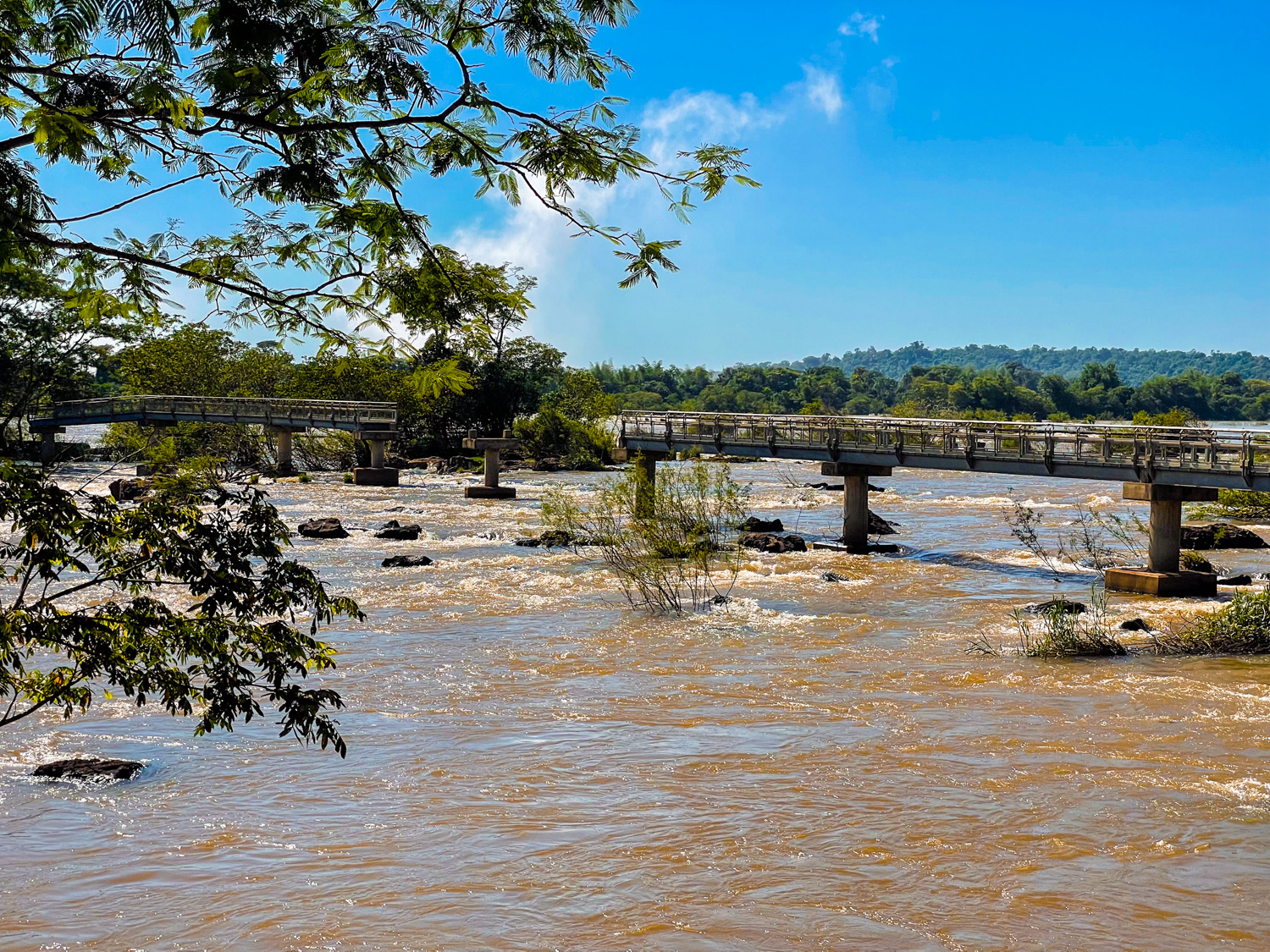
The most popular trail in the park in 2024, then, is now the upper path, so you’re going to want to head there first. And the fastest way to do so is by taking the train.
As soon as you enter the park, you’ll see a counter for picking up train tickets. The price of the train is included in your entrance fee, so you won’t have to pay anything extra, but you do need a ticket to board. Simply ask for one at the counter then walk straight ahead to the “Estacion Central” building.
Because you’ve (hopefully!) entered the park as soon as it opened, you’re now going to be able to board the first train of the day. This will ensure that there’s only around 50 people on the popular upper path at the same time as you — as opposed to 5,000 later on in the day. Take a seat in the first carriage of the train, too, to ensure you’re first off when you arrive.
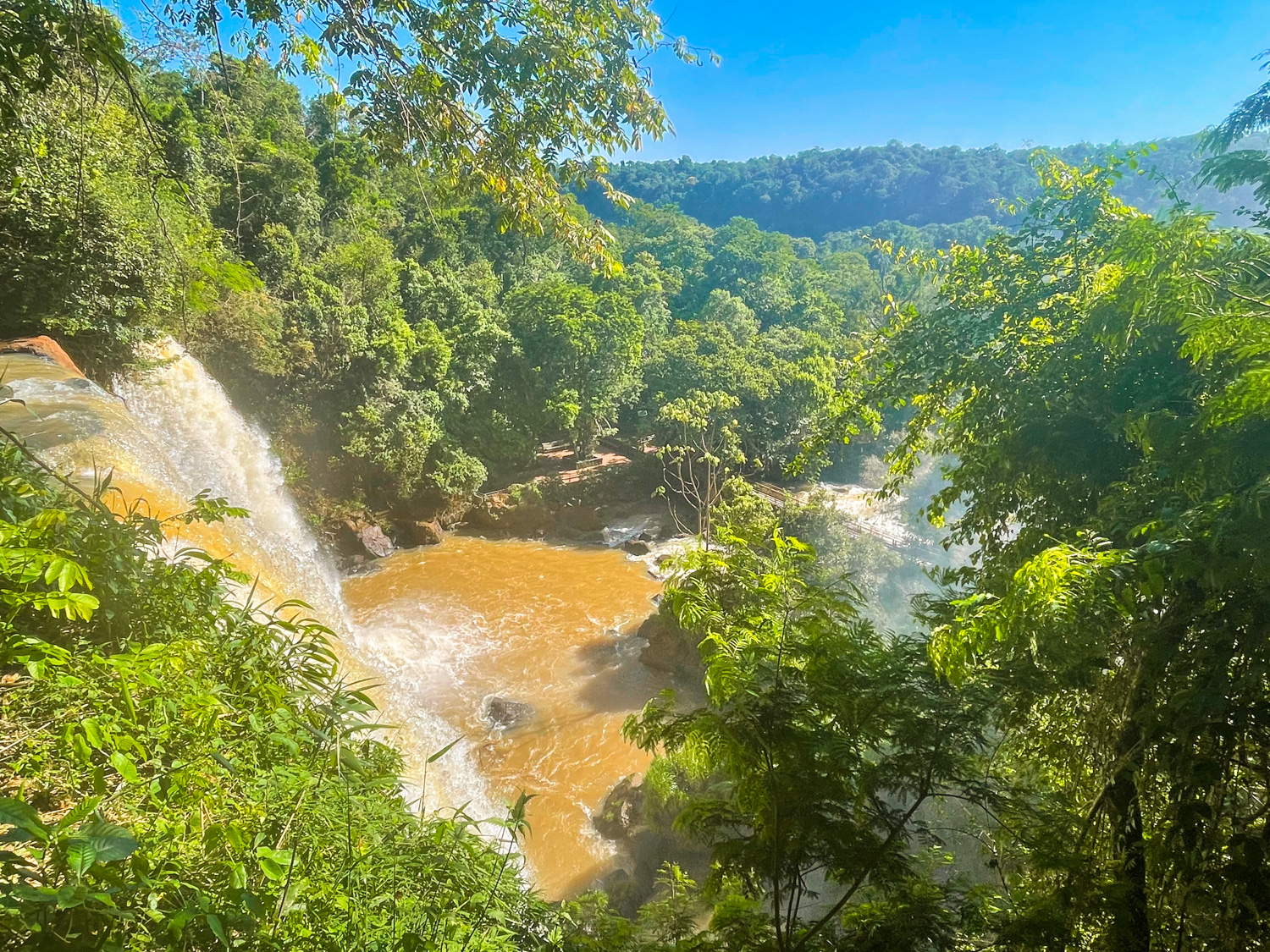
Once you disembark from the train, there’s only one path to follow, so stride purposefully in that direction, leaving the fidgeters behind in your wake.
The first turn-off you’ll encounter is for the upper path, which is labelled “Paseo Superior” — that’s the one you want to take.
Now I’m going to advise something rather controversial here: I recommend skipping the first viewpoint, which is for the waterfall that’s pictured above. In fact, I recommend racing past.
The main reason is that everybody lingers in this spot. It’s their first glimpse of a waterfall, after all, so of course they’re going to stop to admire it. Still, it absolutely pales in comparison to what you’re about to see.
And so, I recommend hurrying past that first viewpoint and walking straight to the next one. If you time it correctly — entering the park at opening time, boarding the first train, skipping the first viewpoint — you should now have the panoramic views of Iguazu Falls all to yourself.
I couldn’t believe I managed to pull it off, and it was one of the most magical moments of my life. To be able to stand and witness the power of nature and have no other humans around for a solid five minutes? I don’t think there’s many visitors to Iguazu Falls who can say they experienced that.
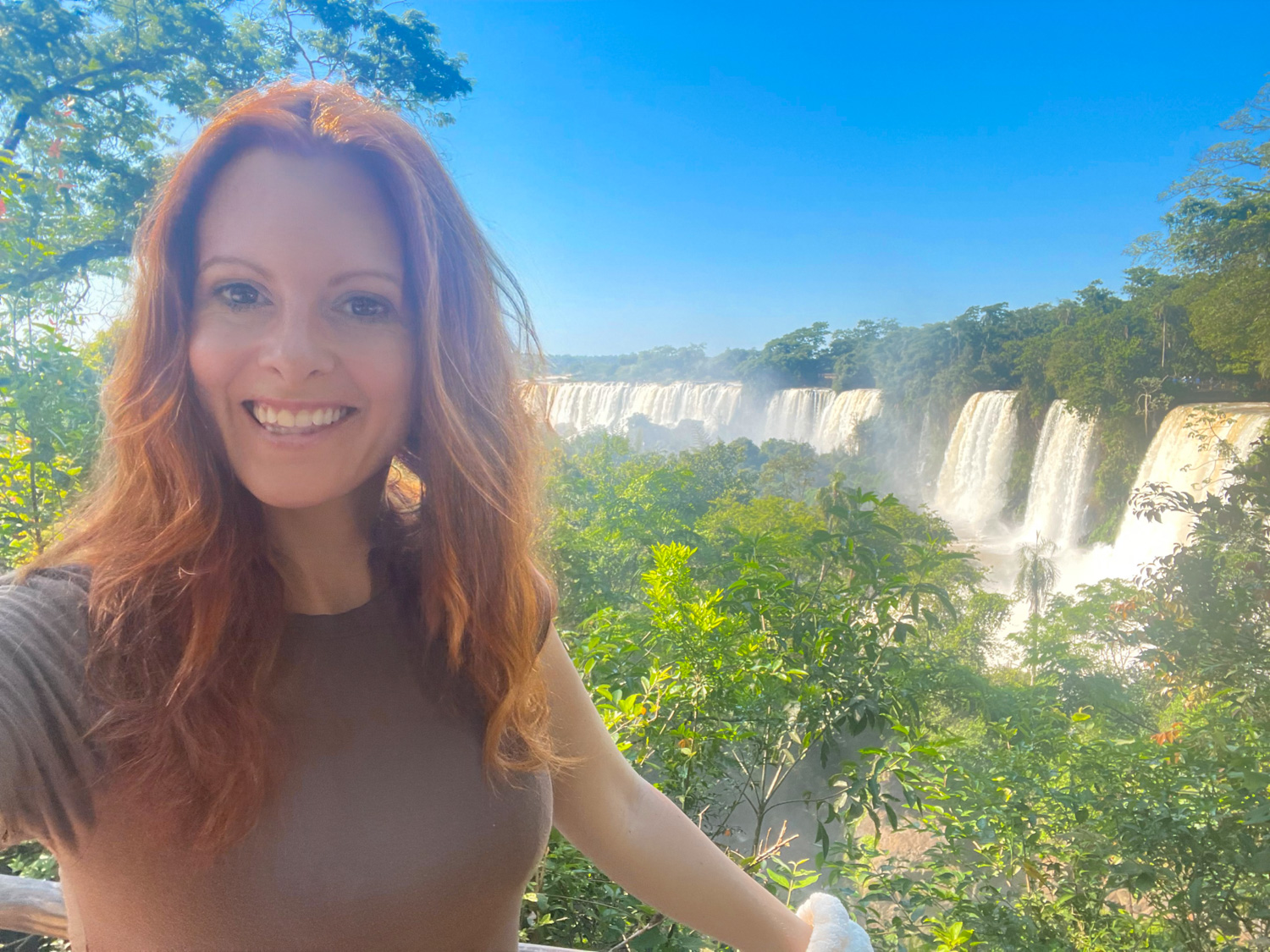
So what can you expect to see on this trail?
The clue is in the name: the upper path is a route that takes you up and over the top of the waterfalls. Along the way, you’ll be traversing a boardwalk that’s located just a foot or two above the surging, chocolate-brown waters. You’ll be surprisingly close to the brink, too, watching as the river passes beneath your feet then crashes 250 feet — or 80 metres — into the pools below.
It happens all of a sudden, too: there you are, walking towards the waterfalls and now here you are, standing on top of Iguazu Falls.
The entire Paseo Superior runs for 1,750 metres, with much of it passing over the top of the falls. Along the way, you’ll be able to see incredible views like these:
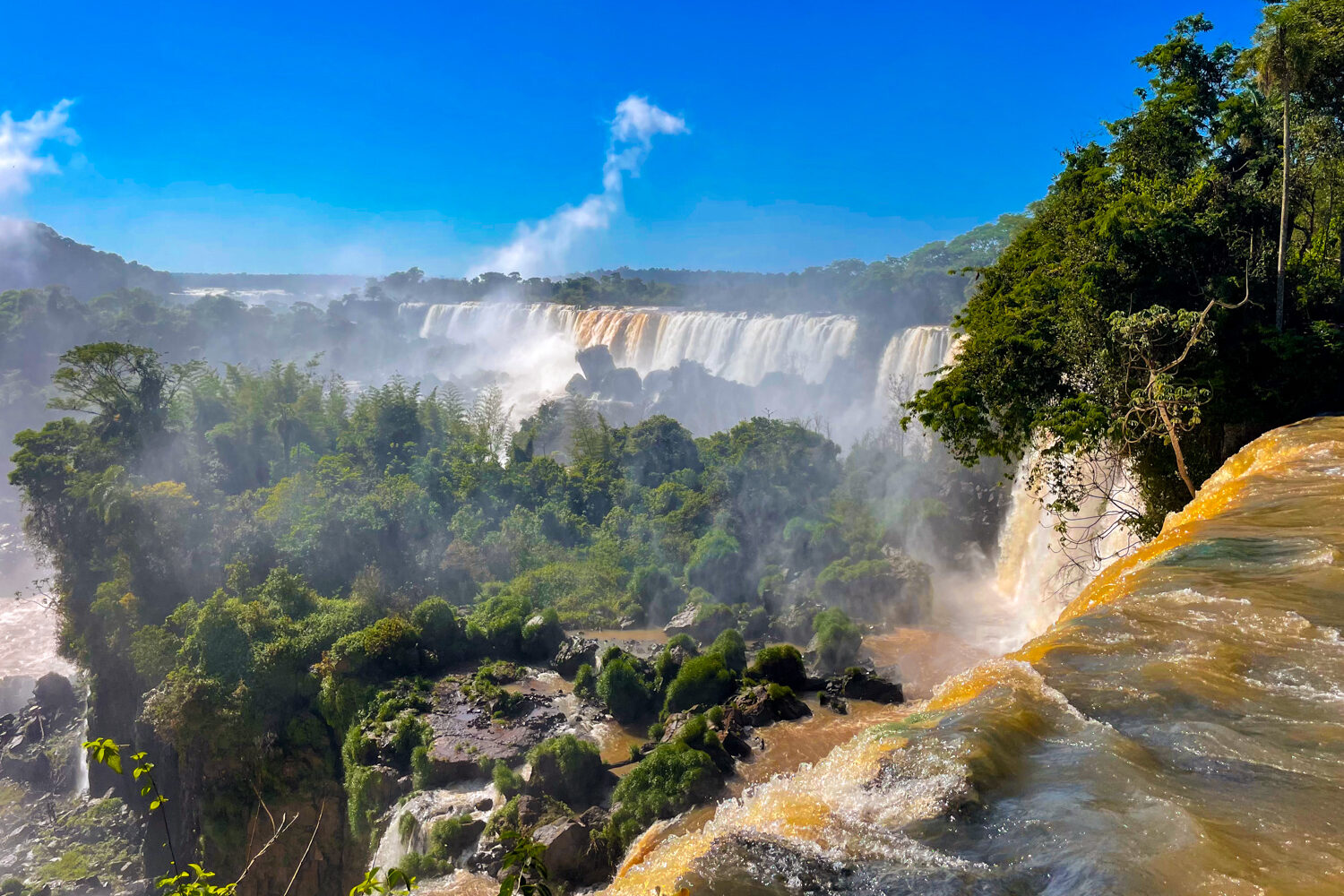
It’s not until you’re actually there in person that you can truly comprehend the forces that are at play here. The falls are deafening and the water is violent and the two combined are really quite remarkable.
I’d be gobsmacked if you weren’t gobsmacked.
It was also fun to see just how quickly the water gets churned up. As you walk along the path, you’ll be able to watch the calm waters on the right, drifting on by, with no idea what’s in store for them. And then off they go, smashing down to the ground below.
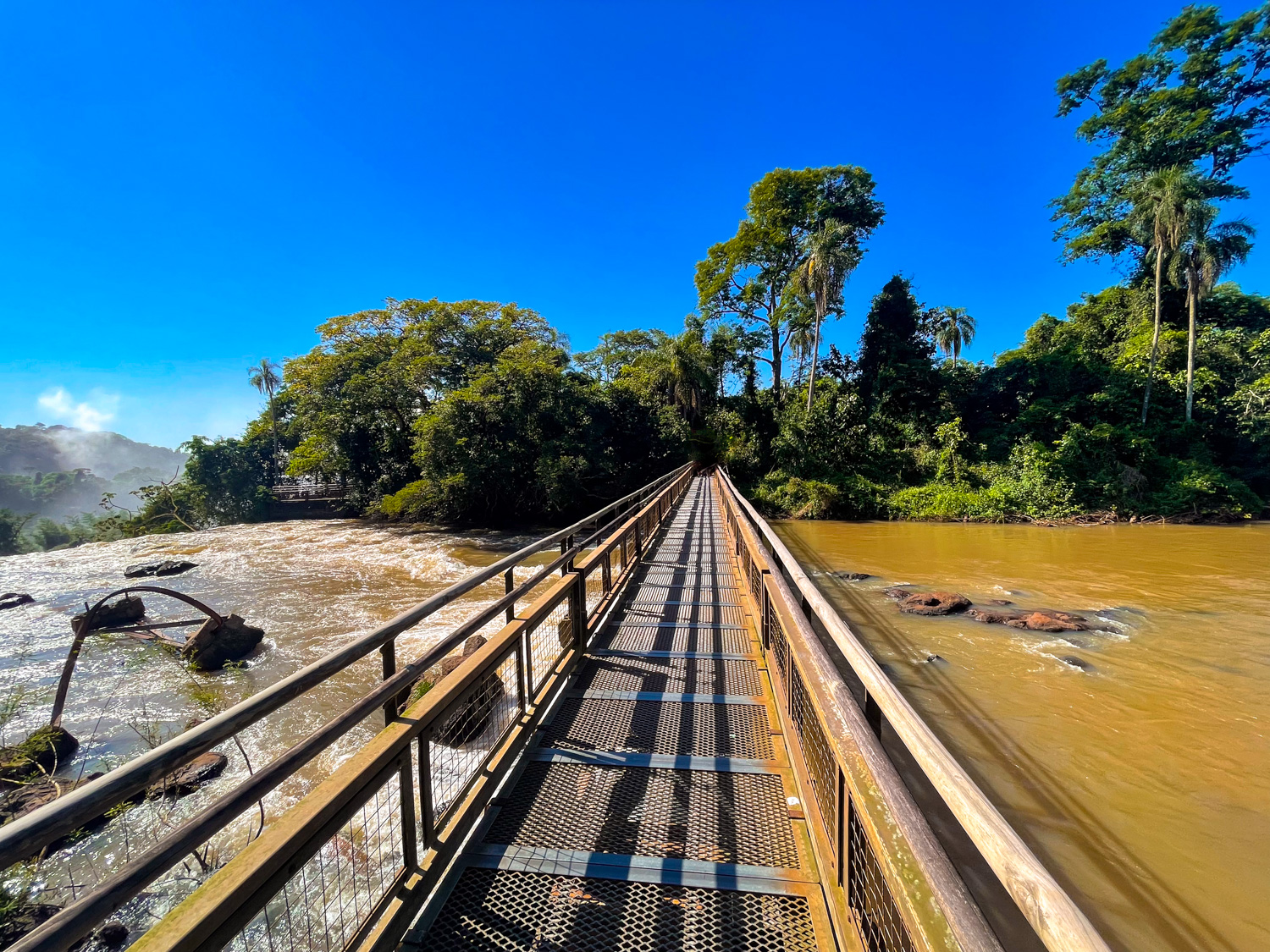
You’ll know when you’ve reached the end of the waterfall-spectating section because the path reaches a dead end and you have to head back the way you came. After a few hundred metres of this, you’ll reach a turn-off to the left, which then you takes you on a pleasant stroll through the rainforest.
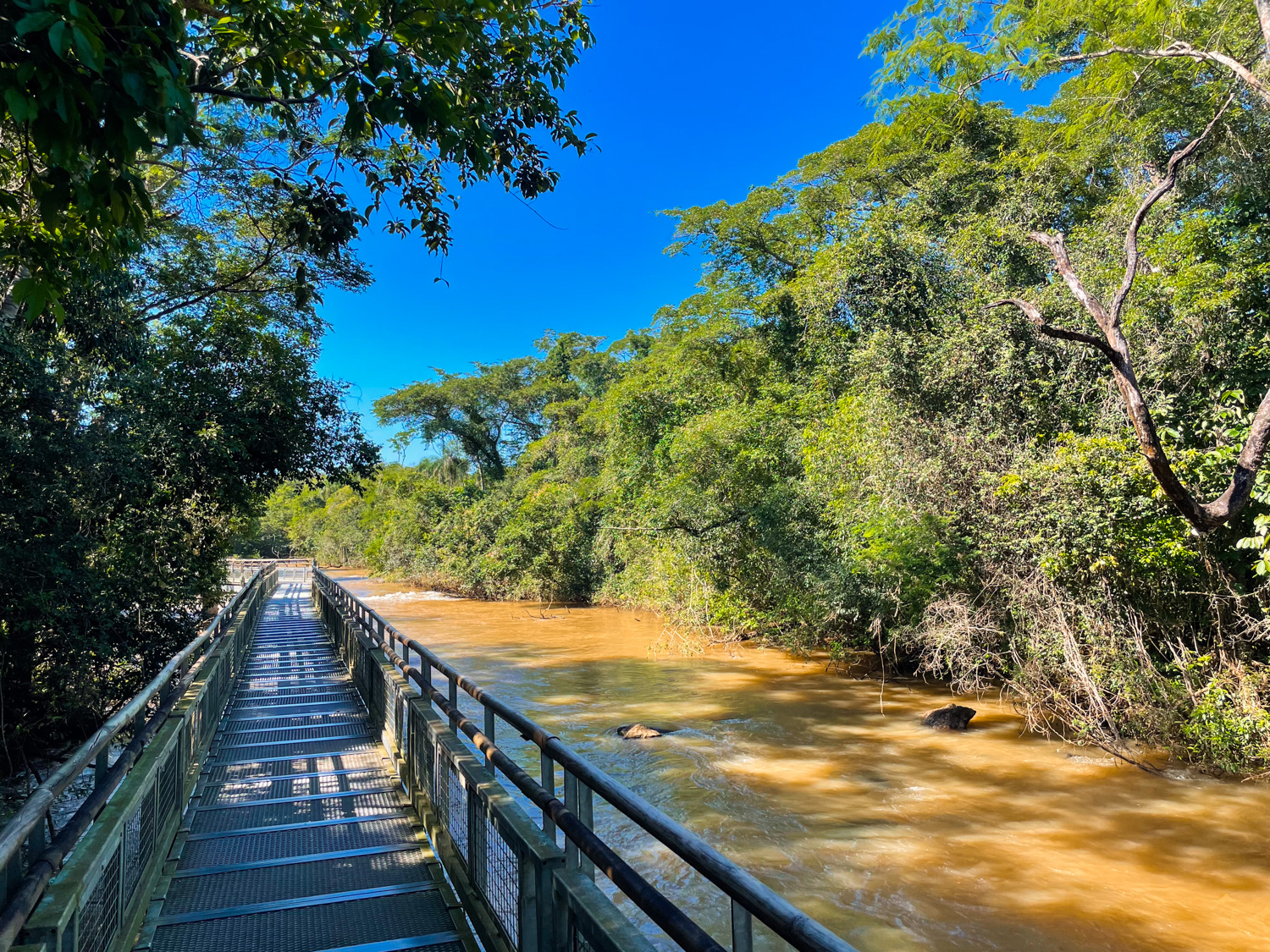
Yes, it’s not quite as breathtaking as the waterfalls, but I still enjoyed this gentle stroll beside the calmer waters.
You can expect to spend around an hour in total walking the upper path and by the time you reach the end, you’ll be wondering how anything can ever top what you’ve just seen.
Before we move on to the second trail of the day, you might feel pulled to indulge in your completionist tendencies. If so, take a quick walk back down the start of the Paseo Superior trail for a second time, just so that you can spend a few minutes admiring the viewpoint you skipped on the first go-around.
Odds are, though, it’s not going to be particularly exciting in comparison to what you’ve just seen.
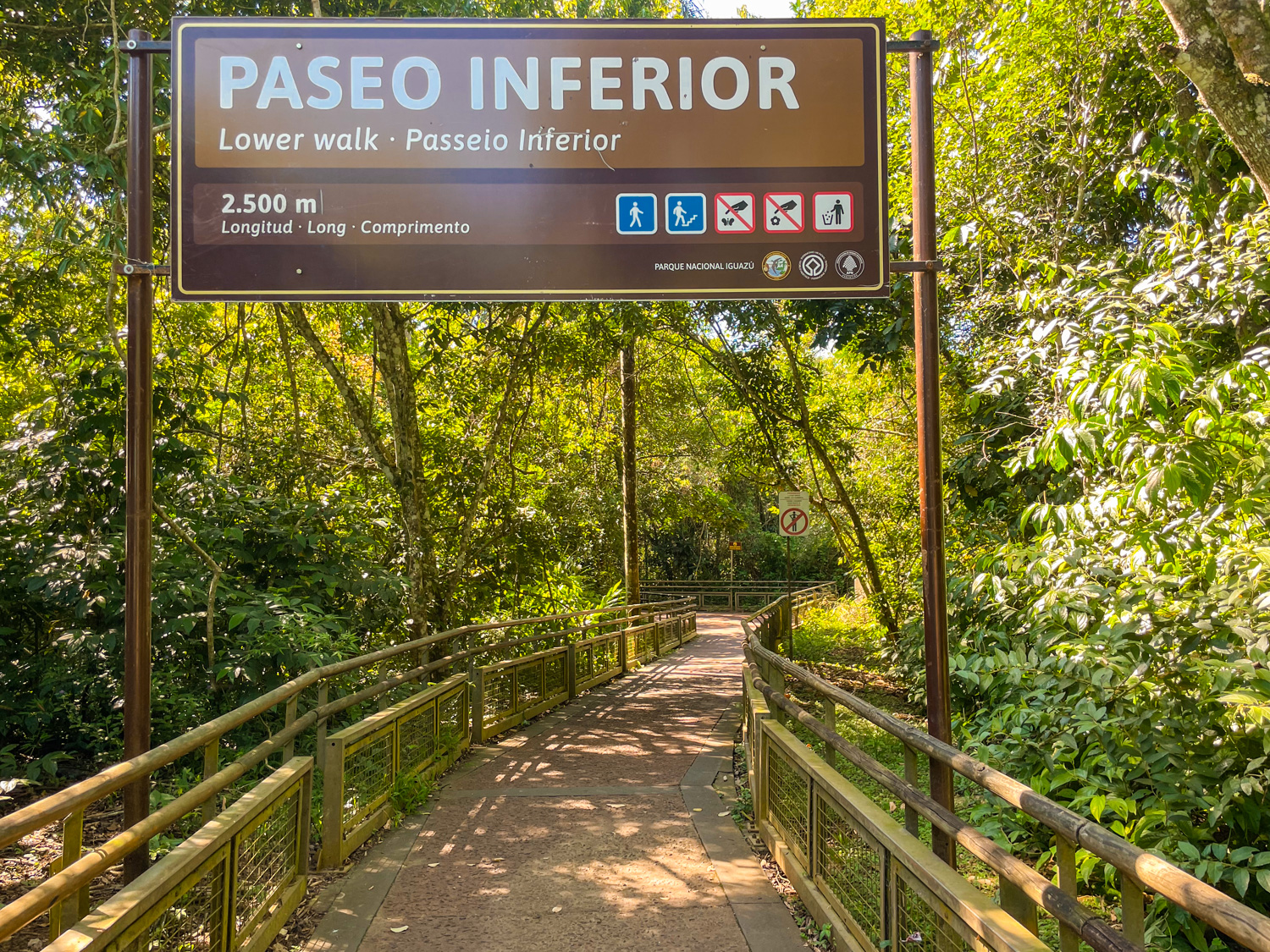
The lower path is also known as the Paseo Inferior and I found it to be equally as impressive as its upper counterpart. As you can see from the sign, it runs for 2.5 km (1.5 miles) and takes around 90 minutes to complete.
Because most visitors start on the upper path, I have to say that this route was delightfully peaceful, too. There were certainly more people than the zero I encountered on the first trail, but you’re definitely not going to feel as though you’re jostling for space with anyone.
You can see why I stress the importance of entering the park at opening time!
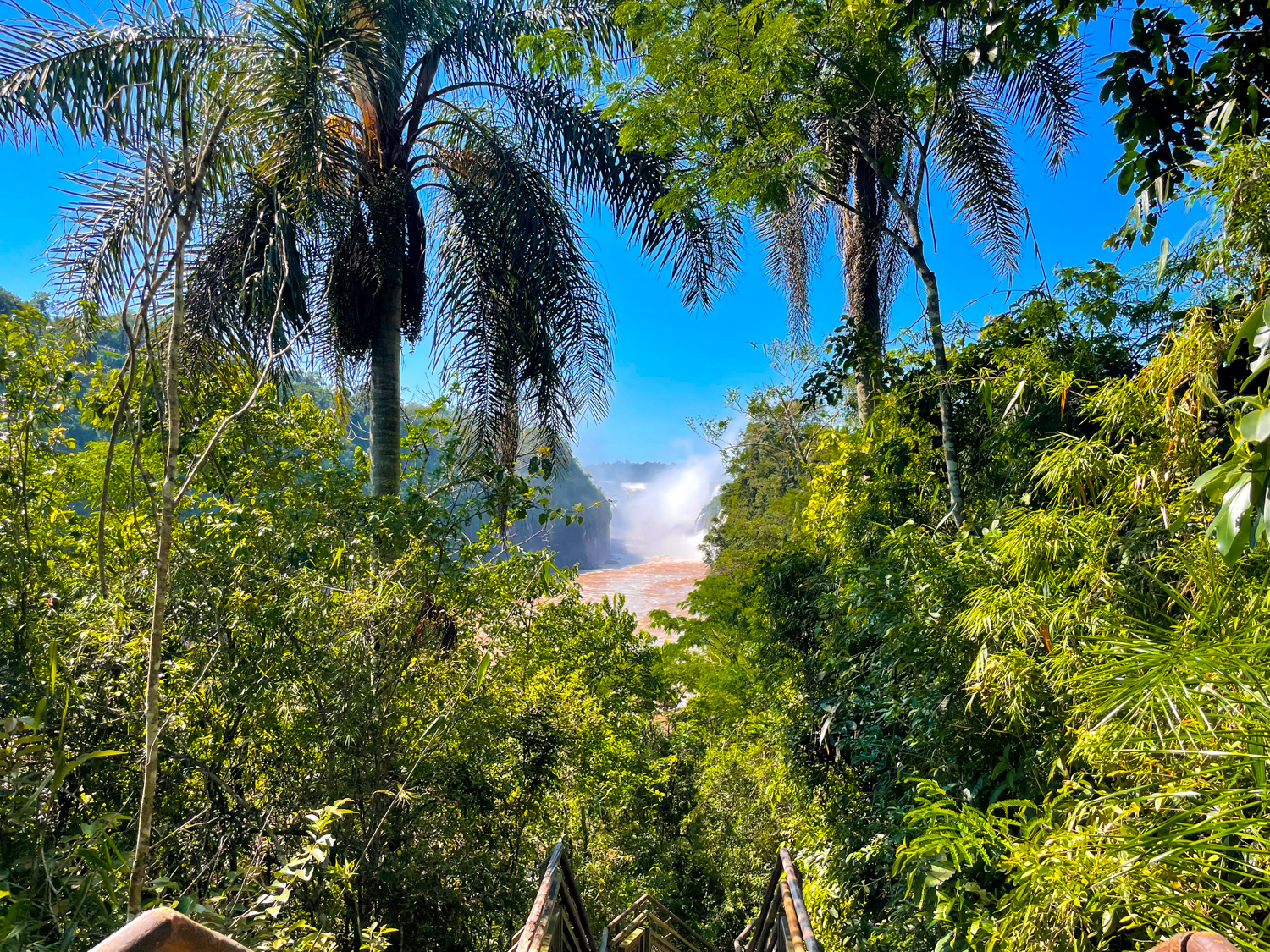
The lower trail starts further away from the falls, so you’ll be catching glimpses of the water in the distance as you walk. Of course, there’s also that enormous plume of mist that lets you know exactly where they are.
The trail starts off rather sedately, weaving through the rainforest and alongside the river, passing over the tops of smaller waterfalls. For the first third of the trail, there’s not all that much to see.
Suddenly, you turn a corner and bam:
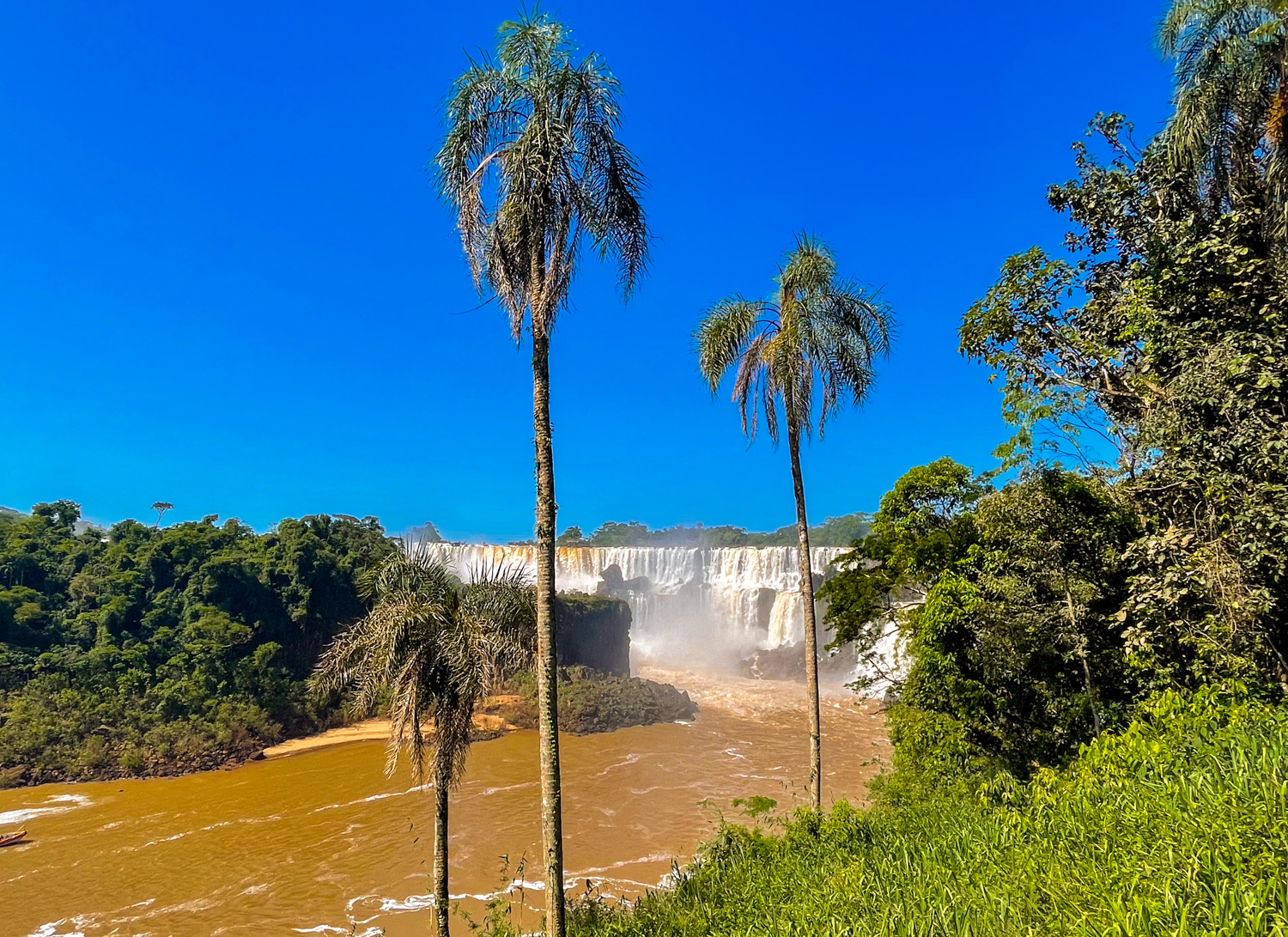
There they are again.
The viewing platforms on the lower route are more spacious than those of the upper, so although a handful of people are often gathered here, there’s always plenty of room to spread out.
You’ll notice it offers a different perspective of the waterfalls, too. When you’re walking on the upper trail, you can kind of only really see the top level of Iguazu Falls. From the lower path, you can see both tiers, effectively doubling the size of the viewable waterfalls.
If you’re travelling alone, like I was, use this relatively crowded spot to offer to take a photo of a couple together — then ask if they’d take one of you. It’s the only way I manage to get photos of myself when travelling!
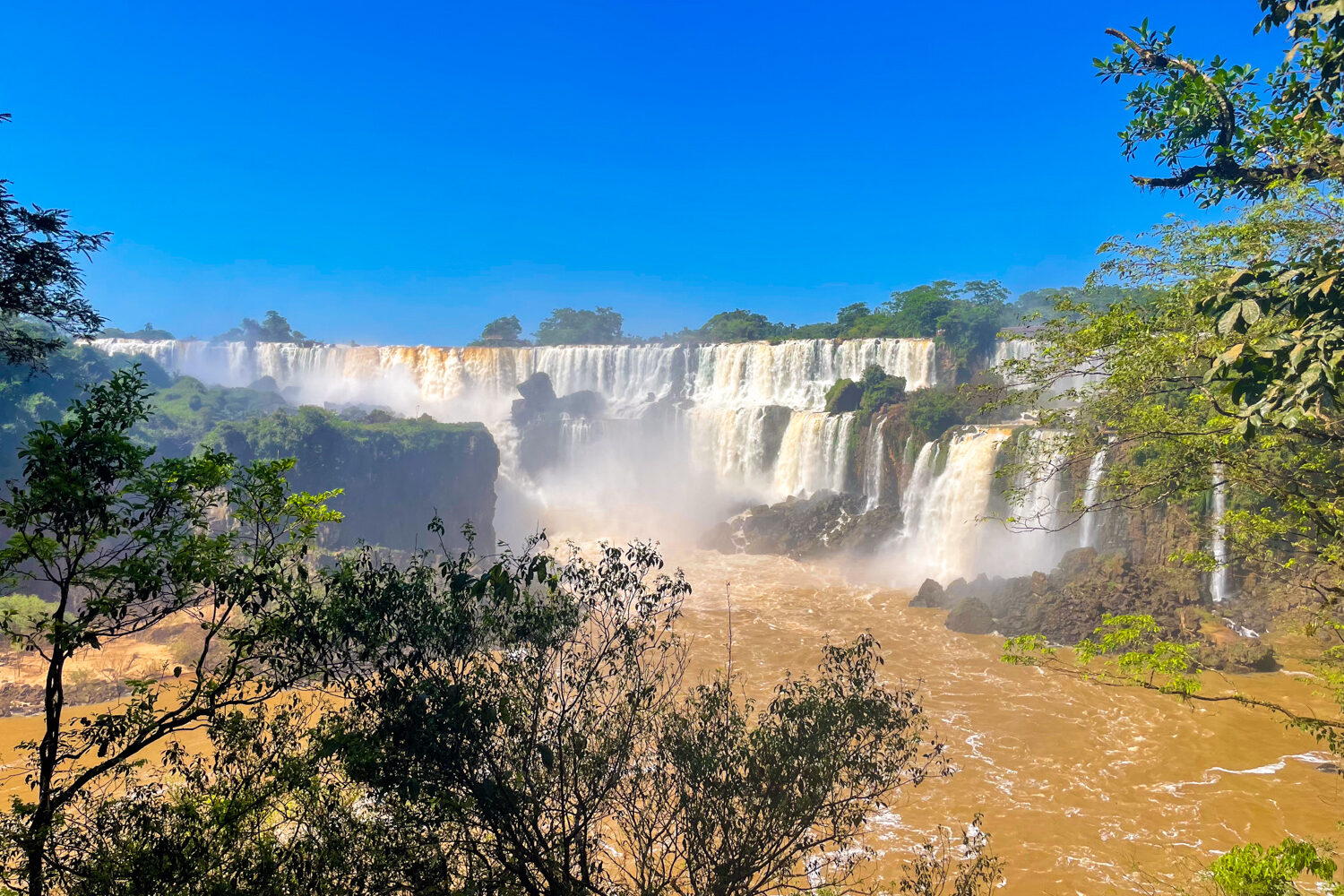
My favourite viewpoint from the lower path is the one pictured above, which comes right at the end of the trail. It’s actually your last real glimpse of Iguazu Falls from the walking paths, so make sure you take plenty of photos here.
Hilariously, while I was there, there was a guy with a step ladder and a high-end camera, offering to take professional photos of tourists at the viewpoint. I just loved that entrepreneurial spirit!
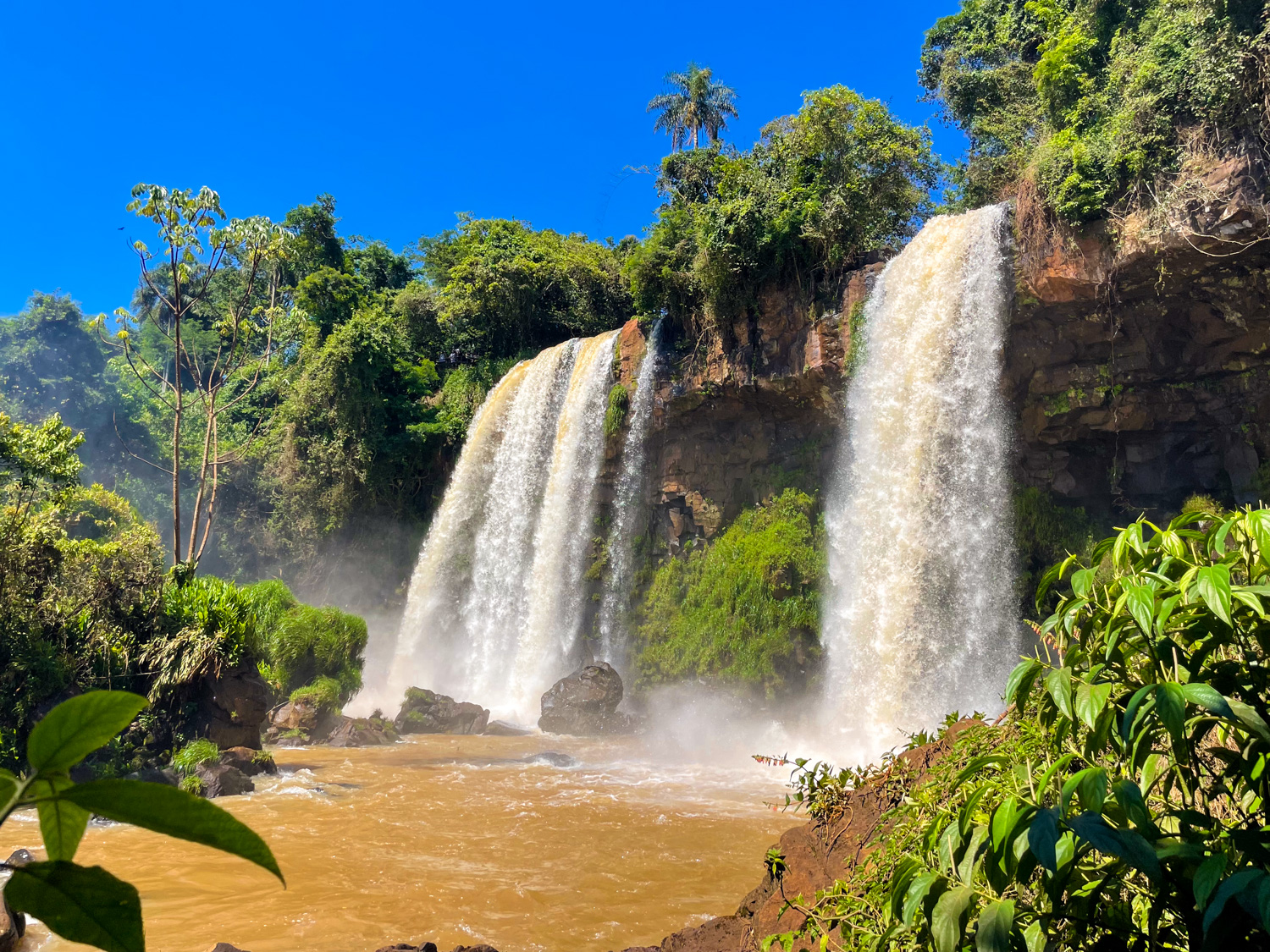
You’ll finish your walk with a passby of the Two Sisters. These waterfalls aren’t technically part of Iguazu Falls, but are impressive nonetheless. And this is also the only waterfall on the Argentinian side that you can observe from its base.
The walking portion of the day’s activities is now mostly over, so if you’re feeling hungry, there’s a food court located close to the end point of the lower path.
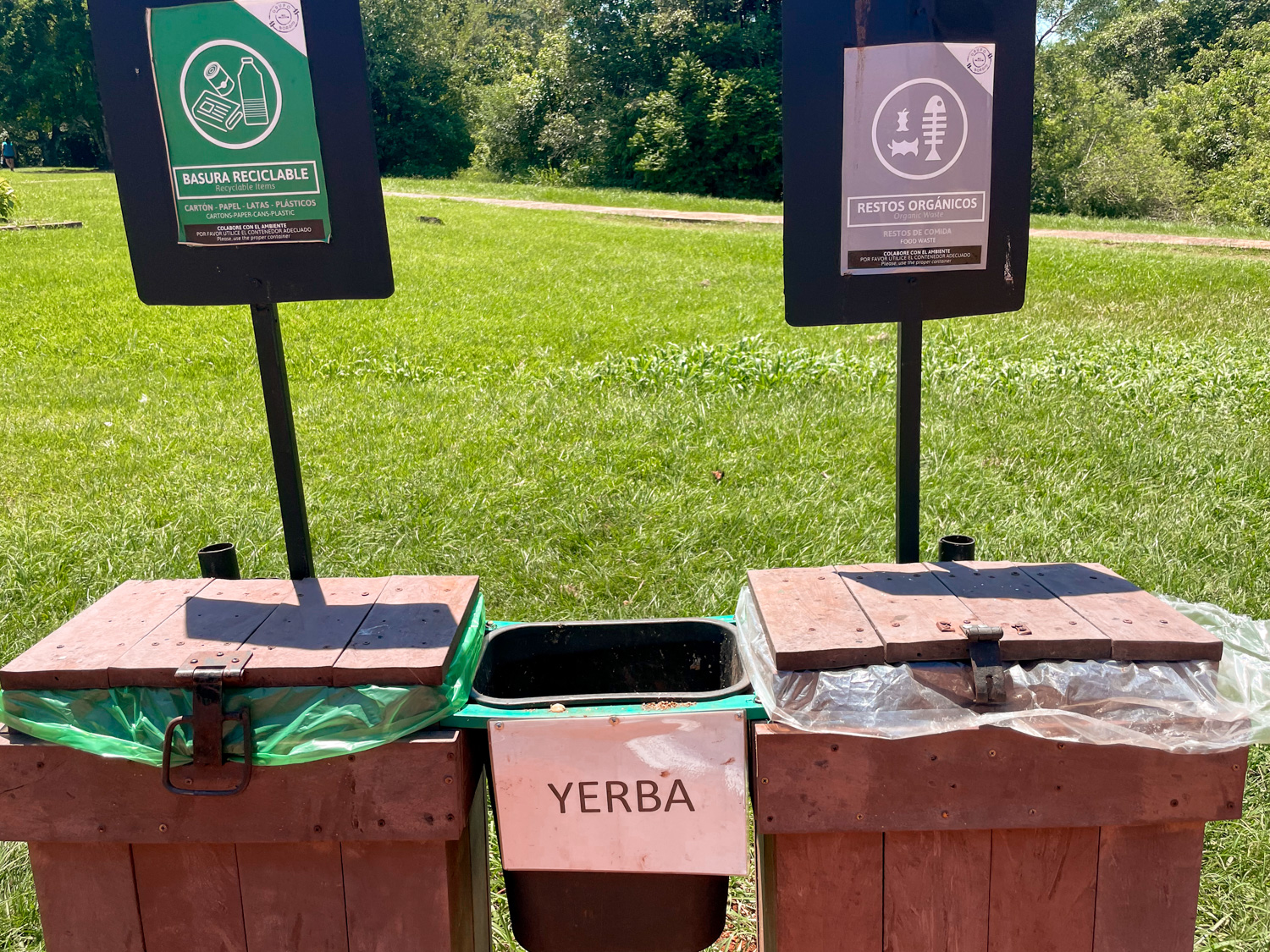
Don’t get too excited, though: the food is terrible and overpriced across the board. One of the restaurants — Jaguar House Cafe — is rated 1.7 on Google Maps, while a different restaurant (Fast Comida) is rated 1.8! It’s rare to see ratings quite as low as that.
The bad food was enough to put me off — and I was still full from breakfast — so I grabbed a bag of chips, bought a couple of souvenir magnets, then set off for my next activity.
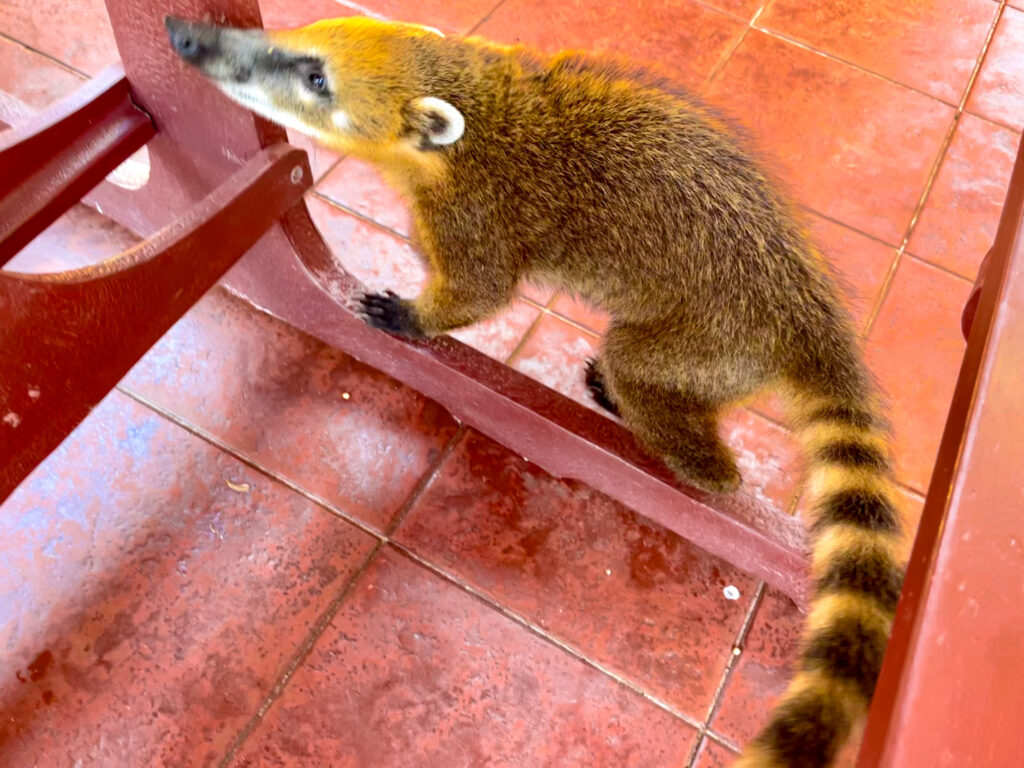
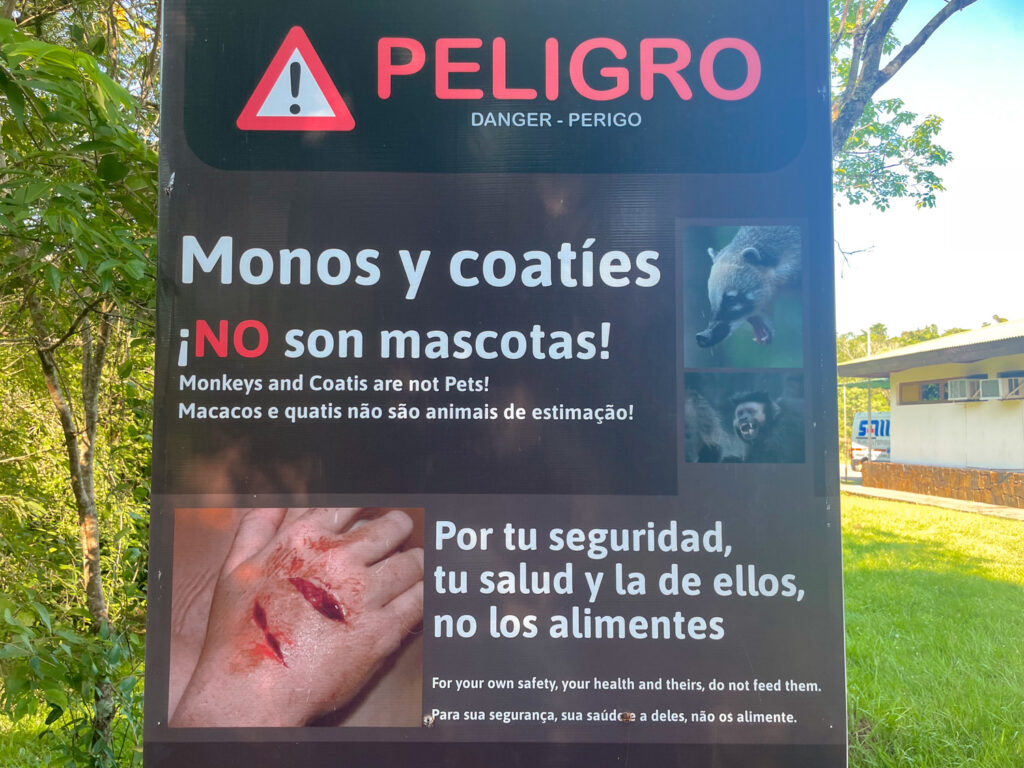
Before we move on, though, I just want to share a quick warning about the coatis.
These adorable animals are one of the symbols of Iguazu Falls. As in, they’re everywhere. They’re also very cute. You’ll see dozens of them hanging around beside the restaurants and if you have any food, they’ll be trying to get to it. Because of this, some of the food places are actually located inside cages to try to keep the coatis out!
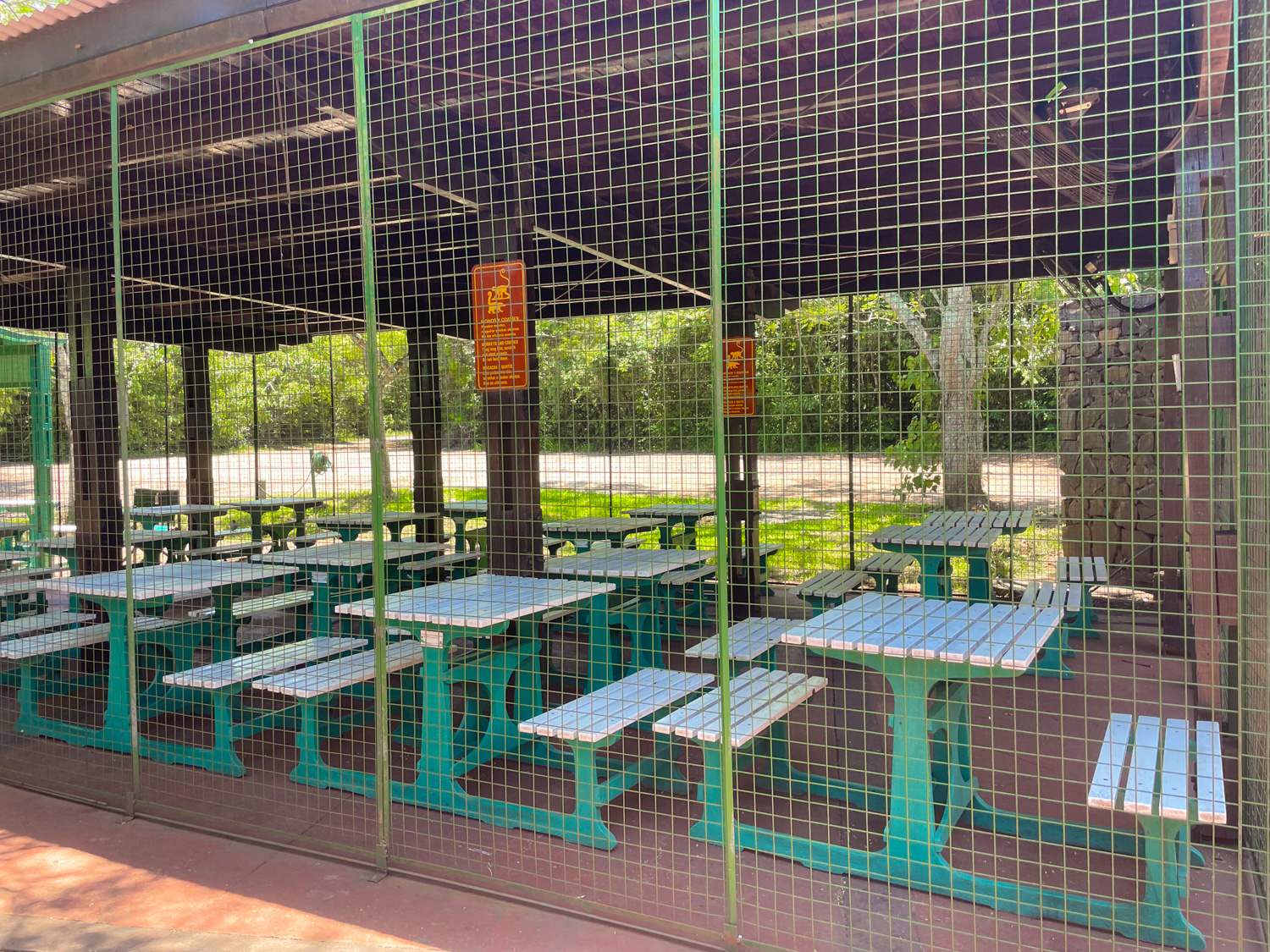
Is the Iguazu Falls Speedboat Worth It?
Now that you’ve ticked off the two waterfall walks, it’s time to head back to the park entrance to buy a ticket for the speedboat.
The biggest mistake that visitors make at Iguazu Falls is not riding the Gran Aventura speedboat.
You absolutely must do this while you’re there. It was the highlight from my entire South America trip. I don’t even know how to put into words just how deliriously happy the experience made me.
There are two ways to get to the speedboat ticket office.
The first is to get back on the train and take it back to the start point. I, however, recommend taking the Green Trail — the Sendero Verde — instead.
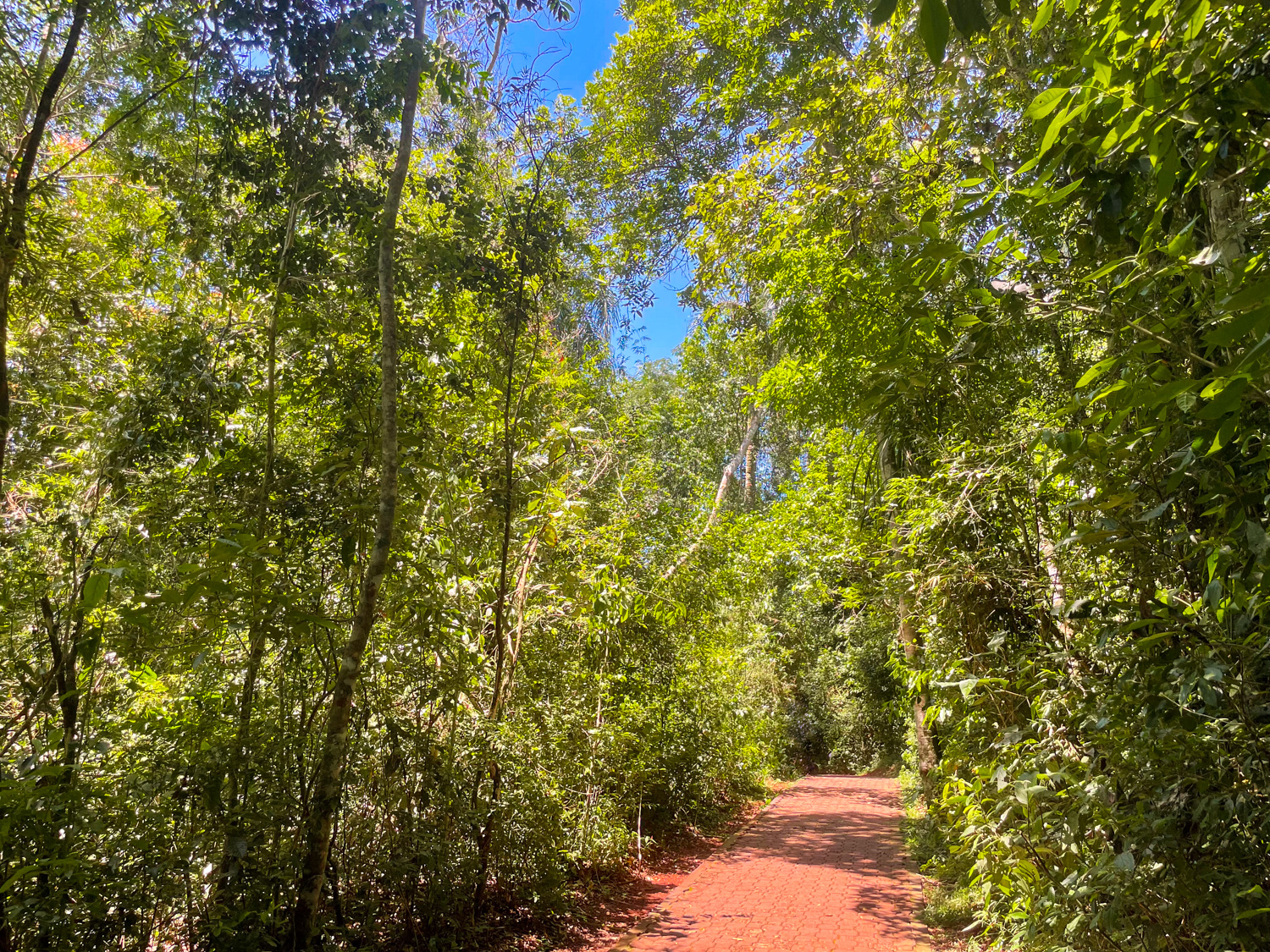
It’s just 650 metres in length (2,000 feet), so doesn’t take too long to walk. It’s not a particularly exciting trail, I’ll confess, but it does expose you to a new part of the park. It’s usually pretty quiet, too, so is a good option for escaping those rapidly-increasing crowds.
Keep your eyes peeled for toucans in the trees here, as this is one of the best spots for bird-watching in Iguazu. While I wasn’t lucky enough to spot one, I did see a huge black and white tegu lizard, which is arguably just as exciting.
You’ll emerge from the trail beside the speedboat ticket office; it’s located on your left-hand side. Speak to the staff behind the counter and ask to join in on the next departure. Tours leave every 75 minutes, so you’ll likely be on the 12:45 p.m. tour. It costs $45 per person and I promise it’s worth the money.
So yes, my speedboat experience of Iguazu Falls was some of the most fun I’ve ever had.
It sounds kind of dramatic, but it was truly such a memorable travel experience. It was fun, funny, and exhilarating, and I couldn’t stop laughing afterwards.
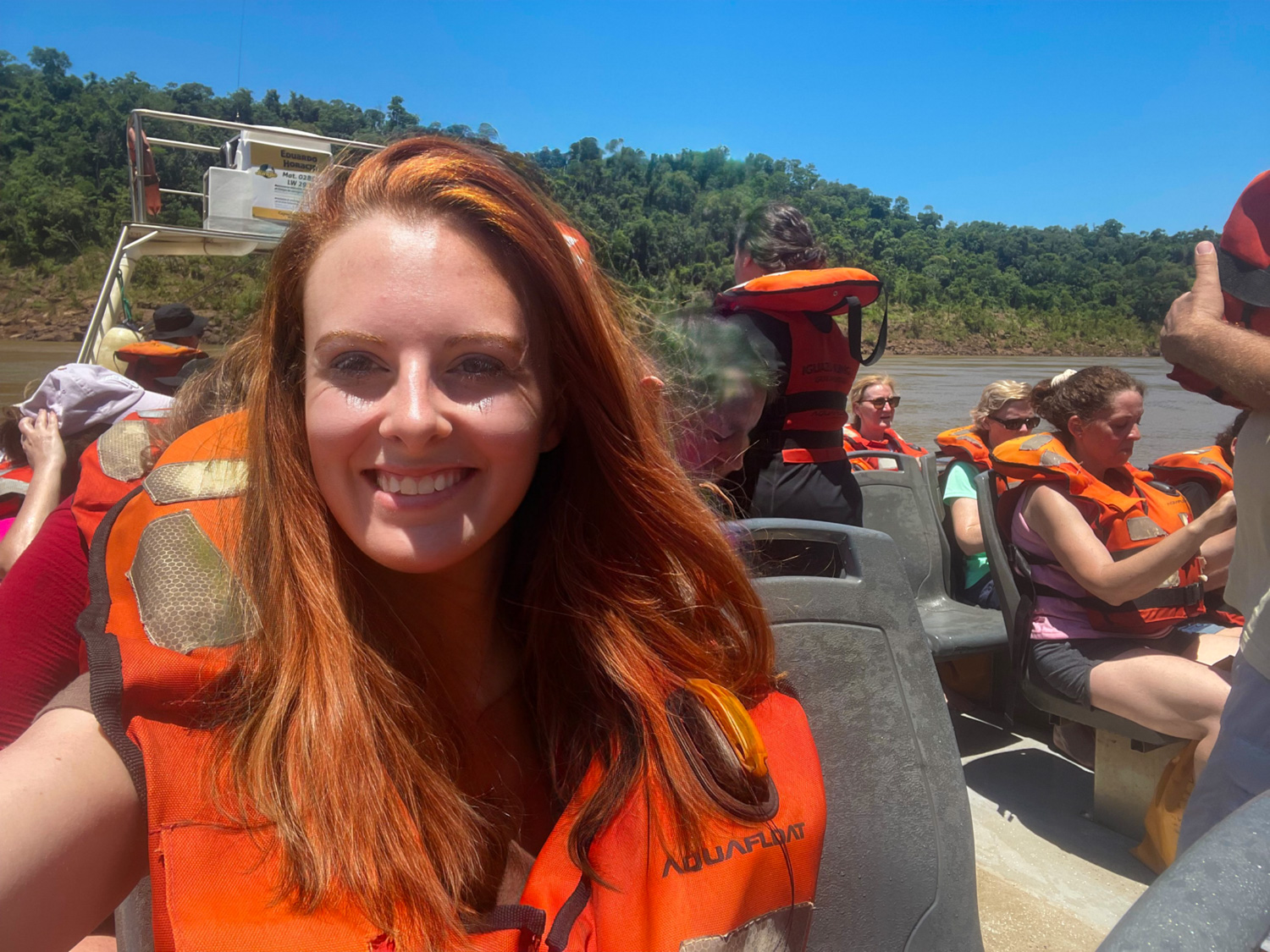
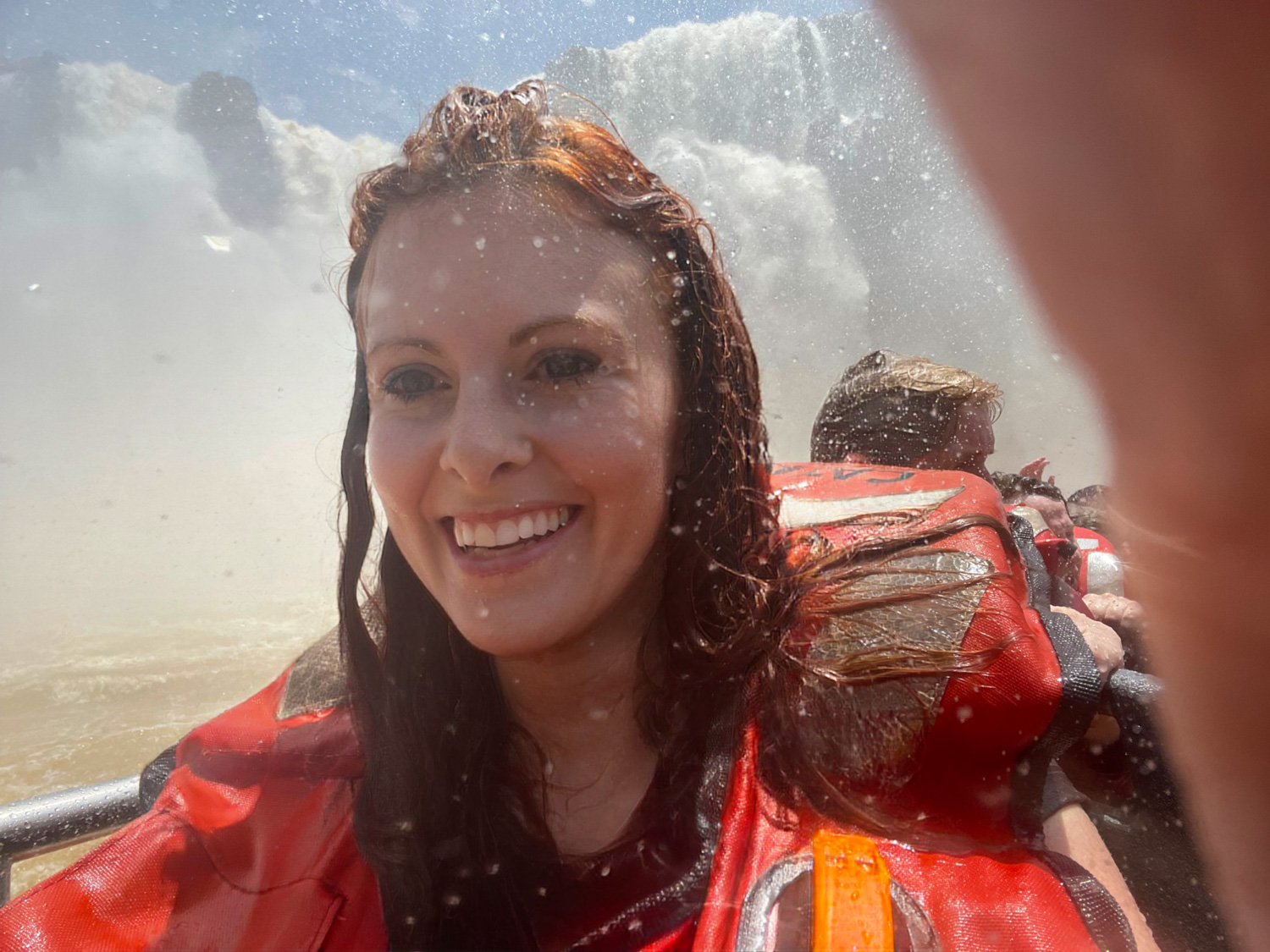
Iguazu Falls destroyed my passport. (That was the second mistake I made.)
And I’ll confess that when I signed up for the speedboat, I wasn’t exactly aware of what I was getting myself into. There was a part of me that thought I was signing up for a calming river cruise.
When I was queueing up for the experience, then, and a safety video began playing, listing the 50-odd conditions that disqualified you from riding the speedboat, I started to feel alarmed. If you cannot handle acute levels of stress, you should not board.
Uh, yikes?!
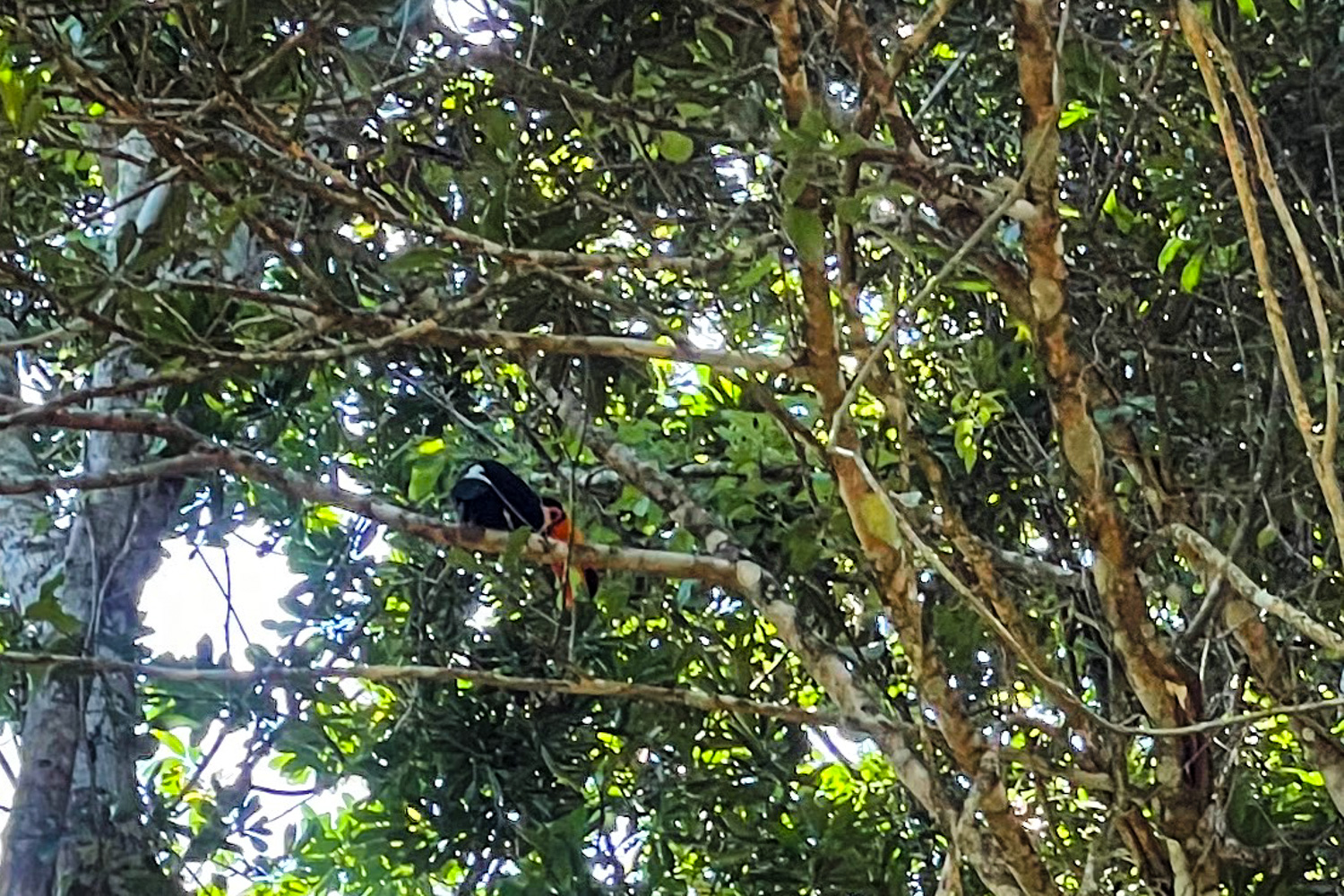
It was with an air of tentativity, then, that I stepped aboard the truck that would take us through the rainforest for the next 20 minutes.
Along the way, our guide shared more about Iguazu Falls, the geography and history of the area, and the animals that call this park home. We paused often, whenever we spotted something in the trees, like an enormous spider or friendly toucan.
When we reached the dock, we collected a dry bag that was roughly the size of my torso and were fitted with a life jacket.
Upon boarding the speedboat, it was time to remove everything we held precious to us. Off came our shoes and socks — that was mandatory — and then any valuables we also wanted to keep dry. Some people had brought a spare set of clothes to change into afterwards; clearly more aware of what was in store than I was. Into the dry bag they all went, and thus began the safety briefing.
With everyone now firmly holding on to the handrail, it was time to begin.
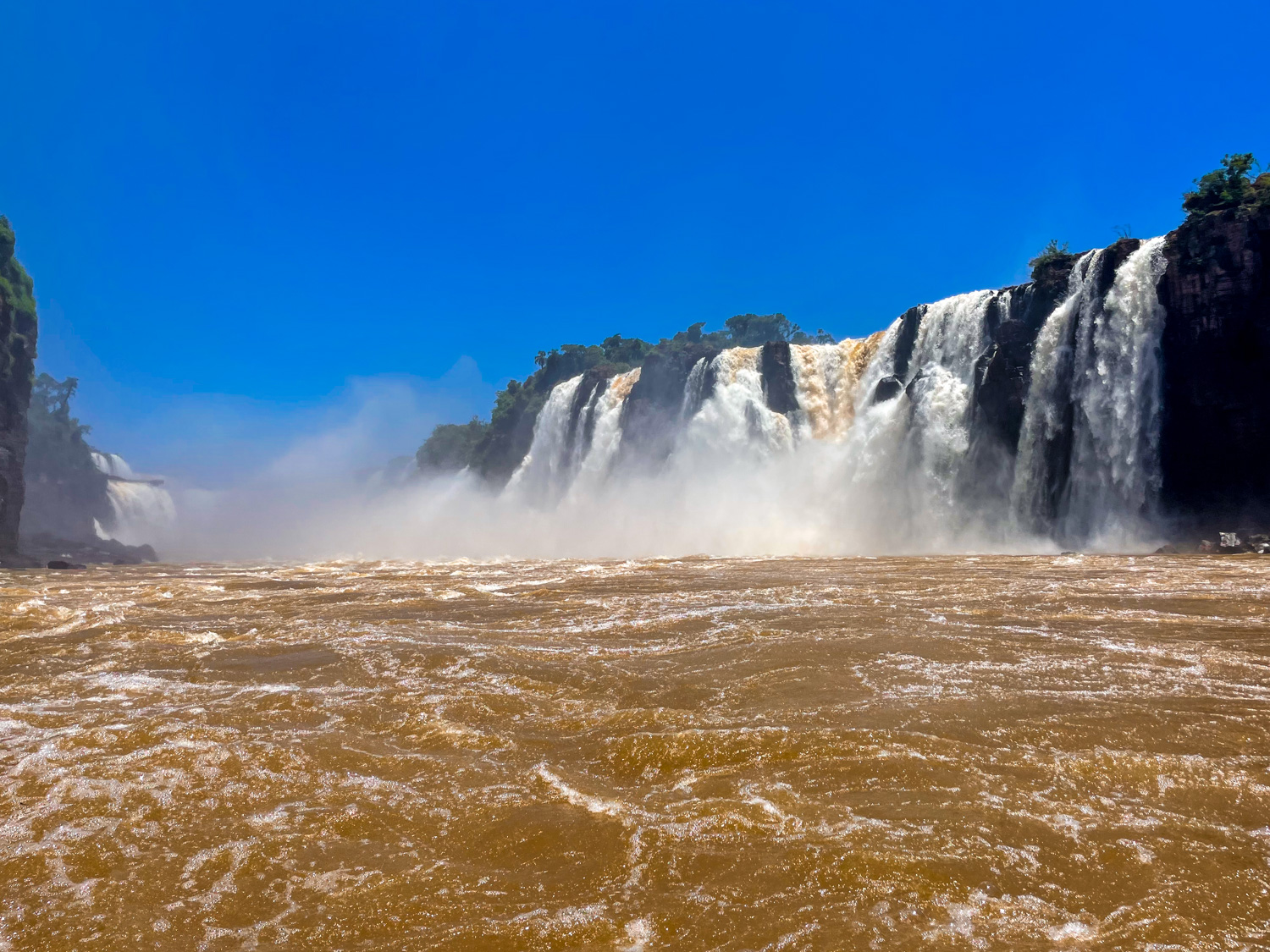
We tore off up the Iguazu River at lightning speed, the wind whipping our hair around our faces.
To the right, we passed thundering waterfalls, while up ahead, the churning rapids threatened to throw us overboard. I gripped the handrail even tighter. Up and over the currents we went, catching air then forcefully slapping back down to the surface of the water.
Within minutes, Iguazu Falls was directly in front of us, the mist already starting to dampen our faces. Our guide had told us the recent rains had resulted in the waterfalls expanding to a flow-rate that was five times heavier than normal. It was hard to process just how much water was falling metres from our vessel.
The speedboat in front of us gave a sneak peek at what was to come.
They sat stationary for a while, as though building up courage to attack. And then they surged forwards: faster, faster, faster. At the base of the falls, their boat served as a valuable tool for gaining perspective of the scene; just how tall the waterfalls were. And then white.
Nothing.
I watched with my mouth wide open as they were completely engulfed by the waterfall.
Before I could react, our driver was shouting for us to put our phones away; to get ready; to hold on.
The spray began to spatter across my face as we neared the cascade. I laughed out loud — not that anybody could hear me — at the sheer impressiveness of the scene. It was everywhere now. The water. Like standing beneath a showerhead that was turned up to 11. I was soaked. Everything was dripping; my bare feet swimming in a pool of water.
I thought I’d experienced it all, but we weren’t stopping yet. No, we were charging ahead still, deeper and deeper into the waterfall until my senses were numb to the world. A roaring white-out of heaviness, pounding, soaking confusion. Delirium.
What was life? What was consciousness? What was up and what was down?
Reality lost all meaning as water overflowed from my screaming mouth and I wondered if this was how I might die; death by World Wonder.
It was 36 degrees (97°F) during my visit, so the cold waters of Iguazu were refreshing rather than shocking, but it still wasn’t over yet.
We circled the island and chose another waterfall to immerse ourselves into. Then another. And another. I looked like I’d emerged from a fully-clothed fall into a swimming pool.
We were all in hysterics at this point, squealing joyfully, screaming, applauding, regressing into inner-children, throwing our arms up towards the water in praise. I can’t remember a more exhilarating experience than this one.
The strength of Iguazu Falls was no longer a mystery. The top of head had experienced it all.
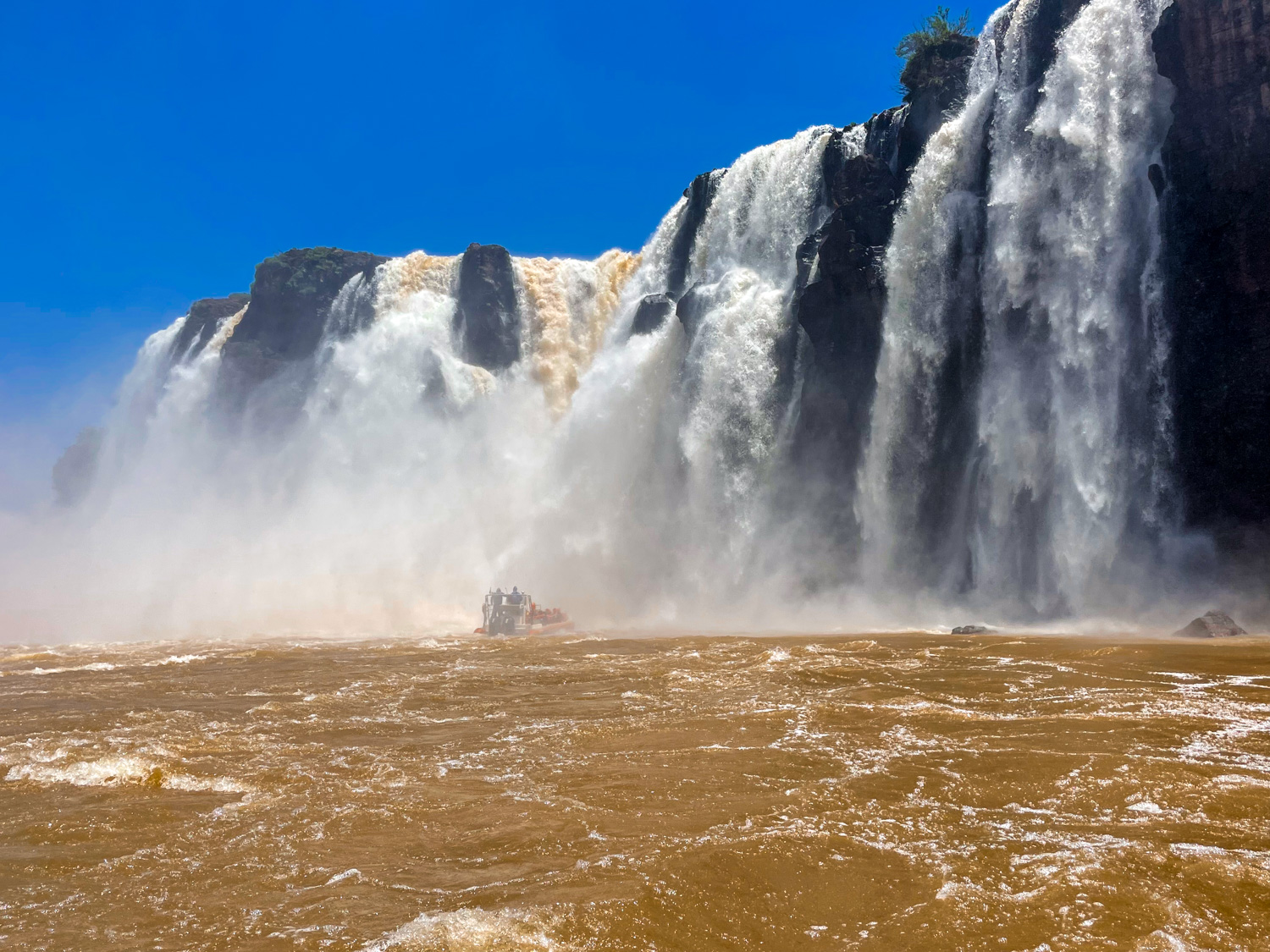
Amazingly, by the time we’d returned back to the dock and taken the truck back to the start point, I was completely dry.
I was completely dry, that is. My passport was not.
Not the best time to learn that my money belt was not, in fact, as waterproof as advertised. So yes, use the dry bag for everything while you’re on the speedboat, even if you think it’s in a waterproof container. This waterfall has a way of getting everywhere.
Still, my two-hour Gran Aventura experience was one of my best ever, so it was a 10/10 from me; well-worth ruining my passport for. All I needed to do now was make my way out of the park and recover from it all in the guesthouse swimming pool.
On my way to the exit — I took the train to get back to the start — I couldn’t believe just how much the crowds had intensified. You’ve seen the photos throughout this article: the vast majority of them don’t have a single person in sight. And yet, by 4 p.m., the walkways were looking like this:
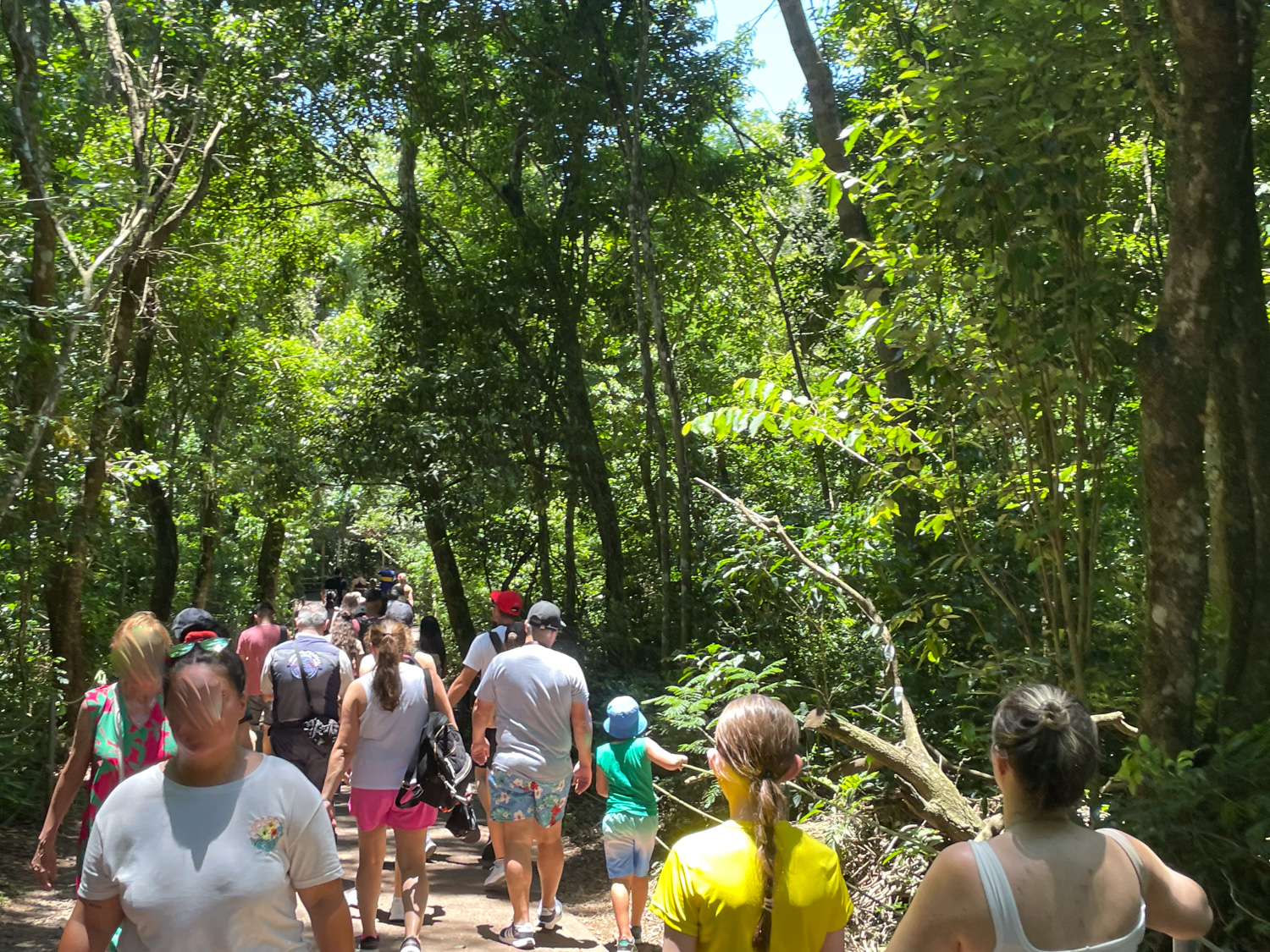
Is It Worth Spending Two Days on the Argentinian Side?
When you leave the park, you’ll have the option to get your ticket stamped, which allows you entry for following day for a 50% discount. Is it worth it?
In my opinion, no. Or, at least, in 2024, when the Devil’s Throat and a few other walkways are closed, it’s not. You have plenty of time in one day to do the three most important things: the upper path, the lower path, and the speedboat ride.
If you have an abundance of time in your travel itinerary and absolutely adore spending time in nature, you might want to head back to see the exact same views again. But really, you’ll have seen the vast majority of the park on your first day.
The only thing I didn’t include on my visit was the Macuco Trail. This hiking path is located just inside the entrance to the park and takes you on a rainforest walk to — you guessed it! — a waterfall.
It’s nice enough, but… it’s a 7 kilometre round-trip trek (4.5 miles), so takes around 90 minutes to complete. And then when you get to the end, you’re greeted with a small, skinny waterfall that’s not even 5% as impressive as the ones you’ve seen throughout the day.
Really, you’ll only want to opt for this if you’re a dedicated hiker, if you want to complete every single activity there is to do in the park, or if you’ve already decided to spend two days there and don’t have anything else to do.
Instead, I’d recommend spending the night in Puerto Iguazu and then heading over the border to Brazil the following morning. And speaking of spending the night in Puerto Iguazu…
Where to Stay in Puerto Iguazu
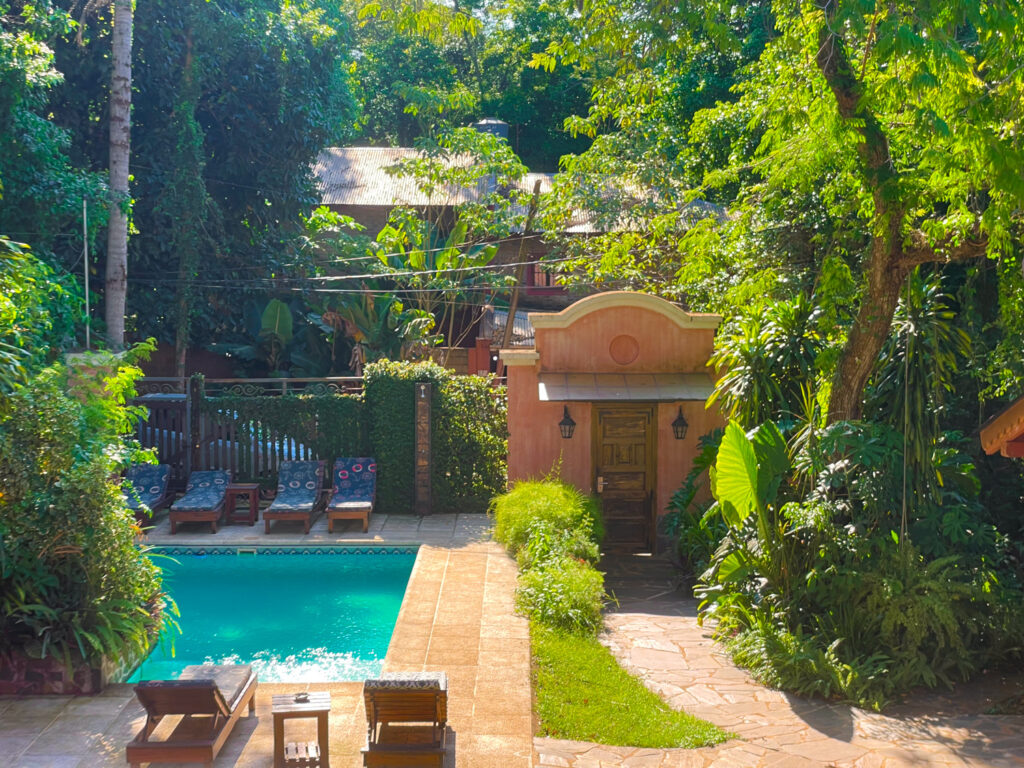
I’ll confess that my main reason for spending an additional night in Puerto Iguazu — rather than crossing the border into Brazil that evening — was my lovely accommodation.
I chose to stay at Rincón Escondido B&B at a price of $90 a night. Honestly, I booked it for three reasons: 1) it was the best-rated property in Puerto Iguazu, 2) I wanted to use a swimming pool after visiting the falls, and 3) every single review made the breakfast sound like it would be the best.
Thankfully, it lived up to expectations. The owner was so kind, waiting up until midnight to greet me from the airport, happily serving me breakfast at 6:30 so that I could get to falls on time, and giving me tons of advice on how best to avoid the crowds at Iguazu. And yes, the breakfast was ridiculous, with fresh fruit, breads, croissants, muesli, yoghurt, avocado, egg, muffins, banana bread: all for one person!
Cooling off in the swimming pool after a 36°C (97°F) day at the waterfalls was also very much an enjoyable activity.
What About Staying in the Gran Melia?
One little-known fact about Iguazu Falls is that both sides of the waterfalls have a hotel located inside the parks’ perimeter.
On the Argentinian side, it’s the Gran Melia. And if you’re thinking to yourself, that’s gotta be expensive, you would be correct. You’re looking at around $600 a night to stay there; more if you want a room with a view over the falls.
I personally would not recommend doing this. A lot of the reviews mention that the rooms are a bit tired and the food not being great. But not only that: you can’t actually access the waterfalls outside of opening hours! To me, that would be the main benefit of staying somewhere so expensive, but alas!
That’s why I would suggest saving your splurge — if you want to have one — for the Brazilian side of the falls. The hotel there actually does give you access to the waterfalls outside of park hours!
Things to Do in Puerto Iguazu
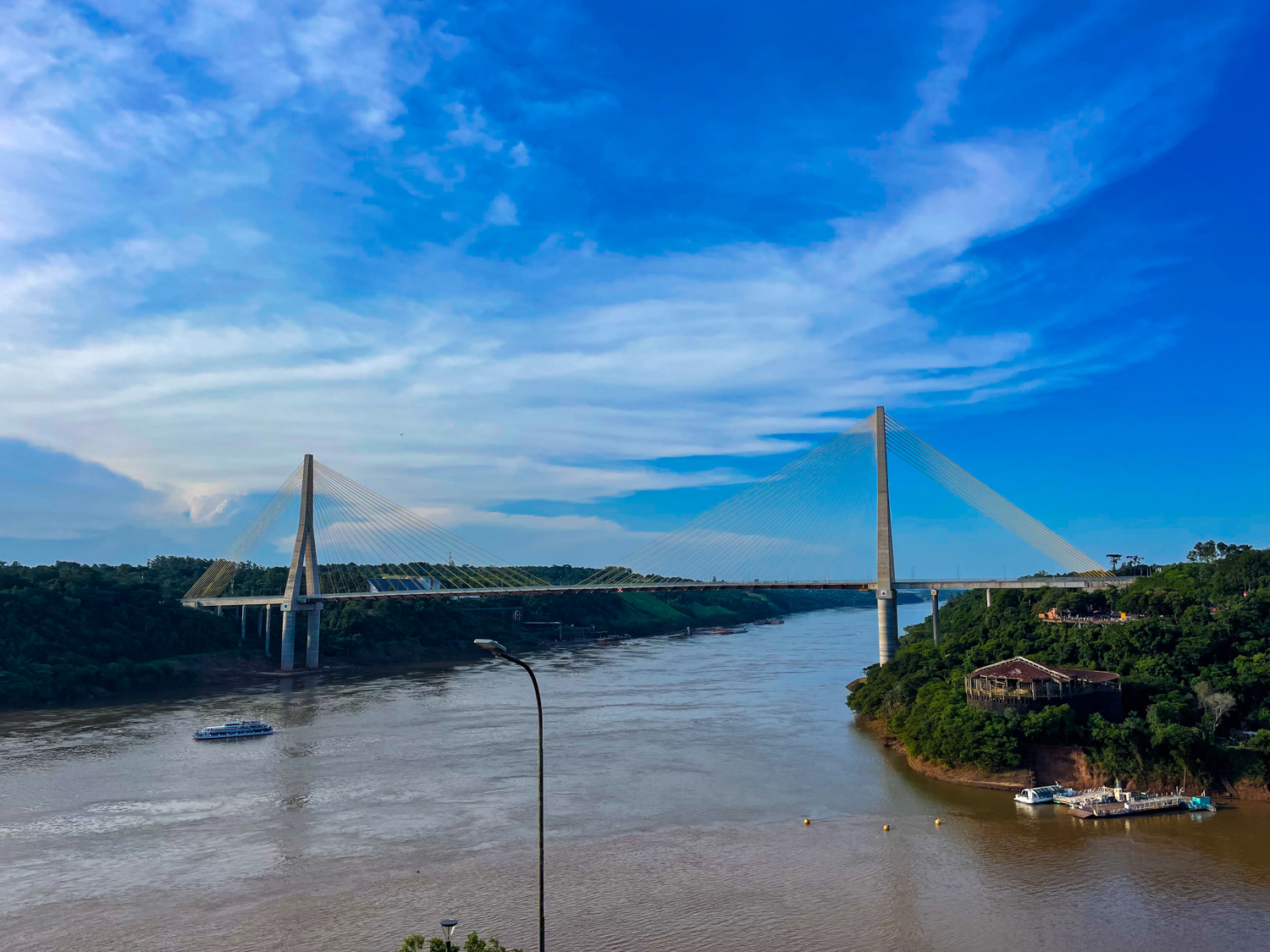
There isn’t much.
The main activity is visiting the tripoint of Argentina, Brazil, and Paraguay: the borders of all three countries meet in the spot where the Iguazu and Parana rivers converge. If you do want to see it, it’s best to do so in Argentina, because you have to pay to access it from the Brazilian side.
I walked the 40 minute, 3 kilometre distance from my guesthouse to the tripoint for sunset. It was enjoyable enough, and I’m fairly certain it was my first ever triple border, but there really isn’t much to do there. You simply look out at the two rivers and wave at the tourists who are standing at the equivalent landmarks in Brazil and Paraguay.
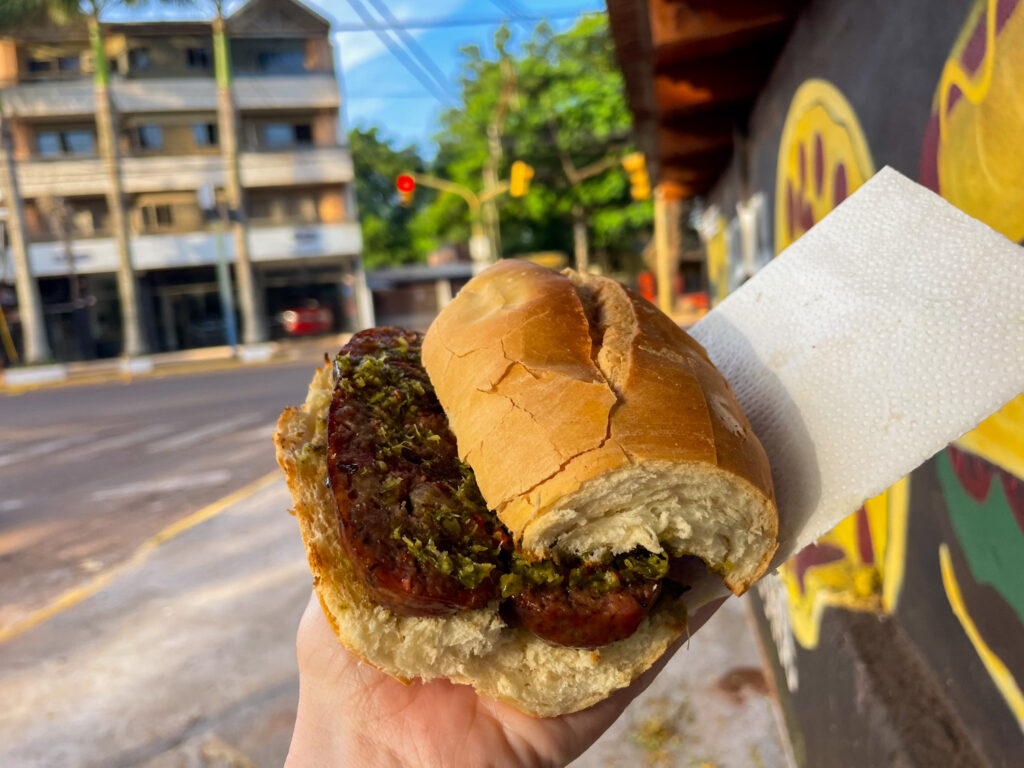
On my walk back to the guesthouse, I stopped in at Chez Le Choripan for a choripan for dinner — it was one of the best versions of the dish I had in Argentina. Choripan is a beloved Argentinian street food; the clue’s in the name: it’s grilled chorizo sausage on toasted bread! There’s usually tons of flavourful chimichurri added, too.
And with that, I settled in for an early night.
Because tomorrow? We’re going to be heading to Brazil.
How to Get from Puerto Iguazu to Foz do Iguaçu
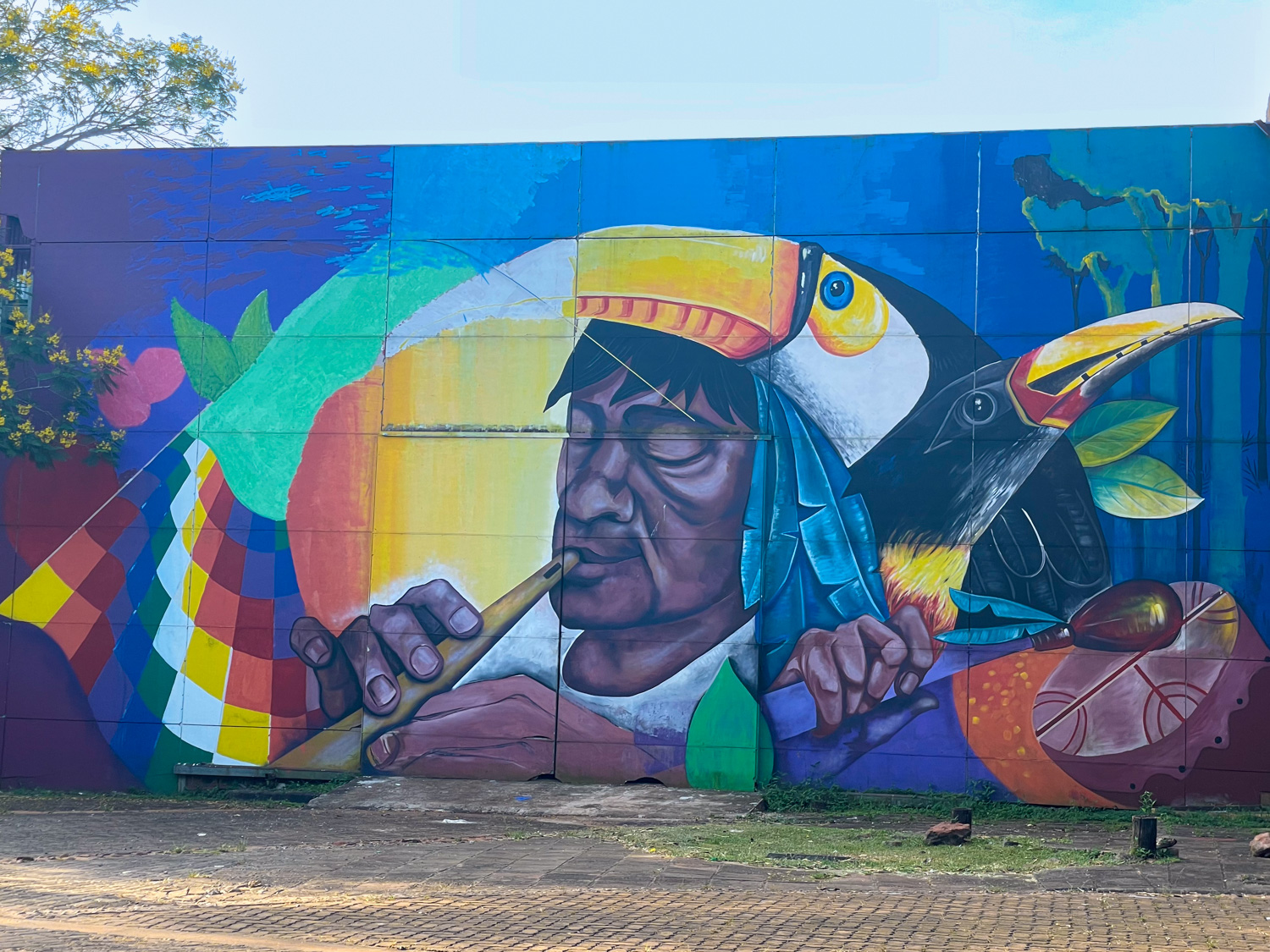
The Brazilian equivalent of Puerto Iguazu is Foz do Iguaçu, and the two towns separated by just 10 kilometres, or six miles. It takes 20 minutes to drive from one to the other — but of course, you do have a border to cross in the middle.
You’ll want to be up early today, because much like yesterday, we want to be at the entrance to the park by opening time. On the Brazilian side of Iguazu Falls, the park opens at 9 a.m. on weekdays, or 8:30 a.m. at the weekends.
What that means is that we need to eat our extravagant breakfast, pack up our bags, and walk into town to catch a taxi to Foz do Iguaçu. Then, we’ll need to drop our bags at the new hotel — I stayed at JL Hotel by Bourbon — and take a taxi to the park entrance — all before nine o’clock.
In other words, we need to get moving.
Working backwards and presuming you’re visiting on a weekday: ideally, you want to be calling a taxi from your Brazilian hotel to the waterfalls by 8:20 a.m., which means checking in to your Brazilian hotel at 8:10 a.m., which means crossing the border at 7:50 a.m., which means you probably want to be having breakfast in Puerto Iguazu at seven.
There’s two options for crossing the border.
If you’re trying to save money, you can opt for the bus. Much like the previous day, you’ll head to the bus station and buy a ticket to Foz do Iguaçu at the Rio Uruguay counter. You’ll pay a couple of dollars for this option, but are taking a risk with the timings: it takes much longer to cross the border this way and the bus could also be delayed. Plus, when you arrive at Foz do Iguaçu bus station, you’ll still need to navigate to your hotel.
I decided to take a taxi to eliminate all of those concerns.
Amazingly, taxis get to skip the line at the border, as they have a dedicated lane just for them. In my opinion, it’s worth taking a taxi just for that privilege. I subsequently managed to cross the border in under five minutes; it was definitely worth the $20 I paid. All up, it took 30 minutes to get from the main street in Puerto Iguazu (where I found a random taxi driver on the street) to my hotel in Foz do Iguaçu.
Where to Stay in Foz do Iguaçu
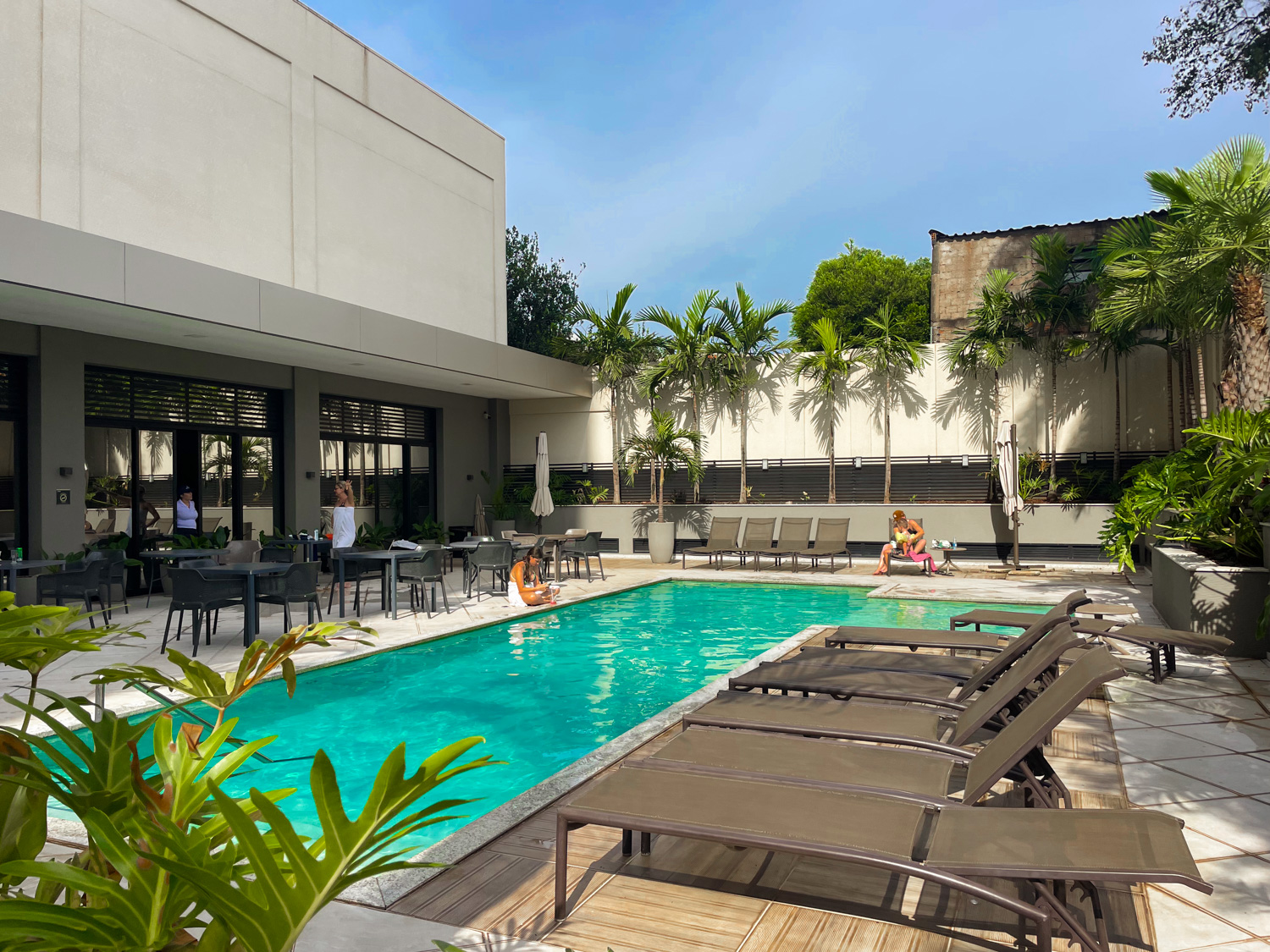
I chose to stay at JL Hotel by Bourbon while I was in Foz do Iguaçu and paid $100 a night. This was for much the same reasons as my Puerto Iguazu hotel: It was the best-rated option in my price range, the swimming pool was much-needed on those hot days, and the breakfast was sizeable and delicious.
The hotel was also centrally located with wonderful staff who were happy to keep my luggage for me when I checked in early. The room was clean, modern, and spacious, and felt like good value for money.
But What About Hotel das Cataratas?
I mentioned at the end of my Argentina section that there’s a hotel on the Brazilian side that allows you access to the waterfalls outside of park hours. It’s true! The Hotel das Cataratas gives you access to what is a truly unique experience.
It’s a beautiful five-star hotel and it’s an eye-wateringly expensive hotel at a price of $800 a night. But I do think that if your budget allows, this is going to be a worthy way of spending it. The reviews are pretty much all in agreement that it’s the best hotel they’ve ever stayed in. And it’s the only way that you can see Iguazu Falls outside of park opening hours.
To see them at sunset? Or sunrise? Or to stand in front of the Devil’s Throat and have nobody else around you? It turns out you can put a price on that.
How to Get From Foz do Iguaçu to Iguazu Falls
Good news! Foz do Iguaçu does have Uber, so that makes getting around so much easier. Because I was worried about getting to the waterfalls on time, I opted to do this. It was just $10 for the 20 minute ride to the park entrance.
You could, of course, take the bus to the waterfalls instead. The bus station is called Terminal de Transporte Urbano on Google Maps, and buses leave from there every 30 minutes. You’ll want to take the 120 bus, which costs roughly $1 and takes half an hour to get there.
I’d only take the bus if you’re travelling on a tight budget or spent the night in Foz do Iguaçu (so have plenty of time to spare).
A Guide to the Brazilian Side of Iguazu Falls
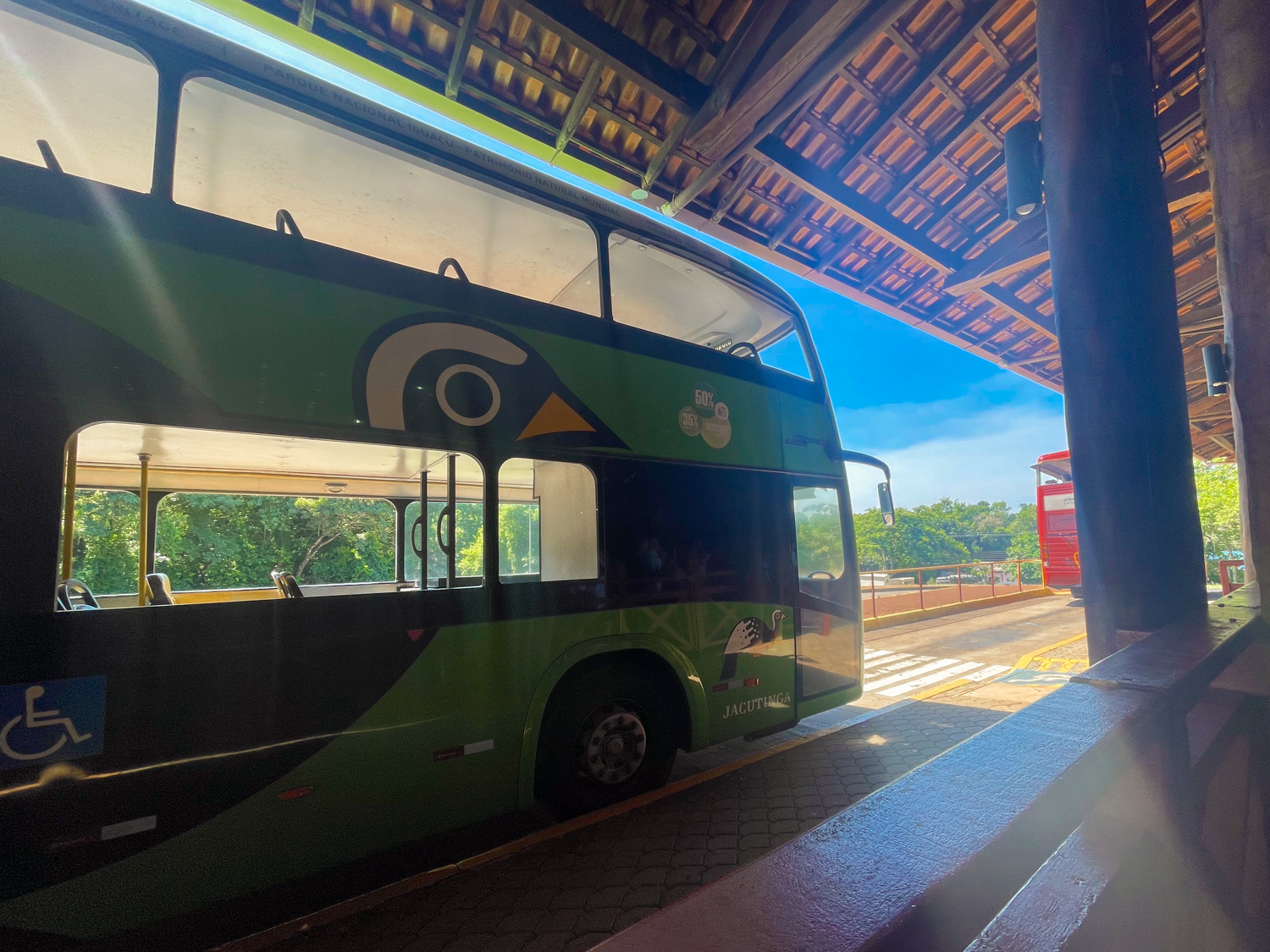
The first thing to keep in mind is that the Brazilian side of Iguazu Falls is much smaller than its Argentinian equivalent. I actually hadn’t been aware of this before I arrived, so I was happily racing from viewpoint to viewpoint… and suddenly I was at the end, 90 minutes after arriving.
I was bit like… wait, is that it?
Because of this, I want to stress that the Brazilian experience is one to savour. There’s not very much to cram in to your itinerary today, so if you want to make a full day of it, you’ll have to go slow.
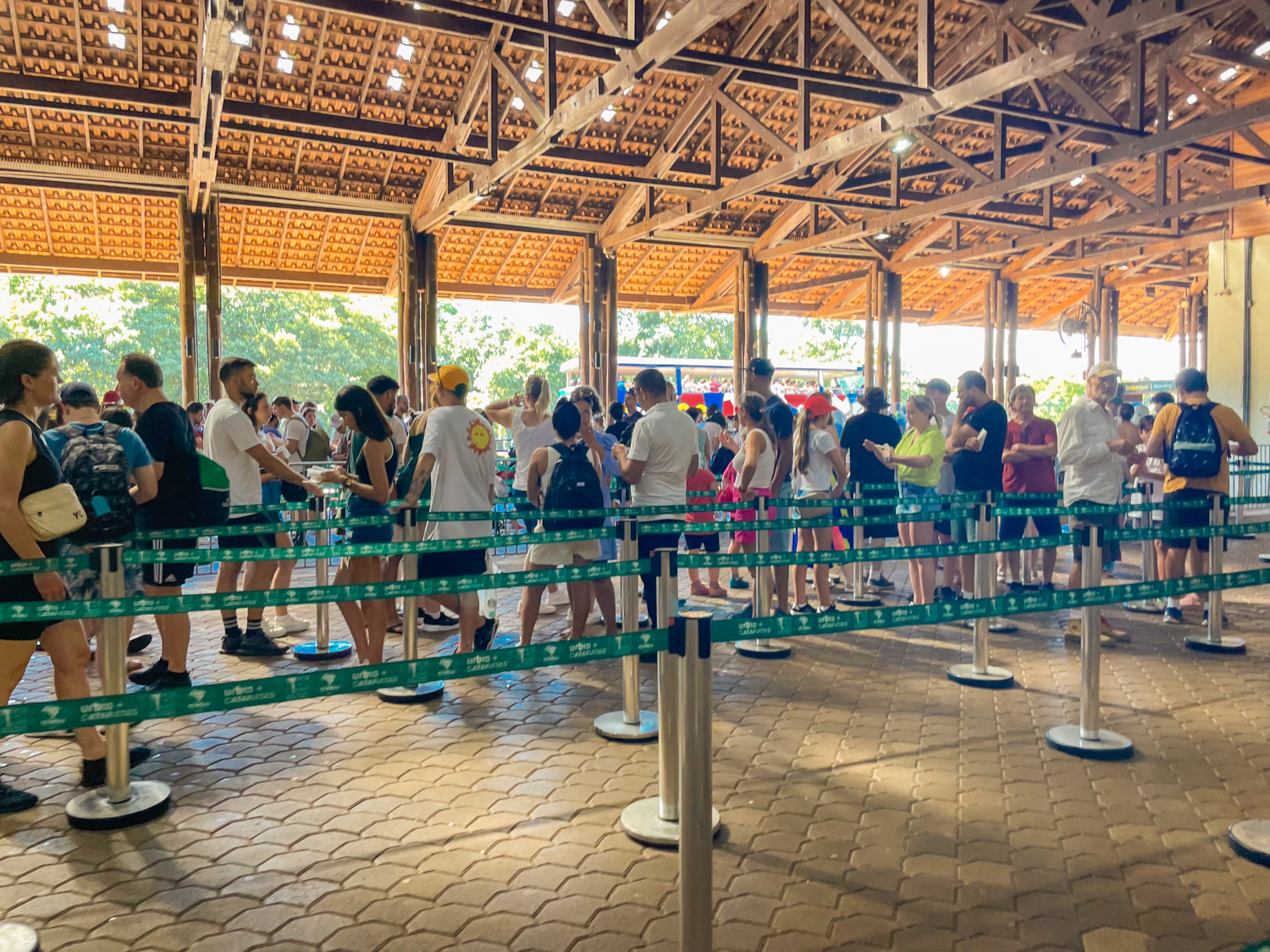
Brazil’s version of the park felt very different to the Argentinian side. In fact, it had a distinct Disneyland vibe to it all.
Upon entering the complex, you’ll join a queue for a double-decker bus that shuttles you to the start of the waterfalls. Again, this is a situation where you ideally want to be at the park entrance before it opens. I, unfortunately, got to the park 10 minutes afterwards and there were already a solid hundred people in the queue in front of me.
It meant that I didn’t get to experience that special solitude from the day before: my third mistake of the trip!
Shuttles run frequently from the entrance — every couple of minutes another bus swings through — so you fortunately never have to wait too long to board.
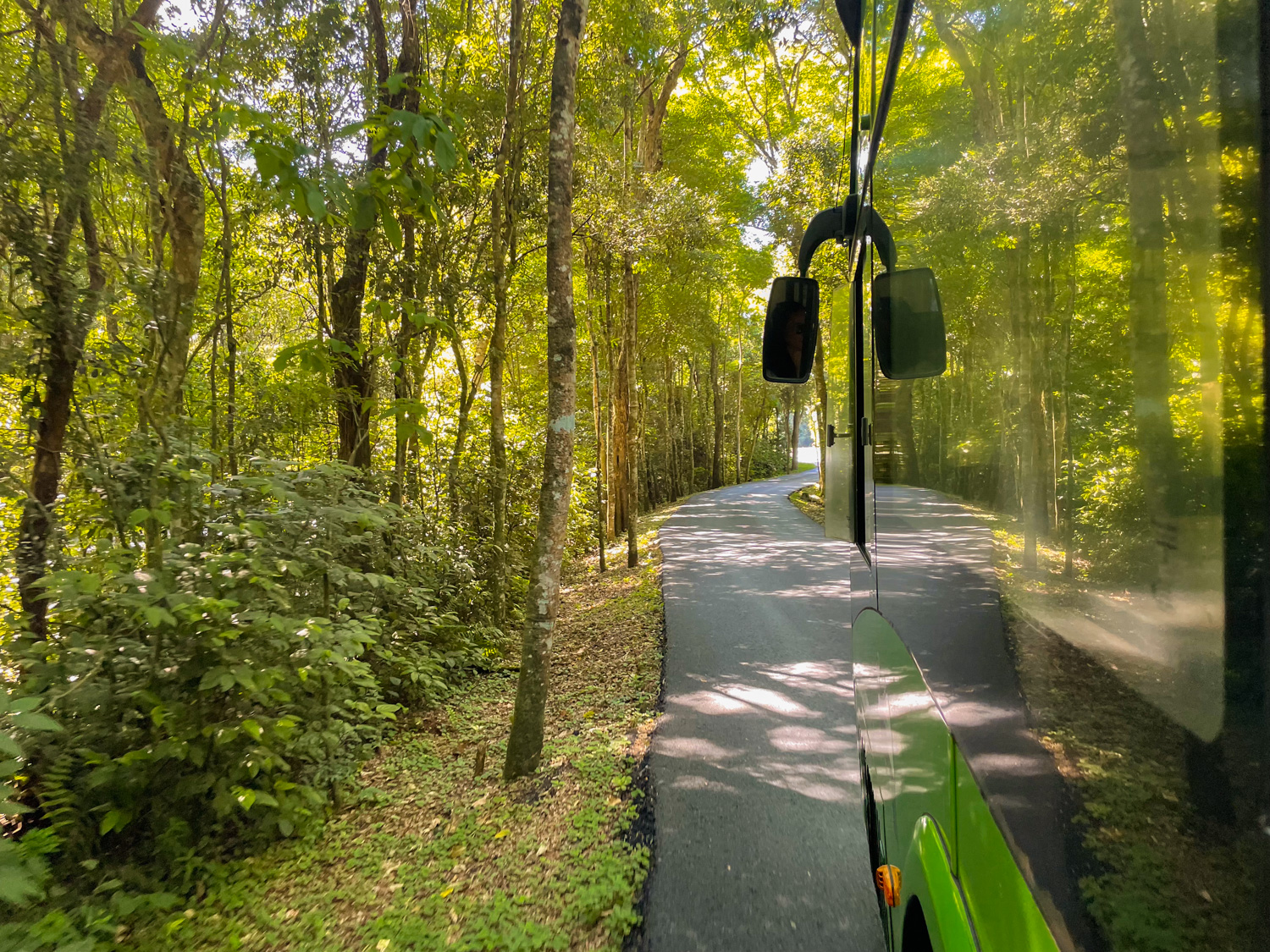
Once seated, you’ll spend the next 20 minutes making your way to the start of the walkway that runs parallel to Iguazu Falls. And it’s true: on the Brazilian side, there is just one walking trail and it stretches for a distance of 1.5 km, or one mile.
I get that I’m not really selling the Brazilian side to you guys right now — I mean, a one-mile path? Is it really worth the effort?
Despite its diminutive size, though, I do think that the Brazilian side of Iguazu Falls offers a completely different perspective to the Argentinian one.
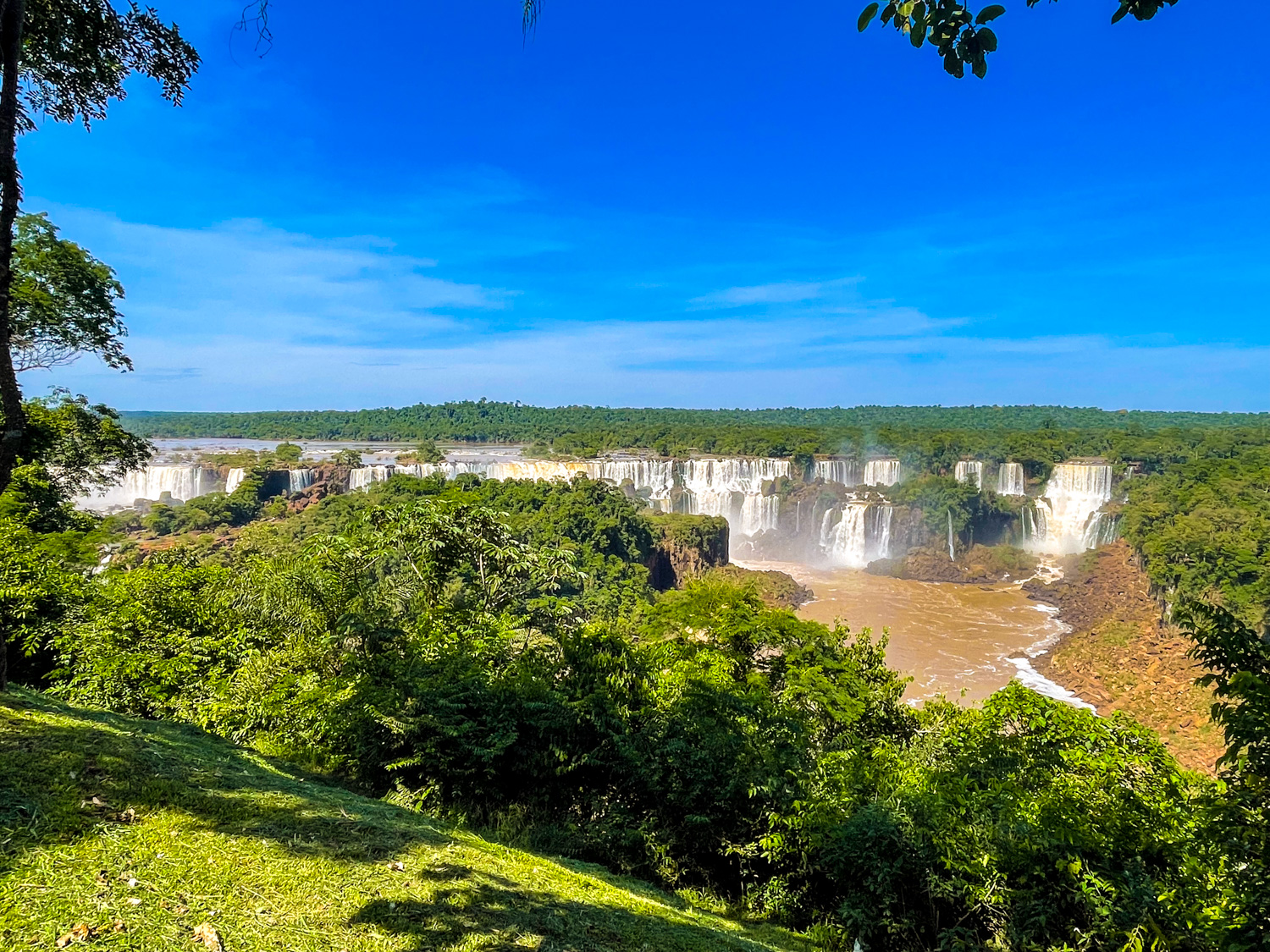
In Argentina, you’re either walking on top of the falls or walking towards them, and the angle of the walkways means that you can never quite see every single one of the 275 waterfalls.
But on the Brazilian side, you get to see them all. Because you’re looking into Argentina, which is home to 80% of the waterfalls, you can paradoxically see much more than you can while you’re in Argentina.
I also only saw rainbows on the Brazilian side.
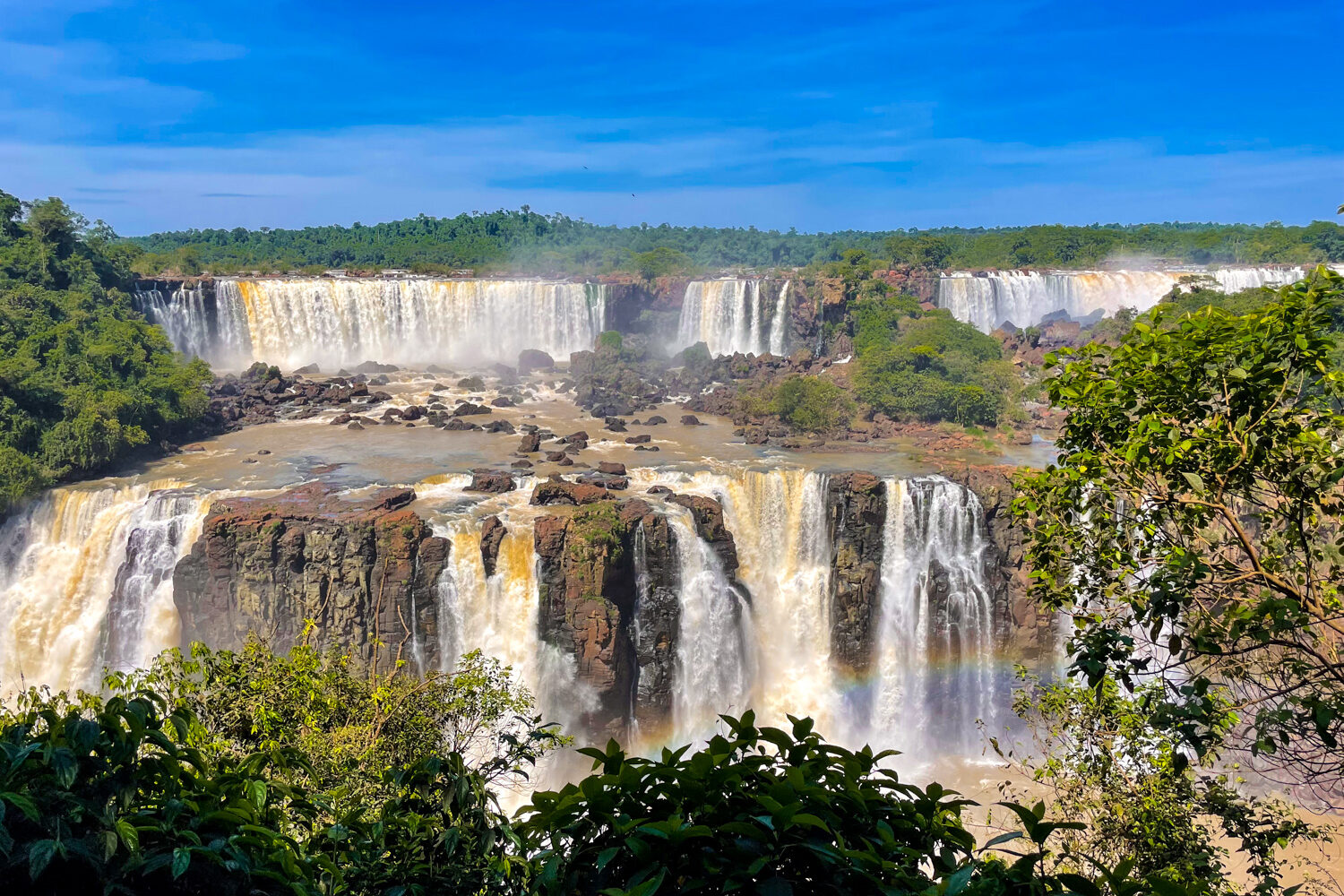
The walkway is dotted with viewpoints and photo spots and there were often queues that were 30 people deep. (That’s mostly because I hadn’t arrived at opening time.)
You’ll walk parallel to the Argentinian side — the river acts as the border between the countries — getting a close-up angle of all the waterfalls you wouldn’t have been able to see on the previous day.
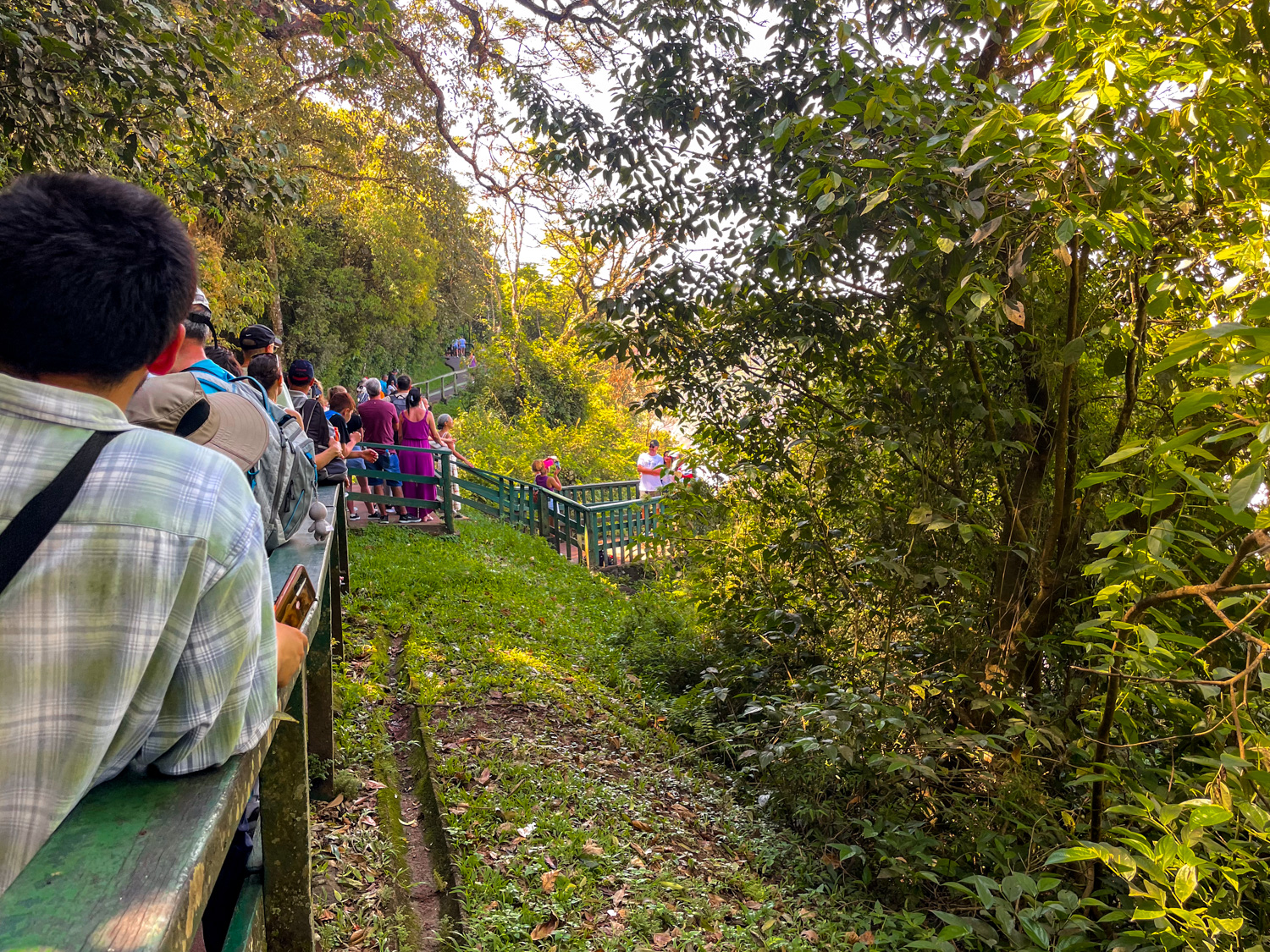
The main attraction of the Brazilian side comes at the very end. The Devil’s Throat. Yes, this is the exact same Devil’s Throat that’s currently closed on the Argentinian side!
Well, in Brazil, you can get up close to it from a completely different angle. In fact, you’re able to stroll out on a walkway that takes you right up to the waterfall.
With the exception of the speedboat experiences, this is the only part of the park that will get you wet, so wear a raincoat if you’re worried about that.
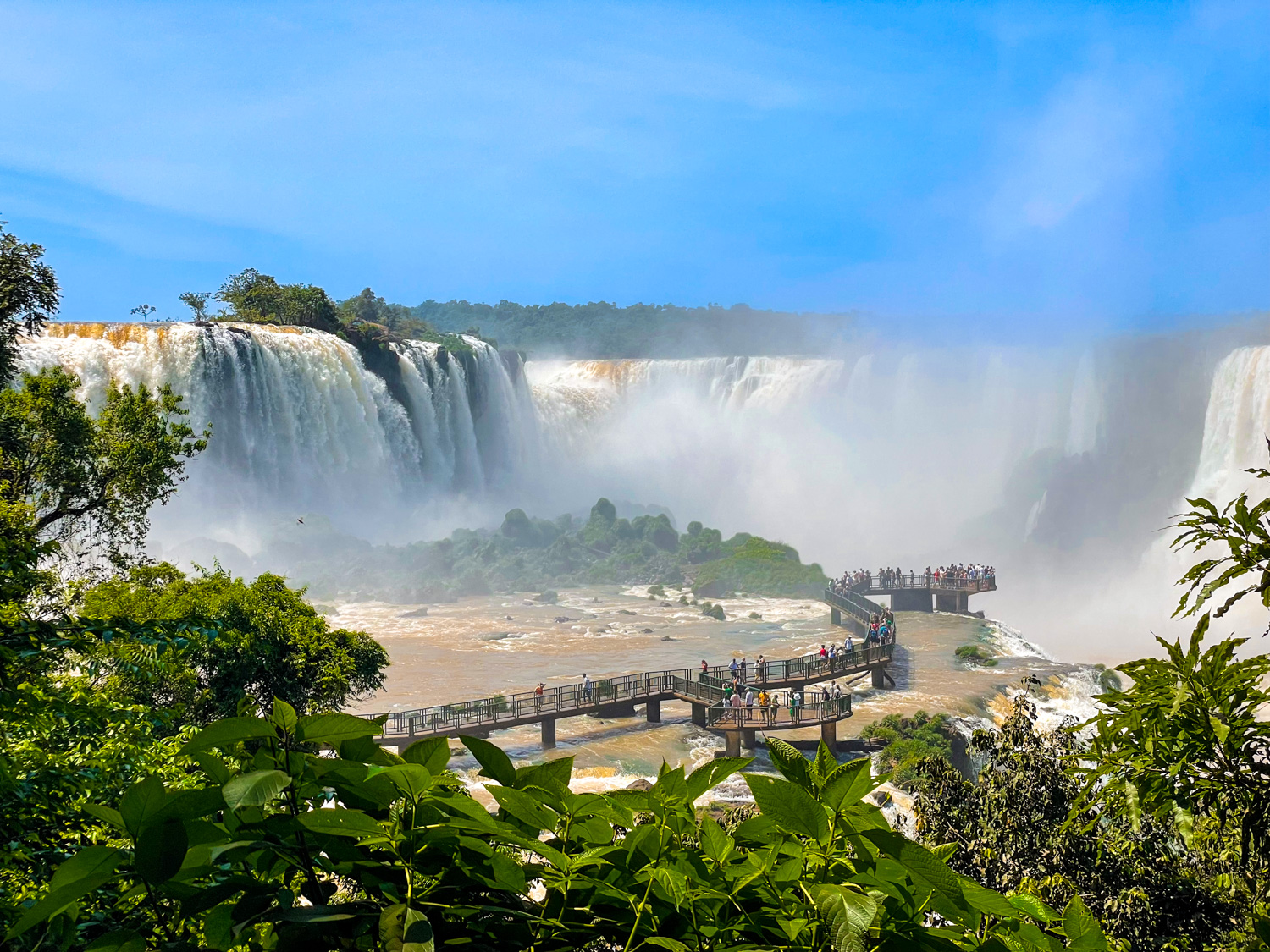
This marks the end of your Iguazu Falls experience, so you’re going to want to savour as much of the experience as you can. As you stride out on the walkway, you’ll be engulfed by a cloud of mist from the dense waterfall on your left-hand side. Ahead of you, the Devil’s Throat.
The waterfalls are so heavy in this part of the park that it can make taking photos a little tricky. There’s so much mist in the air that your camera lens will be perma-damp and visibility will be low. Still, you can’t complain when the views are like these:

How to Avoid the Crowds in Brazil
The Devil’s Throat Walkway was the only part of my Iguazu Falls experience that had me surrounded by hundreds of people. But there is a way to avoid them all.
When the double-decker bus stops at the start point of the walking trail, do not get off.
If you stay on the bus instead, it’ll take you to the end of the walking trail next. This is where the accessible entrance to the Devil’s Throat is located. Hop off the bus here, take the elevator down to the ground floor, and then stride out on to the Devil’s Throat walkway.
You should now have the most popular part of the park all to yourself.
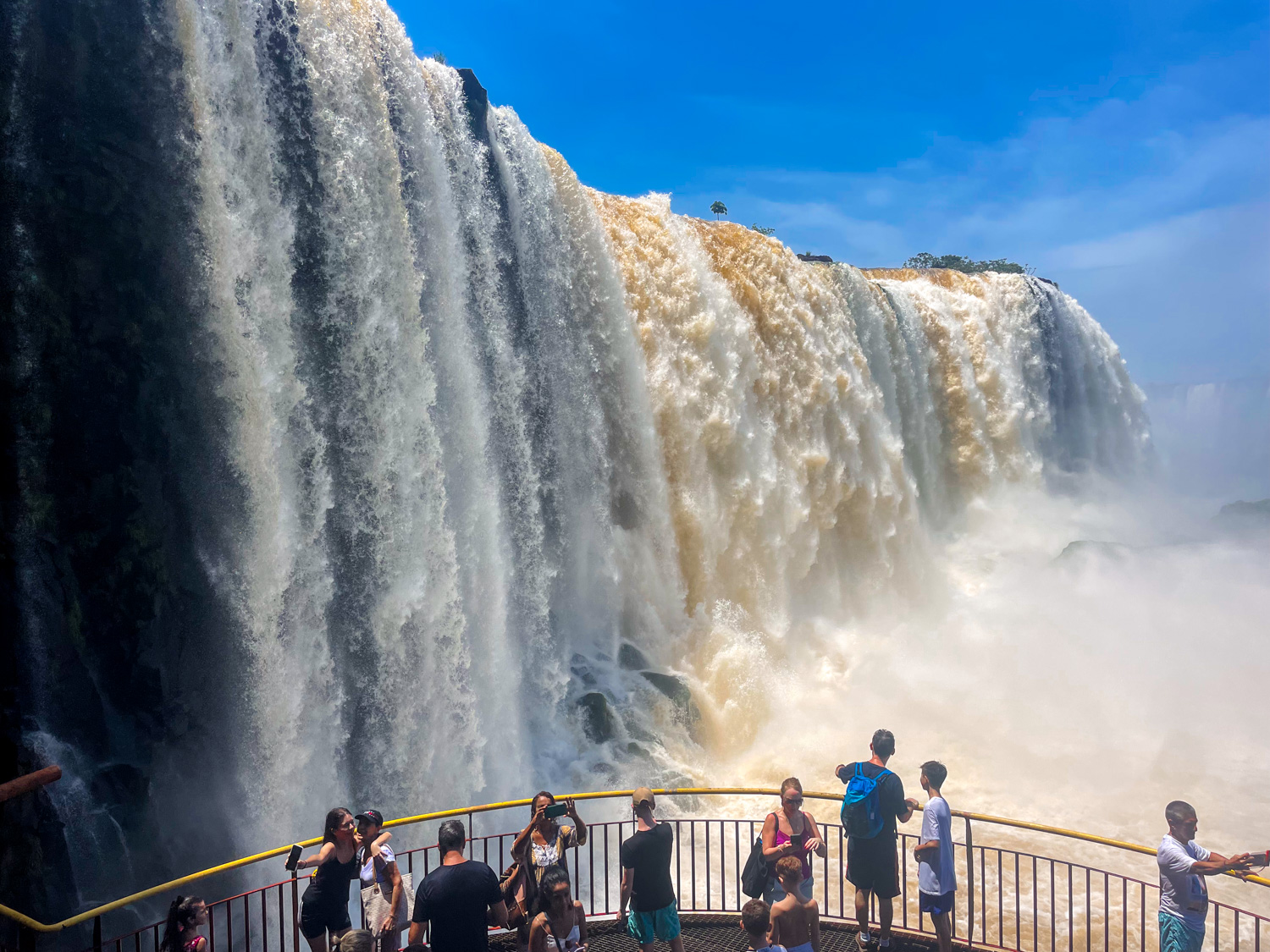
When you’ve finished up on the walkway, spend a few minutes hanging out on the huge viewing platform that’s directly beside a surprisingly aggressive waterfall. I really enjoyed this part of the trail, as it helped give a scale to the behemoth that is Iguazu Falls.
After all, this is just one of the waterfalls. The fact that there were 275 more that were just like this was what was really wild to me.
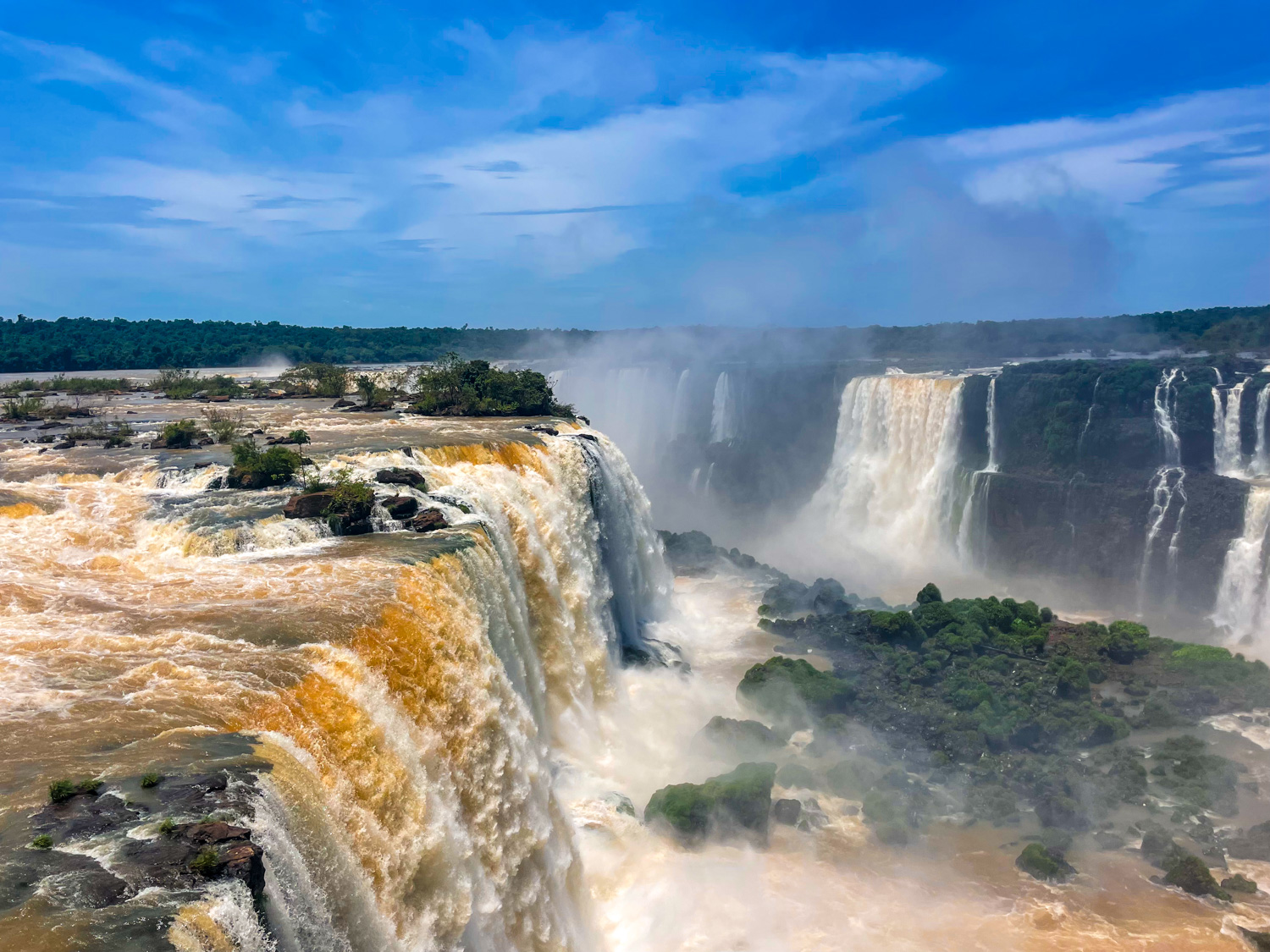
And that’s it. That’s the end of your Iguazu Falls adventure.
Yes, the Brazilian side is much smaller than the Argentinian one, but as you can see from my photos: it’s no less impressive! That’s why I think you’d be missing out if you didn’t go to both sides of the falls.
Should You Take the Speedboat in Brazil, Too?
Brazil does operate a speedboat experience that’s much the same as the one in Argentina. It involves a 20 minute truck-ride through the rainforest and a speedboat that takes you up to the waterfalls.
Personally, I felt so emotionally drained from my speedboat experience on the previous day that I couldn’t quite muster up the energy for a second go-around.
If you’re looking to spend more time in the park, though, or want to experience as much of Iguazu as possible, this is definitely the best way to do so.
If you only want to sign up for one speedboat experience, though, the general consensus is that the Argentinian one is best. It takes you to more falls than the Brazilian one while also propelling you further under the water. The Brazilian one is relatively more relaxed.
Should You Take a Helicopter Ride Over Iguazu Falls?
The Brazilian side of the falls is the only one to offer a helicopter ride over Iguazu. You’ll pay roughly $150 for a 10-minute flight. It’s definitely expensive, but it’s also the only way to see the entirety of Iguazu Falls from above. It’s yet another perspective of this natural world wonder and, well, you might only be here once. Will you regret skipping it in the future?
There is one problem with the helicopters, though. The Argentinian park has actually banned helicopter rides because they disrupt the fragile ecosystem. Specifically, the loud noises often scare the birds and native animals who call this area home.
On the scale of unethical-things-we-do-while-traveling, I don’t think this is the most egregious activity you can do. It may be enough to dissuade you from signing up for it, though.
Is it Worth Visiting the Brazilian Bird Park?
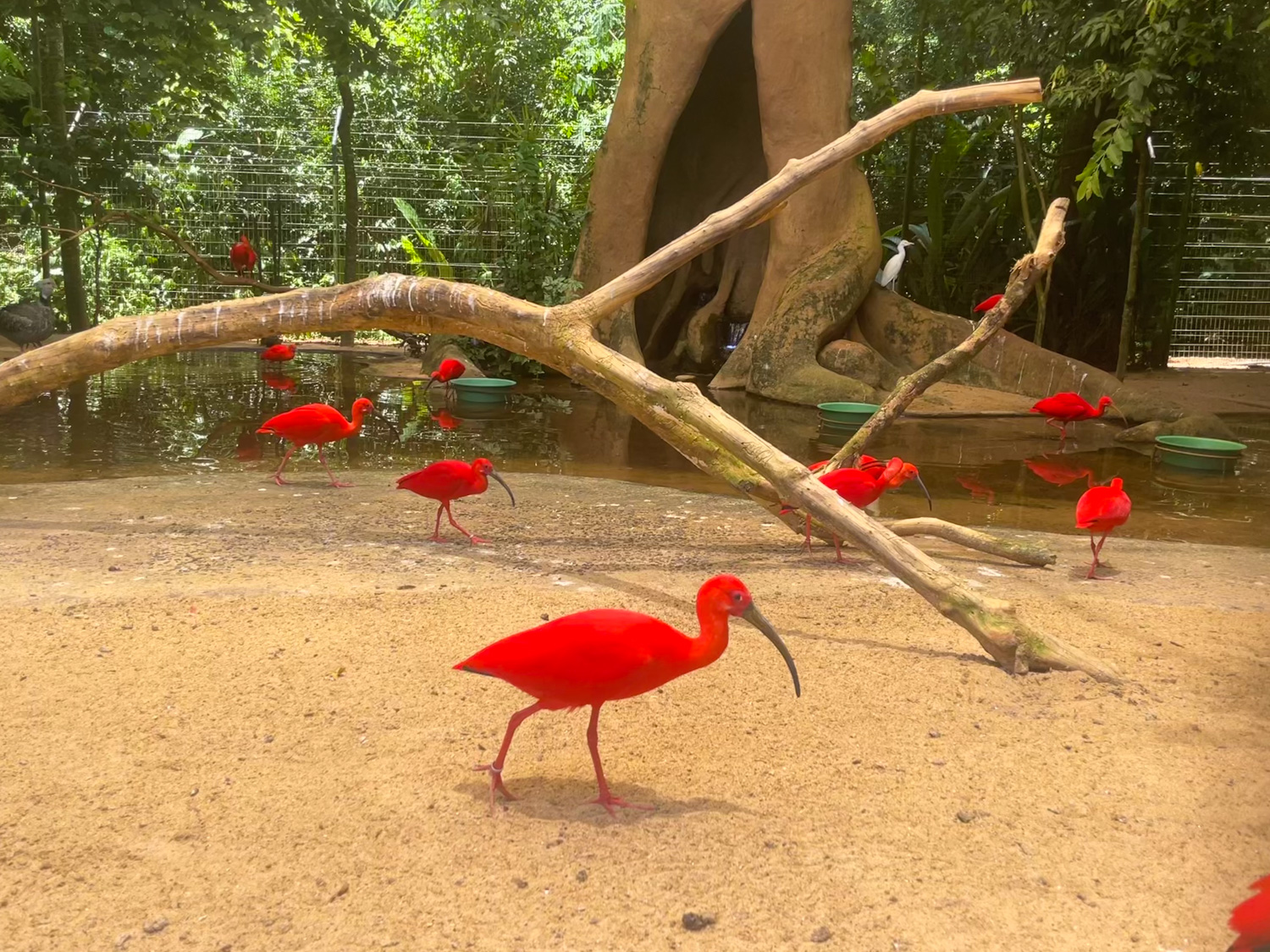
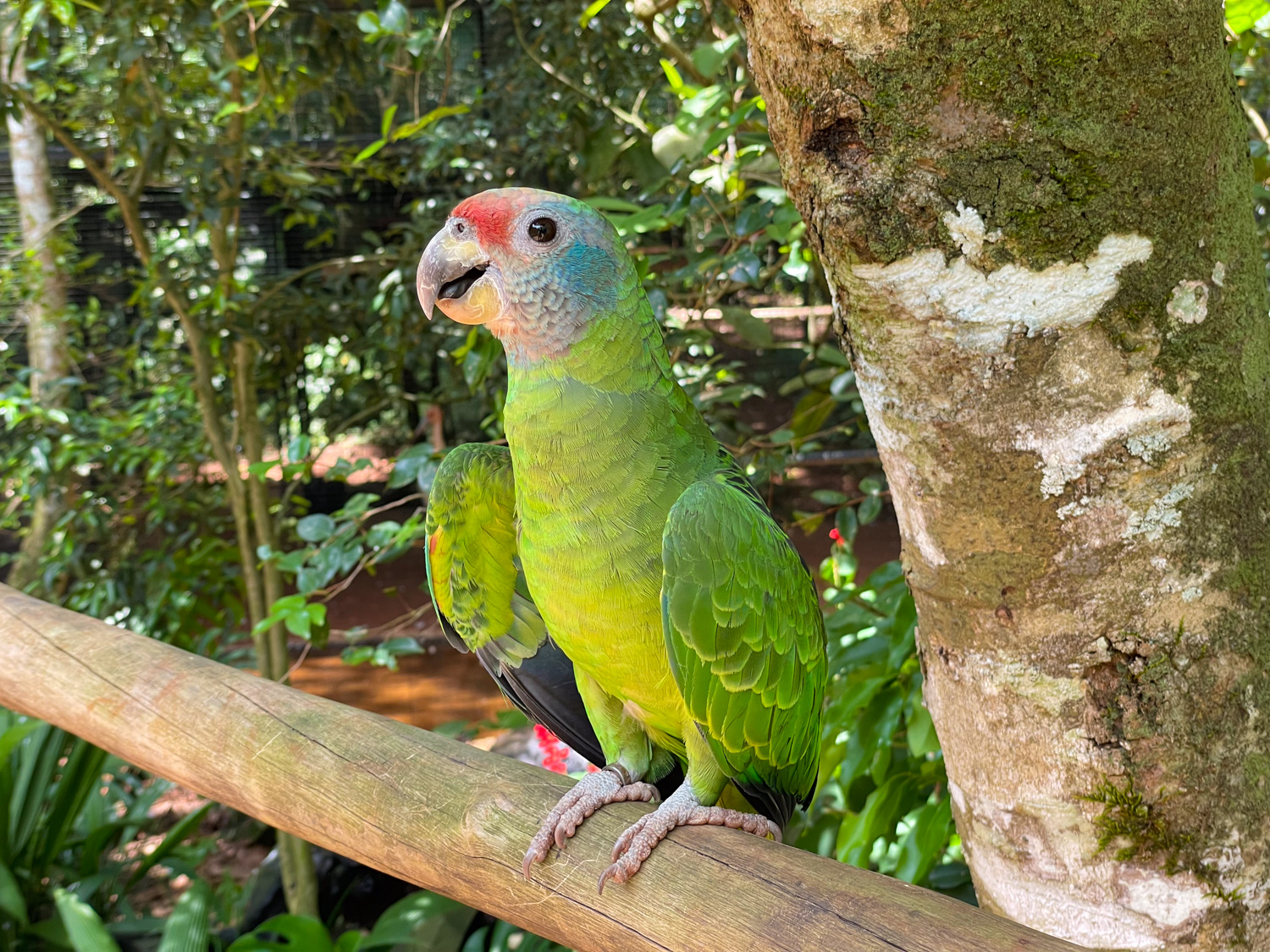
Parque das Aves — the Bird Park — is located directly opposite the entrance to Iguazu Falls, so the vast majority of visitors to the area opt to do both. I was no different: I love birds — especially funny-looking ones — and I had nothing else to do with my day.
I spent 90 minutes making my way around the park. The trail leads you from one enclosure to another, introducing you to different bird species from the world. The big draw here is the local toucans, but my absolute favourite is pictured above: the bright-red ibis. If you’re Australian, yes! That really is a red bin chook.
I had lunch at Parque das Aves and that was a great regret of mine. You should be done with the waterfalls and bird park by around lunchtime, so I recommend heading back to Foz do Iguaçu to eat instead.
And there you have it: that’s how to spend two days at Iguazu Falls.
Could You See Both Sides of Iguazu Falls in One Day?
Yeah, you could actually do so quite easily.
Start off in Argentina, check off the upper and lower trails, then aim to get the 12:45 p.m. speedboat. You’ll be finished with that by 2:45 p.m., which gives you just under two hours to get across the border and to the Brazilian side of the park (it shouldn’t take more than an hour to travel from one to the other). The Brazilian side halts entry at 4:30 p.m. but closes at 6 p.m.; you should be able to see the waterfalls there in an hour — too easy!
In theory.
Obviously if you skipped the speedboat, you’d definitely be able to see both in a single day.
I do think that you’d have a much more enjoyable, and less stressful, experience if you split it across two days, but if you’re short on time, it’s definitely doable.
Can You Visit Iguazu Falls as a Day Trip?
It’s a lot easier to do so from Argentina.
The earliest flight out of Buenos Aires is at 5:55 a.m., which gets you to Puerto Iguazu at 7:45 a.m. From the airport, you can take a 30 minute taxi to the park entrance and be there by 8:30 or so. There’s plenty of evening flights back to Buenos Aires, too, ranging from a 8 p.m. to 11 p.m. departure time.
From Rio de Janeiro, the flight times aren’t as favourable. In fact, the earliest flight gets you in at midday while the latest flight back leaves at 5 p.m. You technically could fly in and spend three hours at the Brazilian Iguazu Falls — the airport is beside the park entrance — before turning back around again, but it would be a particularly unhinged way of travelling.
Should You Take a Guided Tour of Iguazu Falls?
No.
I don’t think so.
I don’t see why you would need to.
I rolled my eyes, in fact, when I was reading other travel blogs and they stated the parks were overwhelming and confusing, so it’s best to take a tour (which earns them a commission, of course). Like, it’s literally one trail that you follow for a mile; there is nothing overwhelming and confusing about it!
It’s so easy to navigate the two individual parks that it’s impossible to get lost while you’re there. And even crossing the border is a piece of cake, so you don’t need anybody to help you with that.
The only reason, I guess, to take a tour is if you’re looking to learn more about the natural environment from a local expert, or if you’re a solo traveller who’d like a tour guide to help take photos of them.
Over than that, though, I really don’t think it’s necessary.
How to Visit Paraguay Too! …And Should You?
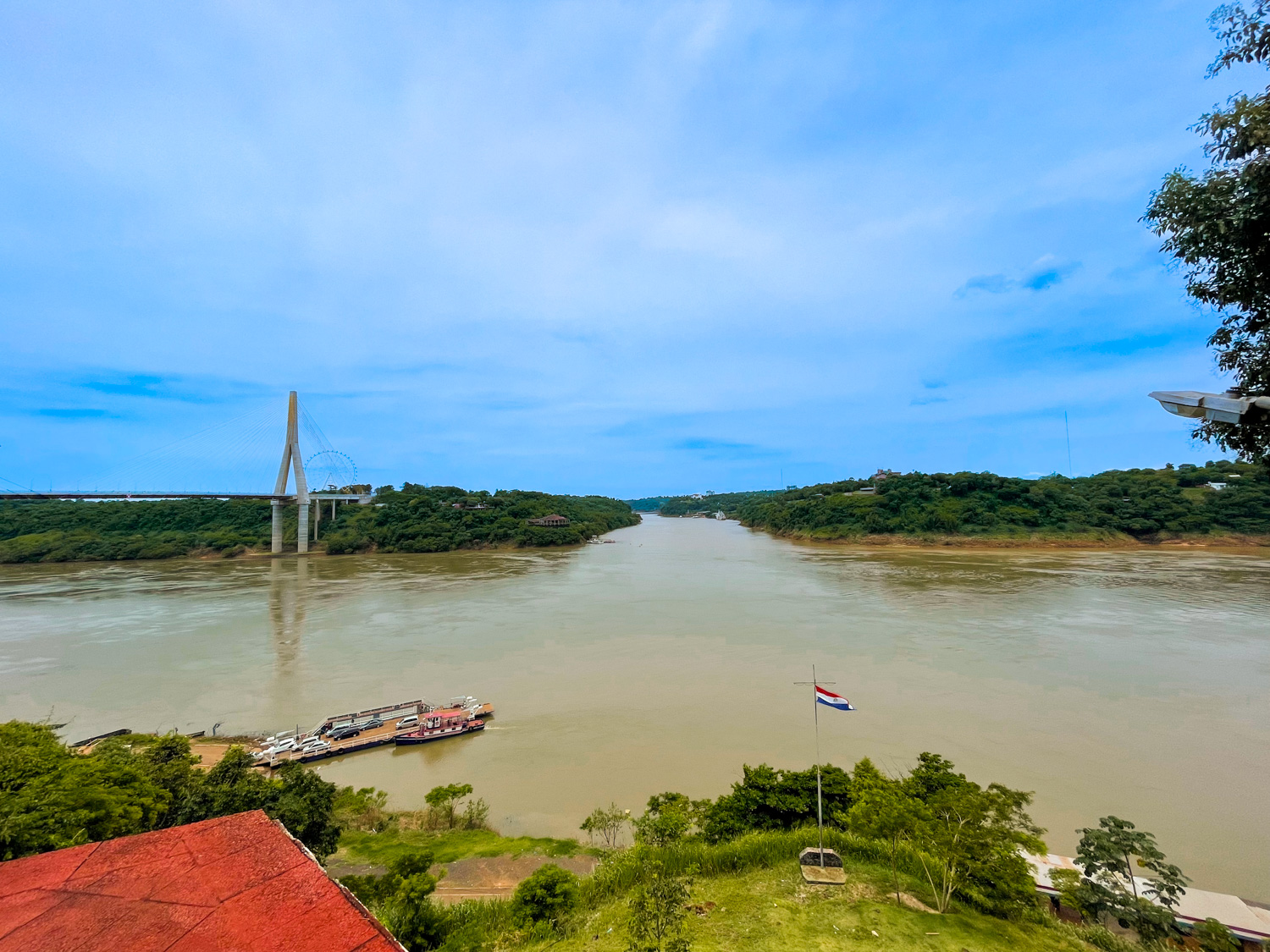
For country counters motivated travellers like me, there’s a certain allure that comes from knowing you’re a twenty minute walk from a brand new country.
It’s true: the bridge in my photo above is located on the western reaches of the Brazilian town of Foz do Iguaçu. Entering Paraguay is as simple as walking out of your hotel, crossing the bridge, and arriving in Ciudad del Este. They don’t even check your passport when you do so!
As tempting as it may be to do exactly that, there’s one big problem.
Ciudad del Este sucks.
I think every single person who has been to Paraguay would agree that it’s the worst place in the country.
Ciudad del Este is home to one of the world’s largest tax-free markets. It’s here where contraband, counterfeit goods, and cartels blend together; where you can encounter the trafficking of drugs, weapons, and even children. It’s a grim, seedy place, with poker machines lining the streets and guards with shotguns manning the storefronts. And yeah, you can buy anything you want there.
I was so keen to take a look around Paraguay but I just could not bring myself to do it in this way. Ciudad del Este sounded awful and the multitude of shopping-themed tours online were the exact opposite of what I wanted to do.
I spent hours researching before determining that Paraguay and me were not meant to be.
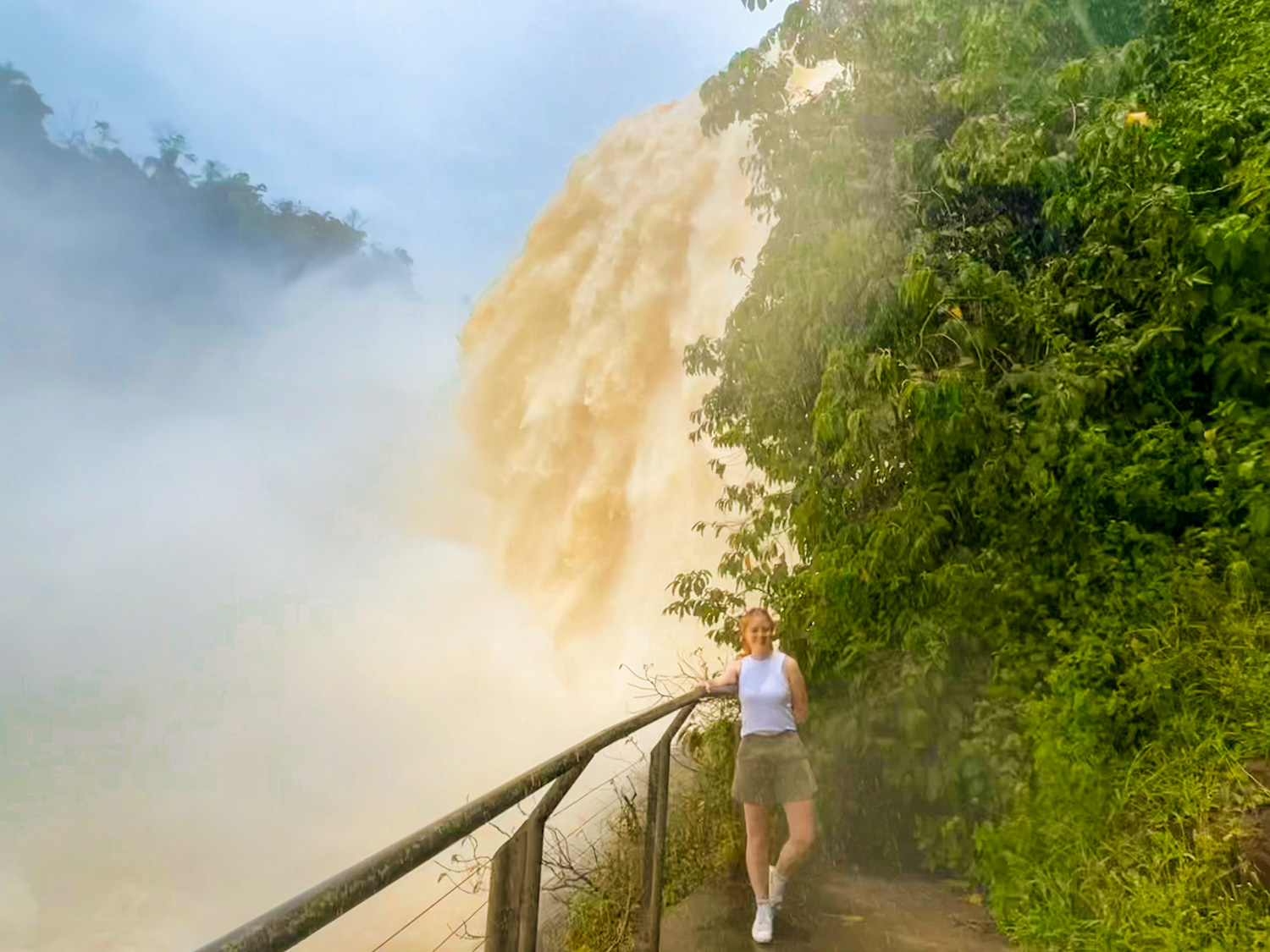
But then, I did find one tour.
Just one.
One that takes you everywhere but the shopping district of Ciudad del Este.
It was a small-group tour called the Paraguay Experience, and it whisks you away to all of the best parts of this region of the country. My tour lasted for nine hours in total and I had such a great time!
The tour guide, Bruna, was lovely and so passionate about Paraguayan culture; she decided to set up this tour because she hated seeing that tourists were all being taken to the worst parts of the country she loves. She wanted to show them that Paraguay is so much more than a tax-free shopping haven.
On our tour, we had her dad driving us around and her son in the back, practicing his English, so it felt like we were part of her family; there were four guests taking the tour in total. And we drove all over the place!
We visited ITAPU Dam, an absolute behemoth — the third-largest dam in the world — that was voted one of the Seven Engineering Wonders of the World. It was actually super-fascinating to get up close to it and see just how enormous it was.
We visited Saltos del Monday, which is pictured above: had I not been to Iguazu Falls for two days running before standing here, I’d have named it the most impressive waterfall I’d ever seen!
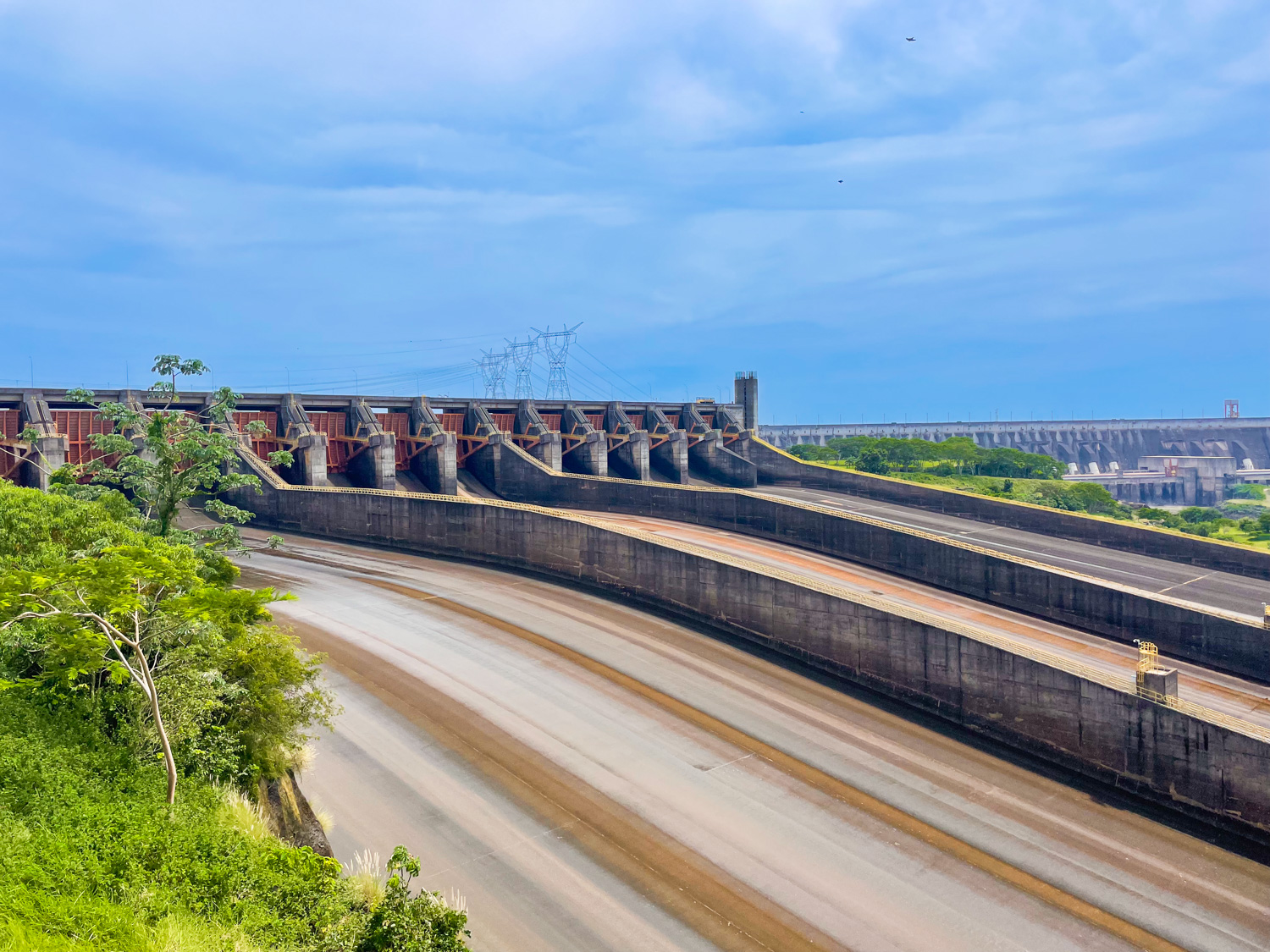

A highlight for me was stopping off for lunch in a little local restaurant and getting to try multiple Paraguayan dishes. My favourite was chipa — a type of cheese-filled bread that’s made from cassava flour and anise.
We stopped in at the local museum, where we had a private tour of the exhibits and learned all about Ciudad del Este’s history; our guide even gave us a bag of local mate as a gift!
We finished it all off by visiting the tripoint of Argentina, Brazil, and Paraguay.
Needless to say, I wholeheartedly believe this is the best way to see Paraguay as a day trip. I don’t think it’s worth visiting Paraguay if the only part you’ll see is Ciudad del Este; you’re not going to enjoy it.
And That Was Iguazu Falls!
Well, I didn’t quite expect to write 10,000 words on how to best explore Iguazu Falls. I feel like I’ve essentially just published a guidebook! I guess I had a lot to say.
And so, I’ll keep my ending short: Iguazu Falls is amazing and I hope you have the best time exploring it.
Let me know if you have any questions in the comments! :-)

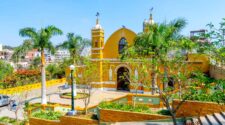

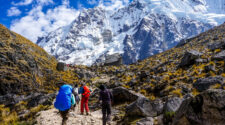
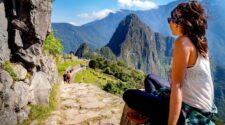
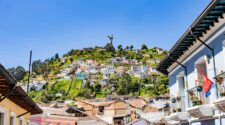
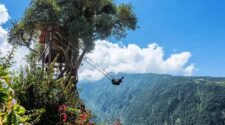
Wow, what a detailed, excellent write-up!
Thanks so much for reading, Scott! It’s definitely detailed, hahaha.
Lauren, This is the BEST description I’ve ever read about how to visit Iguazu EVERYONE who visits the falls should read this first, it will save them tons of time and make sure they get the very best experience possible. The only tip I’d add is that if one can afford it staying on the Brazilian side at the Belmond Das Cataratas is a really special experience. We are normally budget travelers and I have not compensation from the hotel in any way, but it was a wonderful stay. It’s expensive, for sure, but it’s the only hotel actually in the park and staying there lets you easily visit the trails and falls early at sunrise and late at sunset, which are very special times to see them and without other people. Plus, the hotel has a lovely pool, excellent restaurant, beautiful grounds, and super nice rooms. For a rare splurge, if you can afford it we recommend it. Finally, you’re absolutely right that the JET BOAT TRIP IS A MUST DO!! Thanks for the great travel report. We’ll follow you from here